
STORIES FROM HAWAIIAN AIRLINES
V25 N 0 5 OCTOBER - NOVEMBER 2022
JUS’ CRUISIN’ The people you meet on the North Shore Bike Path THE HUNTSMAN Justin Lee is a master of bow and spear THE SCIENTIST AND THE VILLAGE Protecting the reefs of Miloli‘i
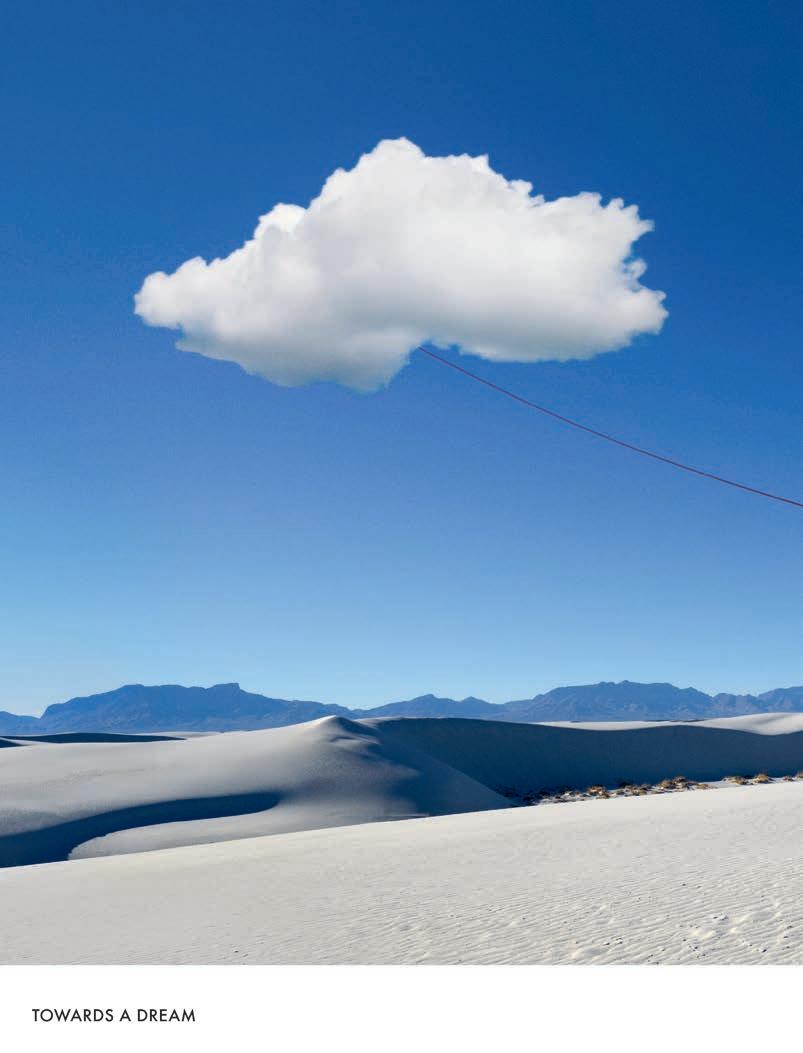


16 / In Hidden Color
STORY BY KATHY MUNENO
PHOTOS BY FERESA CABRERA
18 / Mekia’s Martin
STORY BY DEREK FERRAR
PHOTOS BY DANA EDMUNDS
20 / Big Picture Guy
STORY BY CATHARINE LO GRIFFIN
PHOTOS BY ARTO SAARI
22 / On Borrowed Tools
STORY BY MARTHA CHENG
PHOTOS BY LILA LEE
24 / The Food of Love
STORY BY MALANIE MCLELLAN
PHOTOS BY MICHELLE MISHINA 26 / Leaving Souvenirs
STORY BY DW GIBSON
PHOTO BY ELYSE BUTLER
DEPARTMENTS & FEATURES
30 / The Fisher King Whether on land or at sea, Justin Lee has mastered the art of catching dinner
STORY BY LUKE WAIKS
PHOTOS BY PERRIN JAMES
42 / The Sound of Ancient Water Maui’s Kahoma Stream returns to its natural course
STORY BY SHANNON WIANECKI
PHOTOS BY AMANDA BEENEN CANTOR
52 / Reclaiming Pā‘ula‘ula
The deeply Hawaiian story of Kaua‘i’s “Russian fort”
STORY BY PETER VON BUOL
PHOTOS BY MIKE COOTS
62 / Science of the People
For environmental scientist Greg Asner, research only confirms what Native people have long understood
STORY BY MEGHAN MINER MURRAY
PHOTOS BY ANDREW RICHARD HARA
74 / Country Road
Cruising the North Shore Bike Path
WORDS BY BEAU FLEMISTER
PHOTOS BY ARTO SAARI
86 / House of the Caretakers
Na Aikane o Maui preserves Lāhainā’s past and present
STORY BY KATHY MUNENO
PHOTOS BY JACK WOLFORD
96 / One for the Team Hawai‘i’s best young surfers go for gold at the Junior World Championships
STORY BY ERIC STINTON
PHOTOS BY PABLO FRANCO

106 / Events Calendar & Island by Island 127 / Hawaiian Airlines
144 / PAU HANA Where the Streets Have Long Names
STORY BY LARRY LIEBERMAN
PHOTO BY ERIKA RICH
Information
ISLAND
INTELLIGENCE
Table of Contents V25 N 0 5 OCTOBER - NOVEMBER 2022 02
74

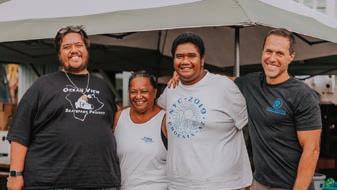
THE SCIENTIST AND THE VILLAGE / To Greg Asner, cutting-edge Western science is telling the people of Miloli‘i what they already knew. PHOTO BY ANDREW
RICHARD HARA

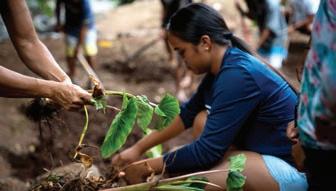
BACK IN THE FLOW / Returning Maui’s Kahoma Stream to its natural course is both restoring an ecosystem and rejuvenating a community.
 MEKIA’S MARTIN / Learn how the most popular acoustic guitar style in the world—the Martin Dreadnought—traces its roots to early twentieth-century Hawaiian music.
PHOTO BY MEGAN SPELMAN
PHOTO BY AMANDA BEENEN CANTOR
ALOHA GOES BOTH WAYS / A video series exploring locals who embody the aloha spirit both at home and afar.
MEKIA’S MARTIN / Learn how the most popular acoustic guitar style in the world—the Martin Dreadnought—traces its roots to early twentieth-century Hawaiian music.
PHOTO BY MEGAN SPELMAN
PHOTO BY AMANDA BEENEN CANTOR
ALOHA GOES BOTH WAYS / A video series exploring locals who embody the aloha spirit both at home and afar.
04 tv Find more hana hou! videos, stories and events on nmgnetwork.com Instagram: @hanahoumag Facebook: /HanaHouMagazine
PHOTO BY JOSH LETCHWORTH

PUBLISHER & CEO
Jason Cutinella
VP BRAND DEVELOPMENT
Ara Laylo
GLOBAL EDITORIAL
DIRECTOR
Brian McManus
EDITOR
Michael Shapiro
PHOTO EDITOR
Matt Mallams
DESIGNERS
Nico Enos
Taylor Niimoto
Eleazar Herradura
VP FILM
Gerard Elmore
FILMMAKERS
Blake Abes
Romeo Lapitan
Erick Melanson
VIDEO EDITOR
Jhante Iga
STUDIO DIRECTOR
Kaitlyn Ledzian
BRAND PRODUCTION COORDINATOR
Taylor Kondo
OPERATIONS
PARTNER/GM —HAWAI‘I
Joe V. Bock
VP ACCOUNTS RECEIVABLE
Gary Payne
CREATIVE SERVICES MANAGER
Sheri Salmon
OPERATIONS MANAGER
Sabrine Rivera
ADVERTISING
ADVERTISING DIRECTOR
Simone Perez simone@NMGnetwork.com
DIRECTOR OF SALES
Tacy Bedell tacy@NMGnetwork.com
VP SALES
Mike Wiley
VP GLOBAL BRAND STORYTELLING
Marc Graser
VP INTEGRATED MARKETING
Francine Beppu
MARKETING & ADVERTISING EXECUTIVE
Courtney Asato
ACCOUNT EXECUTIVE
Nicholas Lui-Kwan
CONTACT
EDITORIAL INQUIRIES editors@NMGnetwork.com
SALES INQUIRIES sales@NMGnetwork.com
CONTRIBUTORS
Peter von Buol
Elyse Butler
Feresa Cabrera
Amanda Beenen Cantor
Martha Cheng
Mike Coots
Dana Edmunds
Derek Ferrar
Beau Flemister
Pablo Franco
DW Gibson
Andrew Richard Hara
John Hook
Perrin James
Lila Lee
Larry Lieberman
Catharine Lo Griffin
Malanie McLellan
Meghan Miner Murray
Michelle Mishina
Kathy Muneno
Erika Rich
Arto Saari
Eric Stinton
Luke Waiks
Shannon Wianecki
Jack Wolford
Published by: NMG Network 36 N. Hotel St., Ste. A Honolulu, HI 96817
©2022 by NMG Network, LLC. Contents of Hana Hou! are protected by copyright and may not be reproduced without the expressed written consent of the publisher. Hana Hou! assumes no liability for products or services advertised herein.
TAHITI (689) 40-866-000
CONSUMER AFFAIRS HawaiianAirlines.com/CAO
BAGGAGE INQUIRIES
1-866-389-6654
Monday-Sunday, 8:00am - 4:30pm HST
H awaiian M iles
For information on our frequent flyer program, please contact our HawaiianMiles Service Center
Monday-Friday, 7:00am - 4:30pm HST 1-877-HA-MILES or 1-877-426-4537
HAWAIIAN AIR CARGO INQUIRIES 1-877-422-2746
3375 Koapaka Street, G-350 Honolulu, HI 96819
Phone: 808-835-3700 Fax: 808-835-3690
Mailing Address: PO Box 30008 Honolulu, HI 96820
For questions related to travel, visit us online at HawaiianAirlines.com or contact us at any of the following numbers:
UNITED STATES / CANADA
1-800-367-5320
Monday-Sunday, 24 hours Text 38285
Monday-Sunday, 5:00am - 11:00pm HST
AUSTRALIA (61) 1-800-955-912
CHINA (86) 10-6502-6766
JAPAN
0570-018-011 Monday-Friday
NEW ZEALAND (64) 0800-449-415
AMERICAN SĀMOA (684) 699-1875
SOUTH KOREA (82) 2-775-5552
HawaiianAirCargo.com
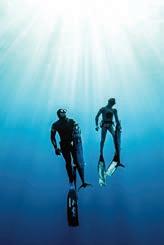
ON THE COVER
Still Life with Sashimi
Justin Lee (left) and Mark Healey return to the surface with a pair of ono they speared off Hawai‘i Island.
PHOTO BY PERRIN JAMES
06 V25 N 0 5 OCTOBER - NOVEMBER 2022
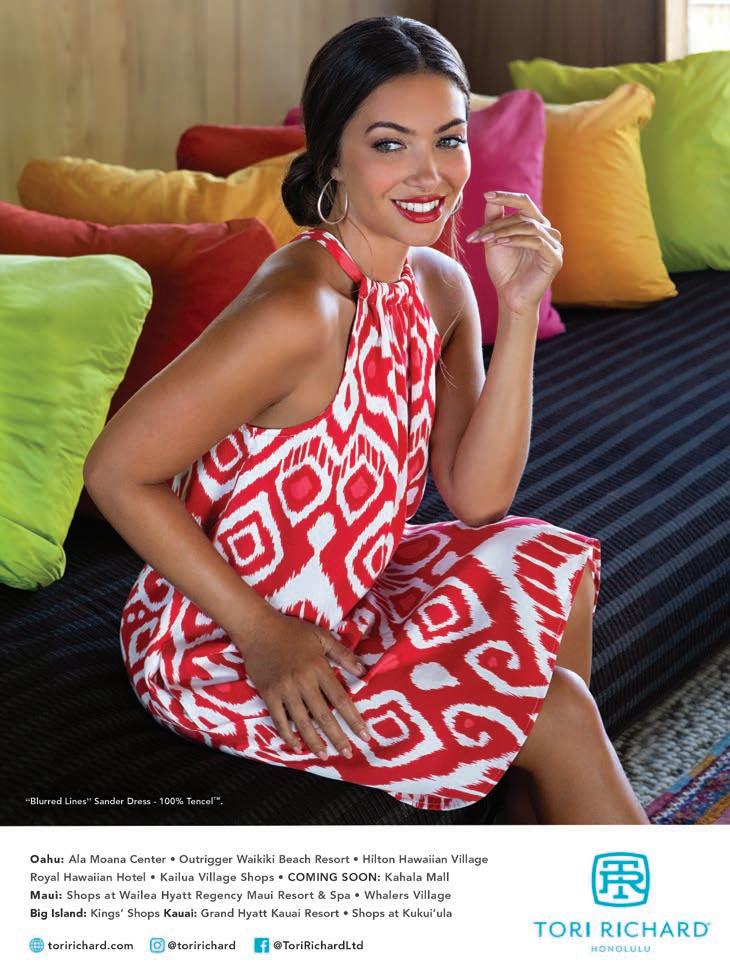
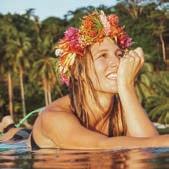
“I live next to a stream on Maui where there used to be a lo‘i [taro patch],” says Amanda Beenen Cantor, who shot “The Sound of Ancient Water” about the restoration of Kahoma Stream for this issue. “It was so inspiring to meet with Archie Kalepa and the families doing this work and to hear their perspective firsthand—why it’s important that the streams keep running and why lo‘i are so important, not only culturally but also for the health of the environment. I came back inspired and have spoken with people in my area about how we might also contribute by caring for the stream in our neighborhood.” Originally from the Netherlands, Cantor moved to Maui in 2017, where she specializes in water and lifestyle photography.

“As a television news reporter, I have loved covering hundreds of stories, but most of the time my reporting is confined to one day,” says Kathy Muneno, who wrote “House of the Caretakers” about Na Aikane o Maui Cultural Center for this issue. “We conduct interviews, write, then it’s edited and aired. But with this story I had the luxury of listening to Sam Kaai and Ke‘eaumoku Kapu’s stories about Lāhainā and its history for hours over a couple of days. The cultural center might be a humble structure, but it’s rich in treasures and knowledge.” A reporter and news anchor in Hawai‘i for more than twenty years, Muneno now independently produces, writes and hosts programming. She is the recipient of two Eddie & Ozzie Awards for feature writing and a regional Emmy Award for the series SEARCH Hawai‘i: Where Food Meets Culture.

“As a South Kona resident, I’d visited the village of Miloli‘i and seen what Greg has built there over the past few years,” says Meghan Miner Murray, who wrote “Science of the People” about environmental scientist Greg Asner for this issue. “I wanted to know how the residents of this mostly Native Hawaiian fishing village felt about the labs and research vessels. The answer turned out to be far more interesting than I expected.” Murray is a freelance writer specializing in science, nature and adventure travel and is a senior researcher with National Geographic. A former field scientist, she has worked aboard commercial fishing boats in the North Atlantic, sampled permafrost meltwater in the Arctic and helped scientists communicate with media and policy makers. Her writing has appeared in National Geographic, the New York Times and Lonely Planet.
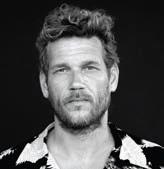
“I live off the North Shore Bike Path, so this project has been just me on my bike with one camera, capturing the vibrant scene happening right outside my house each winter,” says photographer Arto Saari, who shot “Country Road” for this issue. “I had taken a long break from photography after moving to the North Shore five years ago, but last winter’s sheer, raw beauty, the power of the ocean and the people who toy with that power reignited my passion. It was exciting not knowing whom I’d run into or what the waves would be doing that day.” Saari started taking photographs when he was a professional skateboarder, capturing skaters in action. He now lives with his family on O‘ahu, where he’s added surfing to his repertoire, along with travel and lifestyle.
Contributors
Amanda Beenen Cantor
Kathryn Muneno
08
Meghan Miner Murray Arto Saari

Connecting Flight
BY PETER INGRAM , PRESIDENT AND CHIEF EXECUTIVE OFFICER, HAWAIIAN AIRLINES

A Celebrated Career
Captain Kendall “Kiki” Culler didn’t set out to be a trailblazer when she joined Hawaiian Airlines as a pilot in 1984. Yet over the course of nearly four decades at the airline, she became just that. “I didn’t want to be a ‘woman pilot,’” Capt. Culler told me recently over lunch. “I just wanted to be a pilot.” She retired from Hawaiian in July as the most senior pilot in our nine-hundred-plus pilot corps, with thirtyeight spotless years of service.
Captain Culler grew up in and around planes, but it was a demo flight she took when she was eighteen that fueled her love of flying. “Once you take that demo flight and feel that first spark of passion, there’s no stopping you. You’re hooked,” she recalls. Culler inspired legions of pilots and crew members throughout her celebrated career and played a role in breaking down barriers for women pursuing careers in aviation.
Changing a male-dominated industry wasn’t easy. Hawaiian had men-only cabin crews until 1943 and began hiring female flight attendants only after many of our male employees left to fight in World War II. It would be another thirty years before women occupied the cockpit.
Sharyn “Sherry” Emminger wasn’t looking for the title of “first female pilot” when she applied to Hawaiian in 1978. She had also applied to Western Airlines and was getting ready for her final interview when Hawaiian called and offered her the job. Lucky for us she accepted. The following year, Capt. Emminger again made history. She and first officer Karen Squyres (the second female pilot hired at Hawaiian) and flight attendant Trude Asada became the first all-female crew to operate a commercial flight in the United States.
Captain Culler joined Hawaiian as a first officer five years after that historic flight. There were fewer than ten female pilots at the company at the time. There wasn’t a dedicated locker room for women, so Capt. Culler had to shower in the men’s locker room. That wasn’t the only challenge she and her female colleagues faced. Old stereotypes die hard, and their flying skills were closely scrutinized by male counterparts. Captain Culler was undaunted; she stayed focused, remained positive and worked hard. She earned her captain’s stripes in three years, leaving little doubt that she belonged in the cockpit.
Captain Culler spent the next three decades building her career, raising a family and paving the way for more
women in aviation. She recalled several times when, despite wearing a pilot’s uniform, people assumed she was a flight attendant or a skycap. Once, a passenger even asked to change flights upon learning that a woman was captaining the plane. Captain Culler took it in stride, focusing on moments that reinforced her decision to become a pilot: When parents pointed her out to their children while walking through the airport, or being a guest’s first female captain and giving them an outstanding flying experience. Over the years, Capt. Culler became a mentor to scores of newly hired pilots.
Many took Capt. Culler’s example to heart. Today, Hawaiian has the highest percentage of female pilots in the industry—just over nine percent. I am committed to seeing that number continue to grow. And while it wasn’t in her plans to be a trailblazer, there’s no denying the enormous impact Capt. Culler has had on so many careers.
“It’s been a great ride,” she says. It has indeed.
From our ‘ohana to yours,
10
After nearly forty years as a Hawaiian Airlines pilot, Capt. Kendall “Kiki” Culler (center) and crew celebrated her retirement with a final flight from Honolulu to Boston.
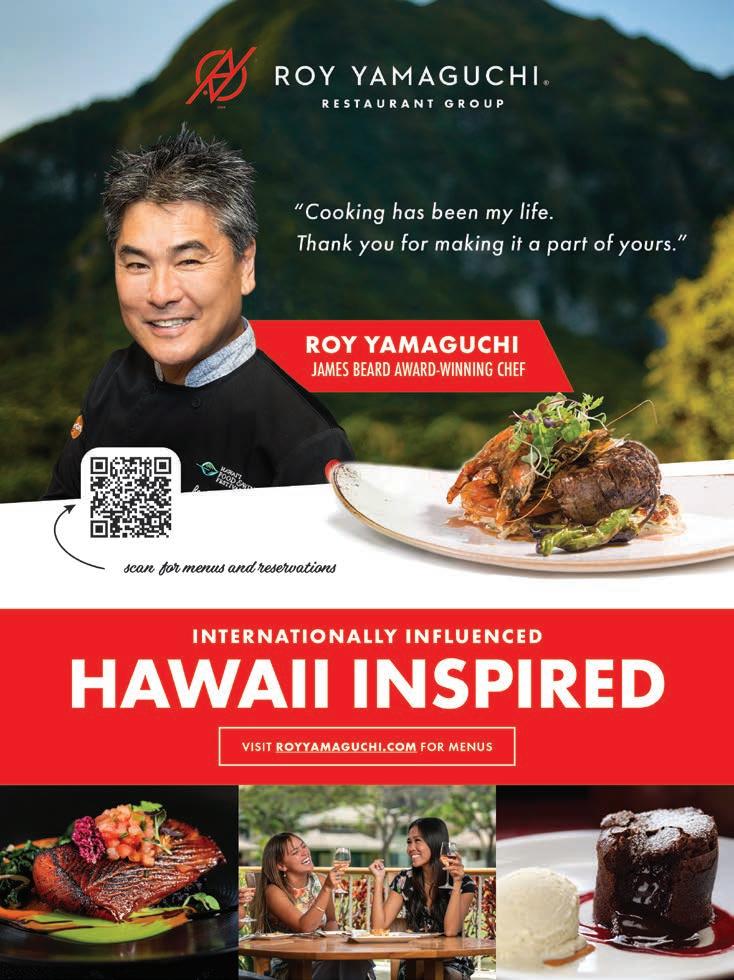
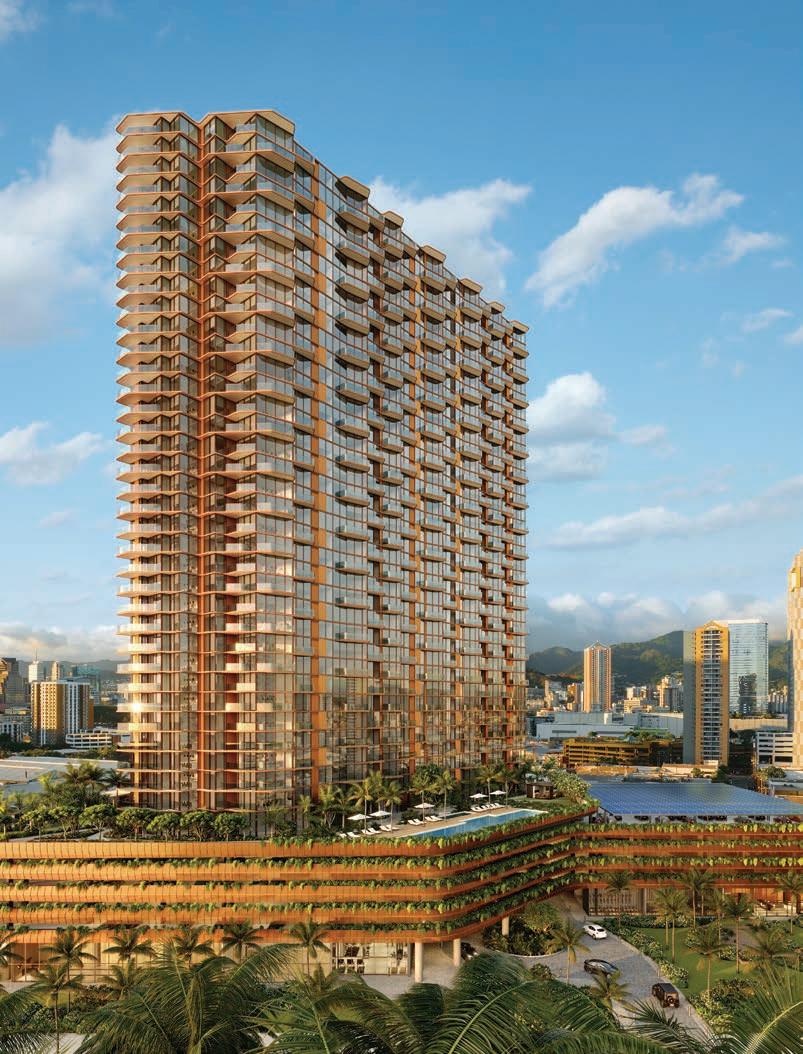
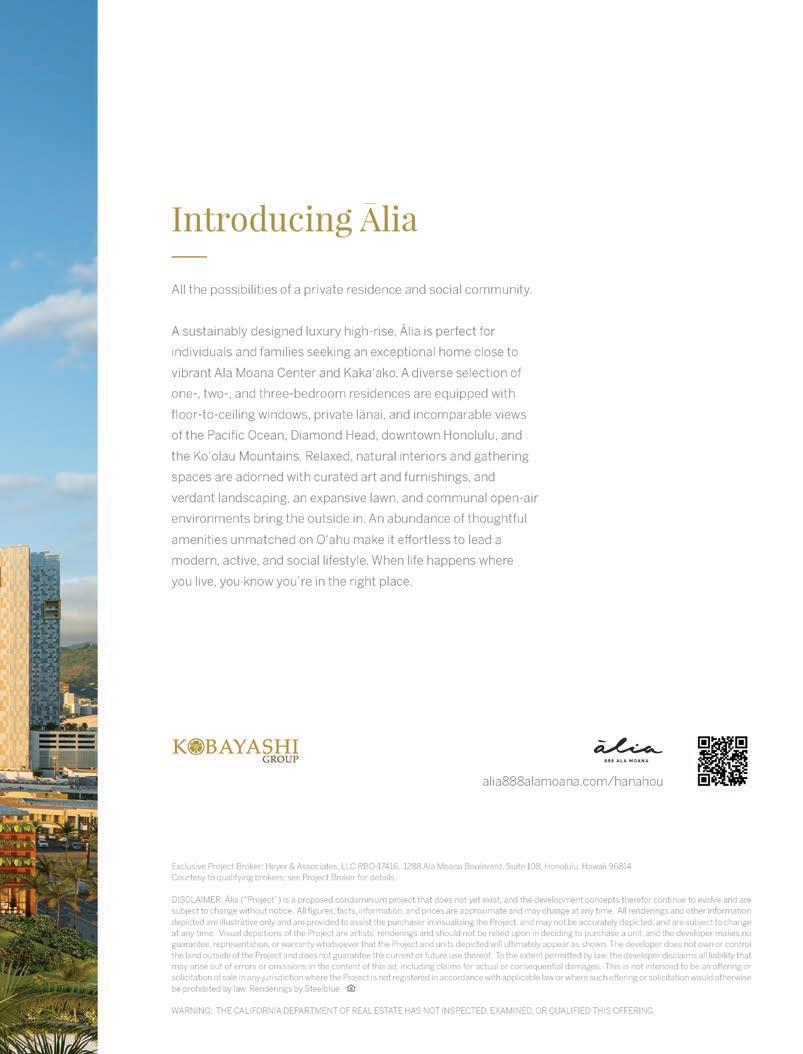


island intelligence
STORY BY KATHY MUNENO
BY FERESA CABRERA
In Hidden Color
In the ocean’s “twilight zone,” at depths where only blue light can reach, scientists are discovering a rainbow of brilliant limu, the Hawaiian word for algae.


“
When we get to the bottom and switch our video lights on, the whole world explodes with colors that were invisible seconds earlier,” says National Oceanic and Atmospheric Administration research ecologist Randy Kosaki, who recently dived three hundred-plus feet into the mesophotic zone of Papahānaumokuākea Marine National Monument (PMNM), the string of islands to the northwest of the main Hawaiian Islands.
University of Hawai‘i at Mānoa and NOAA scientists are finding troves of new limu in the relatively unexplored reefs of Hawai‘i between one hundred and six hundred feet—too deep for scuba but too shallow for submersibles. “About 50 percent of limu from that habitat are undescribed and likely endemic,” says Alison Sherwood, botany professor at
UH Mānoa, meaning they are found nowhere else on Earth. “I think there are probably hundreds of species remaining to be discovered.”
Discovering new species is always exciting, and naming these new life forms can be an opportunity. The PMNM Native Hawaiian Cultural Working Group is tasked with bestowing an official Hawaiian taxonomic name that not just identifies but tells a story about the limu. The group considers everything “from where the limu was collected and what the habitat was like to its color, shape and the distinctive features like taste or smell,” says Sherwood. “The working group then uses that information to discuss what these features evoke.”
Croisettea haukoaweo, found off Maui, honors Maui aquatic biologist Skippy Hau. Martensia lauhiekoeloa, a gorgeous
lavender alga from PMNM, is “a noble leaf that flutters,” the literal translation of lauhiekoela. And the “most regal, beautiful red alga is for Laura,” says Kosaki of Croisettea kalaukapuae, named for the late Laura Kalaukapu Low Lucas Thompson, who was a fierce guardian of cultural and natural resources as well as a founding member of the Advisory Council of the Northwestern Hawaiian Islands Coral Reef Ecosystem Reserve. So a name is not just a name. “We’re aiming to restore some cultural and geographical accountability to science,” says Kosaki. “Many specimens come from places where there is an extant indigenous culture. In many ways, I think this could be our greatest contribution to science, maybe even more important than the actual new species themselves.”
INTELLIGENCE
PHOTOS
HAWAI‘I
16
Two of the new species of limu (algae) recently collected from the deep reefs off Lisianski Atoll in the Papahānaumokuākea Marine National Monument. At left, an undescribed species of Leiomenia; at right, a newly described species, Psaromenia laulamaula
 STORY BY DEREK FERRAR
BY DANA EDMUNDS
STORY BY DEREK FERRAR
BY DANA EDMUNDS
Mekia’s Martin
Like many turn-of-the-nineteenth-century Hawaiian musicians, celebrated bandleader Mekia Kealakai—whose career spanned the overthrow of the Hawaiian kingdom and America’s annexation of the Islands—preferred guitars manufactured by CF Martin & Company.
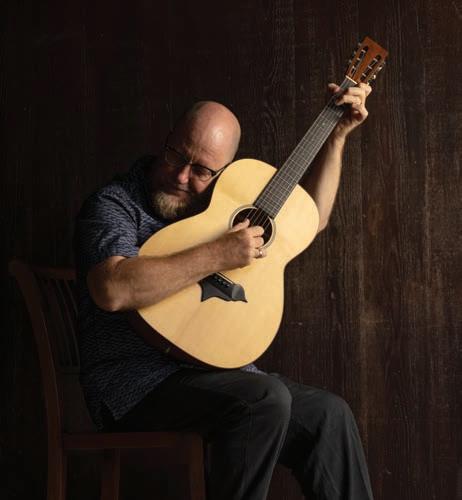
But in the days before amplification, Kealakai’s parlor-size guitar wasn’t loud enough for the big vaudeville concert halls at a time when the popularity of Hawaiian music was exploding worldwide. So he convinced Martin to make him a special guitar that was larger and had steel strings—
something the company was just beginning to try. As the iconic guitar manufacturer’s sixth-generation scion Chris F. Martin IV puts it, Kealakai’s guitar “was designed to give the people in the back row their money’s worth.”
As history would have it, the instrument delivered to Kealakai in 1916
became the prototype for the most widely played acoustic guitar design of all time: Martin’s “Dreadnought” model, prized for its sturdiness and volume. Kealakai’s role in the origin of the Dreadnought, however, remained generally unknown until it was brought to light in recent years by luthier and historian Kilin Reece, founder of the nonprofit Kealakai Center for Pacific Strings.
This spring, Martin released a reissue called the Custom Major Kealakai. Calling the original instrument “the ‘missing link’ in our company’s transition from making smaller, Spanish-style guitars to the larger instruments of today,” Chris Martin says that after researching the guitar’s history with Reece, the company put out the reissue “to honor this amazing Hawaiian story behind the guitar that essentially birthed the Dreadnought.”
Key features have been painstakingly re-created in the new version, which retails for just under eight grand (with a portion going toward music education programs for Hawai‘i’s kids). Most noticeably, there’s the unique flowershaped bridge that Kealakai designed himself. And the guitar’s sides, back and neck are made from a hundred-year-old trove of mahogany—making it the same age as the original.
Kim Ae, a great-granddaughter of Kealakai who is collaborating with Reece on a film project, says that hearing one of the replica guitars played for the first time “gave me chicken skin, to think that we come from the line of this musician who had such a big impact. It’s a story that’s not only dear to us, but to all Native Hawaiian people, with all the history that’s wrapped up in it.”
O‘AHU INTELLIGENCE
PHOTOS
18
KCPSTRINGS.COM
Guitar maker and historian Kilin Reece plays a Martin Custom Major Kealakai (seen also on pages 15-16). CF Martin & Company created this reissue of an instrument it built for Hawaiian musician Mekia Kealakai in 1916—the ancestor to the most popular acoustic guitar style in the world.
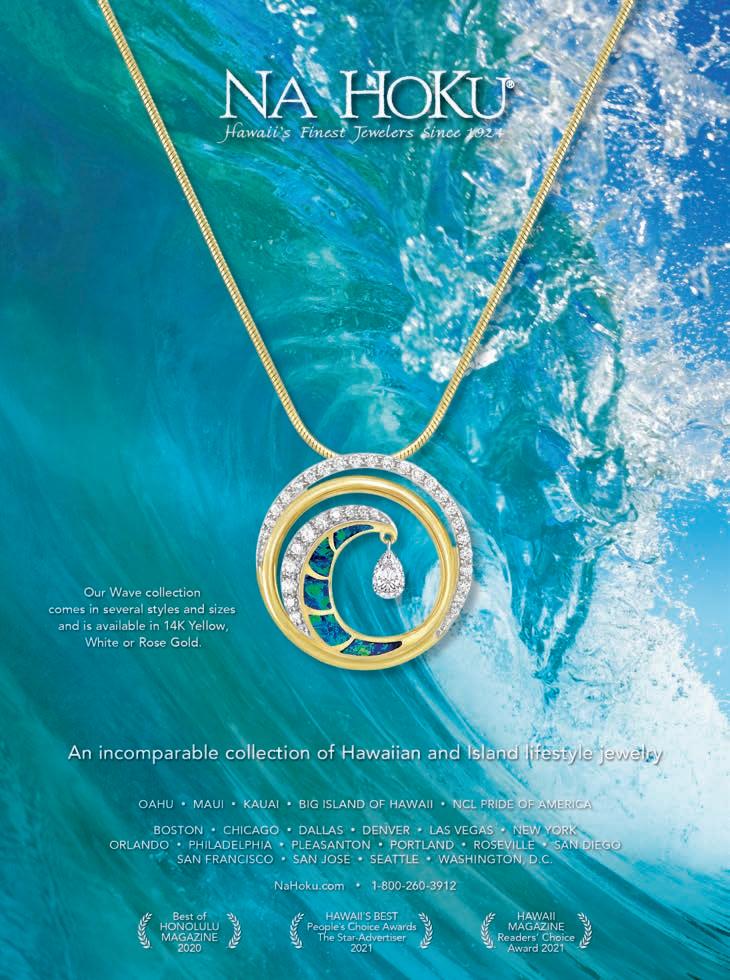
Big Picture Guy
Jack Soren believes that fortune strikes where preparation meets opportunity. For the artist, that intersection is on the North Shore of O‘ahu, where many paths from his childhood converged: an affinity for surfing and graffiti, a circle of ambitious friends and a dedication to Hawaiian values.
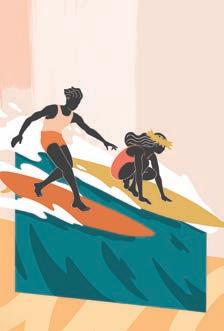
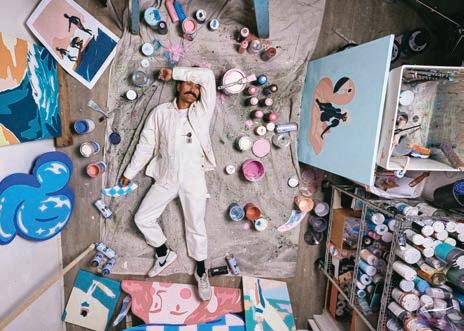
Soren grew up in Lā‘ie, where his family has been for three generations. In his youth he surfed, hiked and decorated pillboxes and retaining walls with whimsical characters: skeleton pirates, sailors, walruses. He was inspired by other Native Hawaiians who’d achieved greatness: Duke Kahanamoku, Carissa Moore, Max Holloway, Bruno Mars. “People from here, a tiny island in the middle of the ocean,” Soren says, “out there doing amazing things.” When Soren was 15, someone offered him $200 to paint sea creatures next to a swimming pool. That was his first commission and he hasn’t looked back. After graduating from Brigham Young University, he told himself, “You’re not getting a job. Make the art work. It’s time to put both feet in.”
His work, which combines a retro surfing aesthetic with a playful street-art sensibility, drew proposals from fellow muralists for large-scale collaborations and commissions for modern building decor. Today he works out of the same studio where his father once made Hawaiian jewelry, and his projects take him to far-flung destinations where people are eager to learn about Hawai‘i and its Native people. Reciprocally, “my kuleana [responsibility],” he says, “is to go out into the world, collect knowledge from other peoples and bring it back to my village.”
Creating public art (like the “Welcome to Wahiawa” mural at exit 8 of H-2) is especially gratifying for Soren. In 2021 he painted a two-hundred-foot piece in a Washington, DC, neighbor-
hood, where residents were reeling from a recent homicide. Beside a Pegasus in flight, Soren incorporated the words “ka lā hiki ola” (to look forward to the sun rising again). “There are a lot of Hawaiian principles that could benefit the world,” he says. “That one felt good to put there.”
Which might serve as a tidy summary of his approach to art: feeling good. “If someone is driving down the street having a bad day and they see a forty-foot walrus with a pirate hat on, they might get a kick out of it,” Soren says. “That’s the greatest reward, being able to help that one person who needs it.”
JACKSORENART.COM
STORY BY CATHARINE LO GRIFFIN
O‘AHU INTELLIGENCE
PHOTOS BY ARTO SAARI
20
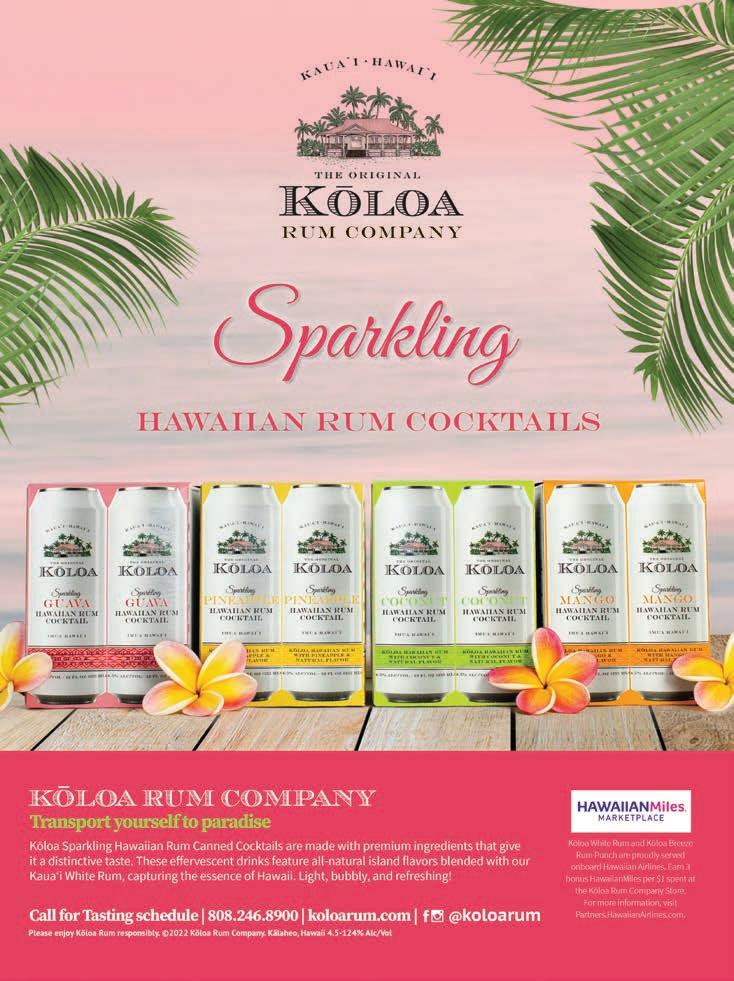
On Borrowed Tools
STORY BY MARTHA CHENG
PHOTOS BY LILA LEE
People come because they want to scrape the popcorn stucco off their ceiling.
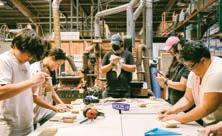
OElia Bruno (seen at right), the founder and executive director of the HNL Tool Library, sits among some of the equipment that library members may borrow for their DIY projects.
r 3D-print an accessory that turns an iPhone into a microscope. Or build a standing wave out of reclaimed lumber and found fishing nets. They come to make things from the practical to the whimsical. “We get a lot of people who just saw something on YouTube and they don’t have the experience but have the confidence and bravery to try,” says Greg Young, a volunteer HNL Tool librarian, who himself first came for the tools to make a balance board.
About seven years ago Elia Bruno, then a student at the University of Hawai‘i at Mānoa, dreamed of building a garden. And a compost bin and a chicken coop while he was at it. “Immediately that dream got shut down because I didn’t have any tools,” he says, nor much money to acquire them. But he knew that in houses all over the island, tools sat idle. He says the average drill is used for thirteen minutes before it’s tossed. “We’re utilizing all this metal and plastic and creating pollution to build this drill that somebody’s going to use for thirteen minutes. I thought, in an Island community, can we get more use of this stuff, save money and reduce our impact on the environment at the same time?”
In 2016, Bruno launched the nonprofit HNL Tool Library inside Re-use Hawai‘i’s redistribution center in Honolulu, a store for salvaged construction materials. At the library, you’ll find band saws, planers, drills, lawn mowers, ladders, “a lot of what a hardware store has,” says Bruno. And then some, like sewing machines, a 3D printer and a laser cutter and engraver that you can book time at. Tool librarians are on hand to help point you in the right direction, and they also teach workshops ranging from making koa wood chopsticks to electrical wiring basics.
The tool library functions a lot like a book library. Members check out as many tools as they need for up to a week. Bruno says, “We want people to understand that this is more like sharing with your neighbor, your co-worker, your family than it is like a tool rental business. We’re about people coming together and realizing how it just makes sense for us to collaborate.”
HNLTOOLLIBRARY.ORG

O‘AHU INTELLIGENCE
22


The Food of Love
STORY BY MALANIE MCLELLAN
BY MICHELLE MISHINA
Looking at the festive logo for the Kaka‘ako restaurant Istanbul, you might never guess it was born of sadness.

About seven years ago Ahu Hettema, a Turkish national, was living in San Francisco and studying psychology and art. But the US government was threatening to deport her, and the stress drove her into a profound depression. “I didn’t want to exist anymore,” she recounts with surprising candor. “I was heavily medicated to deal with the pressure of it all. I became numb.”
But Ahu’s mother, Nili, flew in from Turkey and showed up on her doorstep with a suitcase full of the spices and the foods Ahu loved as a child. Nili nursed her daughter back to health in the way she knew best: with food. “She cooked for me, then we cooked together. The more we cooked, the closer I felt to my home, to family. It awakened something in my soul. The sadness started to subside.” They cooked so much that they had more than they could eat, so they shared with the neighborhood. Then a neighbor encouraged them to sell their food at a farmers market in Kailua. “So we did and people loved it.” That success led to their next leap: opening a restaurant.
“It’s a magical story for me. I never planned on opening a restaurant or being a chef,” Ahu laughs, “but it all came together.”
Along with the support of her father, husband, mother and brother, the family pooled their creativity, building the furniture, painting, designing fixtures to create a warm space reminiscent of a modern Turkish home. Then, just as they were about to open, the pandemic hit. “We were out of money,” Ahu says. “I just sat down and cried. But a woman walking by saw me, hugged me and told me to just keep working. I took a break and got back up again.”
Now considered the best Turkish restaurant in Hawai‘i, chefs Ahu and Nili credit the restaurant’s success with their commitment to cooking from scratch (their hundred-day dry-aged ribeye is done in-house) with fresh ingredients imported from Turkey, like Mediterranean sea bass and bright, jewel-green Turkish pistachios.
“My goal is to share the nourishment that brought me joy. My food is my message to the world: If you find something that makes you happy, keep doing it as long as you can. Chances at happiness should never be taken for granted.”
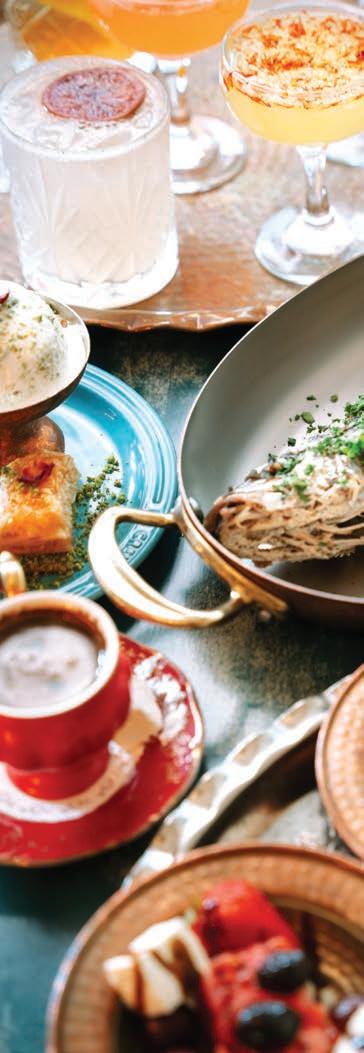
ISTANBULHAWAII.COM
O‘AHU INTELLIGENCE
PHOTOS
24
Mother-and-daughter
chefs Ahu Hettema (left) and Nili Yildirim (right) at Istanbul, the popular Turkish restaurant in Honolulu inspired by Nili’s home cooking.


Leaving Souvenirs
Gunstock Ranch on O‘ahu’s North Shore offers your fun, if typical, visitor experiences, like horseback riding and off-road vehicle tours. But in 2018 it added something off-off road: tree-planting eco-tours.
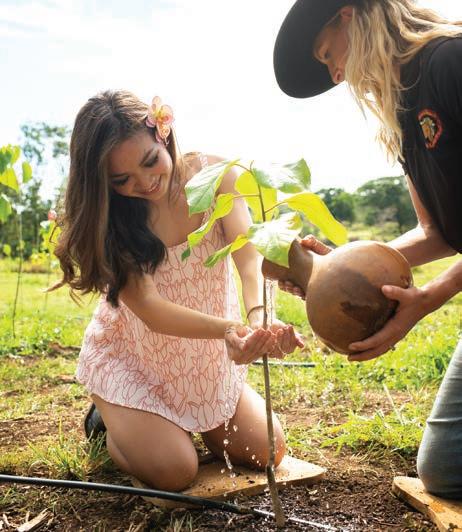
The program was initiated by the nonprofit Hawaiian Legacy Reforestation Initiative, which conducted research showing that planting a tree can environmentally offset a one-week visit to the Islands for a family of four. Guests can plant milo or kou—native species that thrive in the habitat and improve the soil. That’s important for
a place like Gunstock, which sits on former sugar cane land where the soil is depleted. Native trees might better retain and replenish soil in the years to come, “a really deep and long process,” says Jeff Dunster, executive director of HLRI. The organization’s research demonstrated that one milo tree, over its lifetime, generates approximately $100,000 of
benefit in terms of soil retention, oxygen production and carbon sequestration.
Hawaii Reserves Inc., which manages the land that Gunstock Ranch leases, pledged 500 of its 900 acres to the reforestation effort, and it’s been a success: More than 25,000 trees have been planted to date. A similar initiative on Hawai‘i Island has yielded approximately 565,000 trees over 1,100 acres. “Our goal is to put up an intact ecosystem,” says Dunster. “Not just plant a bunch of trees. We’ve seen endangered animals moving back in the area and even starting families.”
Still, it’s a risky venture as far as tourism goes, as you can’t just plant trees and expect a forest. Dunster estimates that reforesting an initial eighty-three acres at Gunstock cost roughly $1.6 million for supplies, staff, fencing and irrigation, funding that HLRI provided. “I had no idea how much it costs to do regenerative work,” says Lilia Tollefsen, chief operating officer at the ranch. “It’s a nice buzzword, but the actual cost is quite extraordinary.”
The ranch benefits of course, but the guests find unexpected meaning in the experience. “Something changes in people when they get out here and do it,” says Tollefsen. “I think the best line I’ve ever heard was, ‘I had no idea I could feel this way about a tree.’ It’s just one of those things you can’t fully explain.” Many guests dedicate their tree to a loved one, and an RFID tag is assigned to each tree—with periodic drone flyovers—so visitors can check in on a laptop and watch their trees grow. “We tell people perhaps the best memento you’ll take from Hawai‘i is the one you leave here,” says Dunster. “A lot of people want to do the right thing, so when you give them an avenue, they’ll take it. And I think in twenty years everyone will be doing this.”
STORY BY DW GIBSON PHOTO BY ELYSE BUTLER O‘AHU INTELLIGENCE
26
GUNSTOCKRANCH.COM
A visitor plants a native tree at Gunstock Ranch, on O‘ahu’s North Shore. Guests and volunteers have planted some twenty-five thousand trees since the ranch began including tree planting as part of its eco-tours.

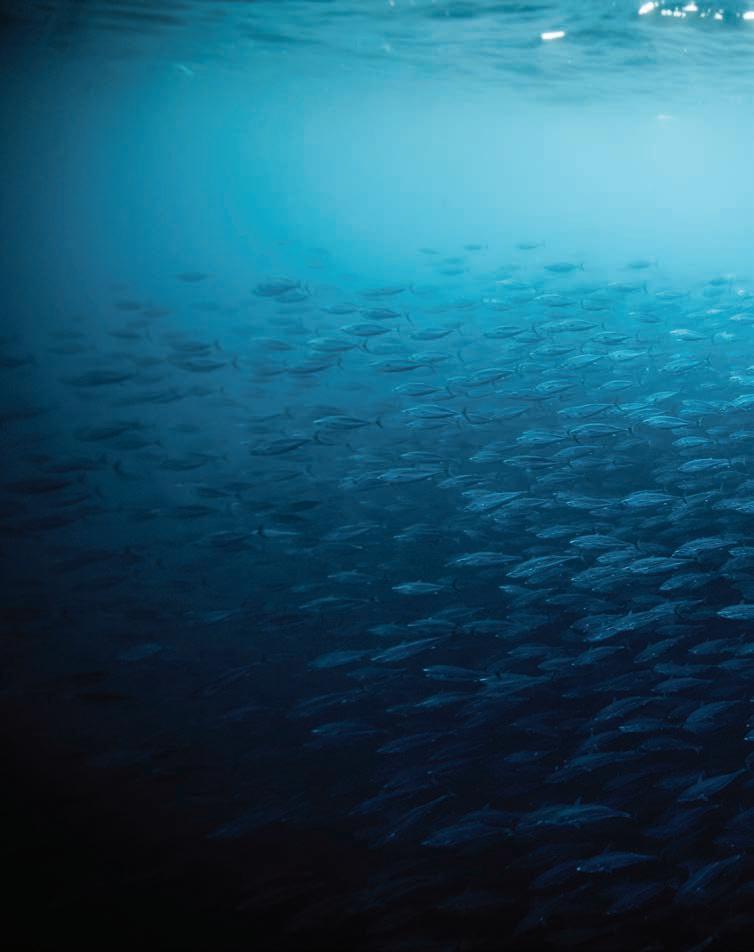

departments & features
The Fisher King Whether on land or at sea, Justin Lee has mastered the art of catching dinner
Iask Justin Lee what he wants to do with his night off. His wife, Sonnaly, is working, and his inlaws are watching their young kids, Elle and Pa‘akai. It’s drizzling rain, the wind is up and the sky overcast. A hurricane passing to the south has whipped up a historically large swell, so Justin, a champion spearfisher, decides to hunt on land instead.
At 38, Justin is a world-class hunter both on land and at sea. He’s sponsored by premium brands like Traeger grills, Yeti coolers and Aimrite spearguns. He’s downed an eight-hundred-pound elk with a single arrow. He’s ranked in the top
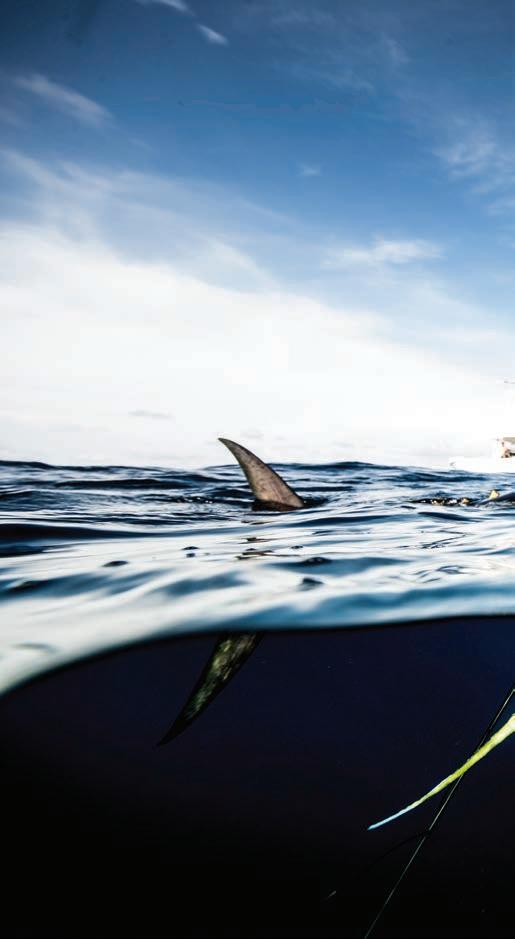
30 STORY BY LUKE WAIKS PHOTOS BY PERRIN JAMES

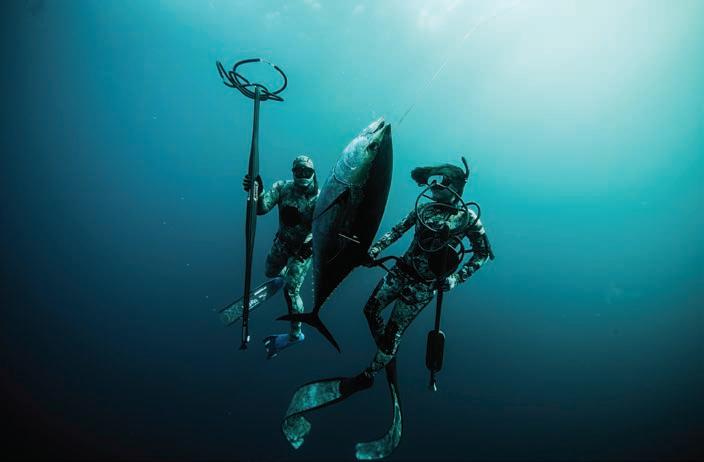
Champion spearfisher and hunter Justin Lee ascends in the waters off Panama with the largest ‘ahi he’s caught to date (190 pounds), along with fellow spearfisher Kimi Werner (at right). Lee’s prowess at spearfishing has taken him around the world for competitions, but he’s most at home in the waters off Hawai‘i Island, where he grew up and where he lives today. On the following spread, Lee relaxes at sixty feet in between drops at Hannibal Bank, a seamount off Panama.
twenty-five in the world for competitive spearfishing. I, on the other hand, have barely hunted, and for nothing like a giant elk (fish, doves, turkey, deer and gator). Like most of us, I have to choose between doing fun things and doing adult things. Justin seems to have made all the right choices to bring those two things together, and I’m spending a long weekend with him to see how he does it.
We drive down backcountry roads and through a few locked cattle gates. “If you’re respectful and let landowners dig into your cooler, they’re happy to let you hunt their land,” he says. This applies especially to this former sugar plantation community of Honoka‘a on the north shore of Hawai‘i Island. The landowner has declared open season on pigs, no limit. Wild pigs are invasive and destructive; they increase soil runoff by rooting in streambeds and cause deforestation. Landowners are only too happy to get rid of the scourge. But we’re not going after some run-of-the-mill pig: The landowner wants Justin to hunt
down a giant boar that reportedly eats newborn calves.
Justin, dressed in camo, looks like a bush wearing a ballcap. Instead of quietly stalking, we take off on a fast walk. He points out wary pigs that somehow know to stay beyond the range of his Matthews bow. Such highperformance bows are customized to a specific hunter’s arm anatomy, so it’s unlikely I’ll have any luck with it. I hold back and watch. “They smelled us. Now we are downwind. We’ll walk right up on them,” Justin says. But the pigs are spooked by the cows that we’ve spooked. Justin zigzags us among watering holes and groves of kukui (candlenut) trees, scaring roosting wild turkeys. Eventually we catch a small group of pigs unaware. Justin stalks, draws and fires a silent arrow.
It’s a perfect shot. The pig, a sow, drops instantly. Dressing the kill, we find that the arrow had penetrated both the head and heart, so it’s a clean and merciful kill. Justin targets sows over
boars when he can, as a sow can have litters with as many as ten piglets, and “if she’s not nursing new piglets, she’s pregnant again,” Justin says. Later, he tells me he’d never made such a clean shot. But this is no dumb luck; this is experience in action. We never do find that calf-eating monster, but we may well have prevented ten more from being born.
Whether hunting or fishing, Justin attributes his success to “understanding animal nature,” he says. To get close with short-range weapons like bows and even closer with spearguns, you have to think like your quarry. “You can’t make aggressive movements towards ulua,” or giant trevally, a prized game fish. Instead of stalking, Justin wedges himself into the reef, watching other fish like a predator while almost blindly aiming his speargun to where the target ulua will be. He can wait a long time; both his breath hold and patience are
32

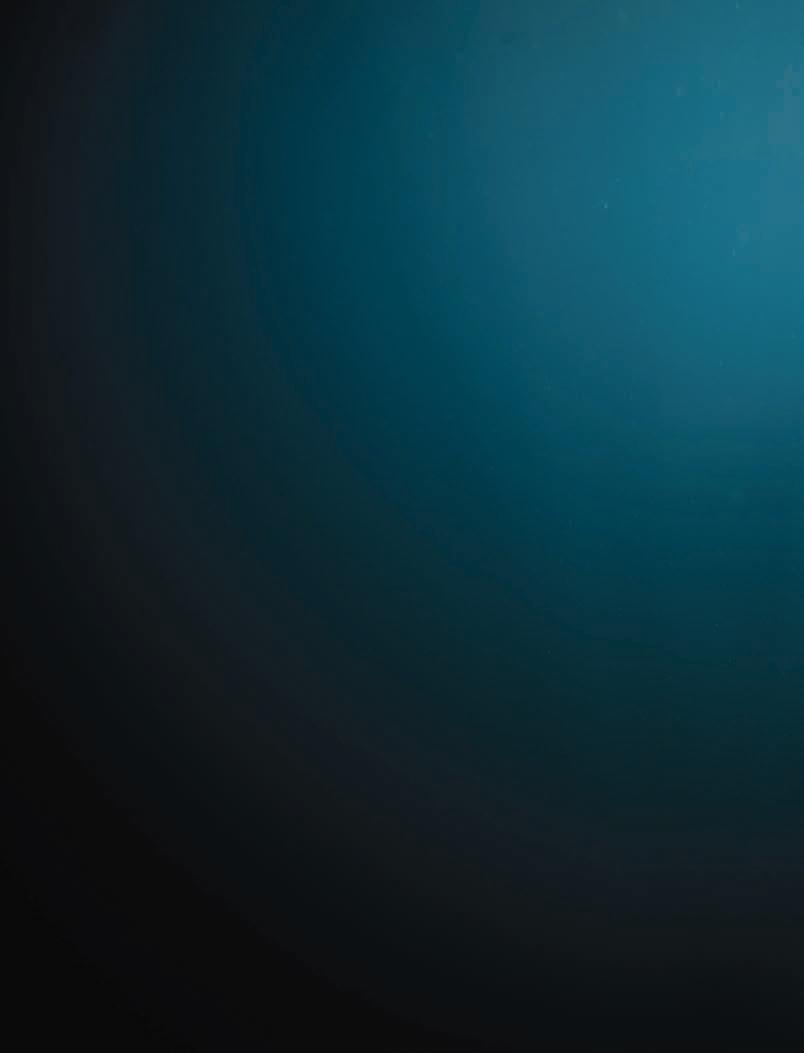
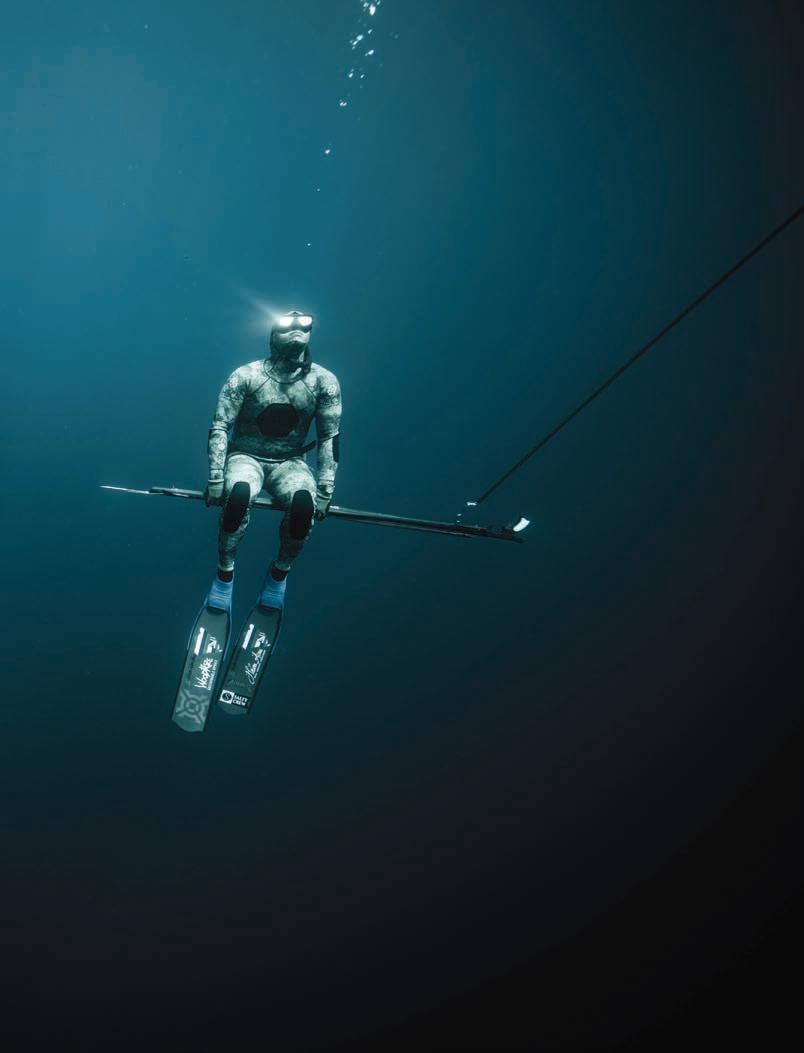

preternatural. So is his endurance: Most spearfishing competitions last six hours, involving dives deeper than you can safely go on recreational scuba, all while battling powerful, wounded fish. But for Justin, that’s a typical Saturday dive on the Hāmākua coast.
Justin was an athlete from the start; he took to volleyball and swimming in high school, winning the state competition in fifty- and hundred-yard freestyle, becoming an All-American swimmer and earning a scholarship to the University of Washington. He aimed for a career in medicine, but college life in dreary Washington didn’t suit him, so he returned to his family and the Islands, working at restaurants before becoming a firefighter. Justin doused fires for eight years, hunting and spearfishing during his downtime. “I loved the fire department,” he says, “but I don’t miss responding to our neighbors having the worst days of their lives.”
Justin placed well in cutthroat local team tournaments, but in order to bring
his spearfishing wins to the next level, to compete nationally and globally, he needed to compete on his own. To qualify for the World Underwater Spearfishing Championship, Justin had to first qualify for Team USA by placing well in two national events. Winning such events requires not just spearfishing skill but a strategic understanding of the scoring system; Justin was disqualified during the Florida nationals because a triggerfish he shot was five-eighths of an inch too small. He made up the loss in ranking by winning the next national championship, shooting the largest carp during an event at Lake Powell. What’s it like spearfishing in a freshwater reservoir? “Cold. Visibility is not so much, but it’s shallow and there’s a bunch of big, dumb fish,” he says. In five hours he made 177 drops, barely cracking 25 feet. His strong showing at Lake Powell put him on Team USA for the 2018 World Championship in Portugal.
A fish assassin of Justin’s standing
does not wing it. For three weeks leading up to the event, he scouted the reefs of Portugal. He swam off the beaten path and found a flat patch of reef at seventyfive feet with a couple of deep crags and seemingly limitless schools of prize fish. “I had it all planned,” he says. “I would dive, shoot, reload and dive again, every six minutes.” With that arithmetic, he knew he would be the likely winner. But the day before competition, a storm from the south changed the current. The fish were nowhere to be found, but he dived with everything he had nevertheless. Later, the observer told him in broken English that he’d never seen anyone dive so hard for so little. “I think he meant it as a kind of compliment,” Justin says. He kept at it for hours with nothing to show. “I couldn’t buy a fish,” he moans. The next day, though, his luck improved at another spot, and Justin placed twentyfourth out of seventy-five of the world’s elite spearos. His earlier performance in the 2016 world championship in Greece was even more impressive: He took fish
36
Above, Lee and Werner celebrate after landing that big ‘ahi in Panama. To spear a fish of such size and power, one has to “understand animal nature,” says Lee. He applies that same understanding on land when bowhunting for invasive pigs and sheep, which devastate agricultural lands and native forest.
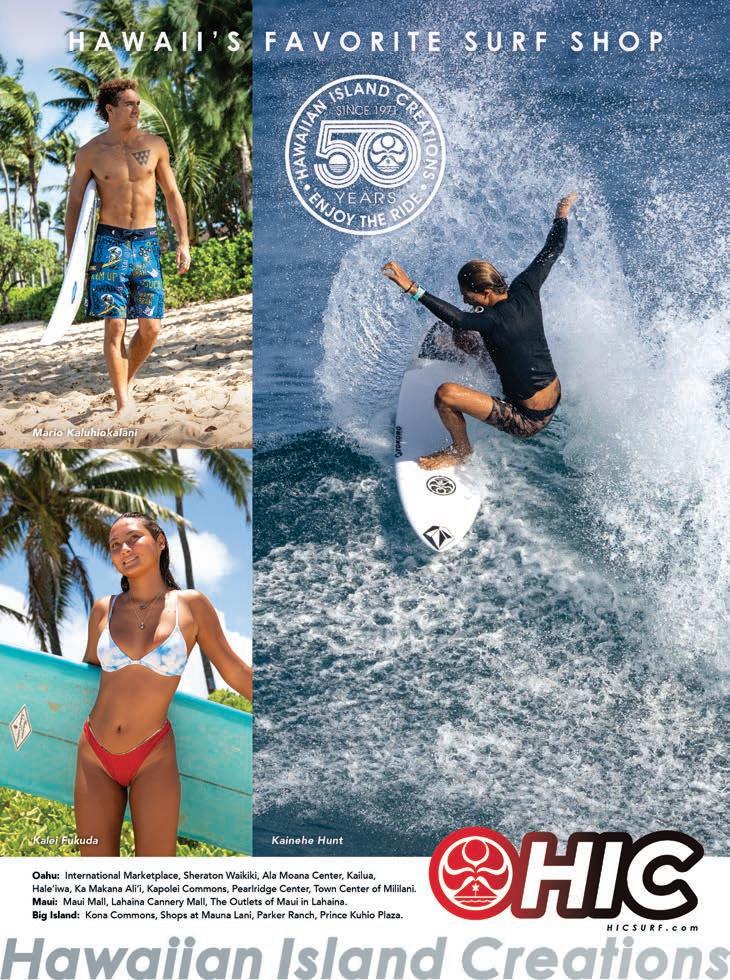

from depths between 150 and 195 feet and placed ninth in the world.
But neither Portugal nor Greece is as challenging as his home turf. There are few sandy beaches on the Hāmākua coast—it’s mostly cliffs. Justin gets to his fishing grounds courtesy of borrowed extension ladders, and his sidekick—his dog Dennis—leads him back to the exit point by barking from it. That partnership works out most of the time, but Justin has more “I almost got rescued by the Coast Guard” stories than he cares to discuss, he says.
We’re bounding along in an ATV down a firebreak at Hāloa ‘Āina, the 2,780-acre sandalwood forestry operation his father, Wade, started in 2010. Back at the ranch house, Justin had shown me a photo of what the land had looked like ten years before: a volcanic moonscape spangled with twiggy eucalyptus trees. Now there’s a low scrub of native sandalwood saplings growing on either side of the firebreak. “I don’t fault the people who came before us,” Justin says, referring to the ranchers who long ago cut down the native forest and seeded grasses from Africa to graze cattle. “They were doing
what they thought was right at the time to support themselves.”
Sitting between us, Justin’s daughter Elle announces her intent to pick daisies. He stops, but not for daisies. “Ram, right there. Take ’em.” I dig out his scoped rifle and let the crosshairs stabilize between the curled horns of the mature male half-Mouflon sheep, another destructive invasive species, guarding four ewes. I fire and the ewes scatter. I reload for a follow-up shot. “No need. You dropped him.” “That was loud,” Elle says, then jumps out of the ATV to pick daisies. Like pig sows, rams are a good target for population control, Justin explains. “A ram is ready to mate year-round, but the ewes have maybe two babies per pregnancy. It’s best to eliminate the ram.”
We drive on and Justin stops again and points. “Another ram. Brown coat, right in the middle of the pack, black face.” This time the pack scatters. I get out and stalk to where I last spotted them. Justin makes guttural noises and then motors up the path. Minutes pass. “Come to this tree and kneel,” he says, pointing. “You’ll see him.” He’s right. I fire hastily; the ewes flee. “Dropped ’em again!” Justin exclaims. Turns out
this was all strategic: Sheep are wary when an ATV stops, but when it motors on, they figure it’s just the forestry workers going about their business. Justin’s eerily realistic mating call and ATV misdirection put the sheep at ease. I’m doing the easy part; I’m just the trigger man.
This isn’t sport. It’s work and sustainable forestry. Justin tells me, “It’s a wetter season so there’s lots of green grass now. But when it gets dry, the sheep eat the tender tree saplings or any branches that droop low. And rams rub their horns against mature trees,” breaking the bark and exposing the tender xylem to insects and fungi. The best thing one can do for a fragile native forest in a single day, he says, is to drop a couple of rams.
As a sandalwood forestry operation, Hāloa ‘Āina focuses on planting and protecting growing saplings; responsible culling of old trees creates the revenue needed for the reforestation effort. The operation selects only dead or dying sandalwood trees, each sixty years old and about fourteen inches around at the trunk. “During the reign of King Kamehameha I, every man, woman and child was told to gather about one hundred pounds of sandalwood,” he says. It was the kingdom’s first international export, sold mainly to China for incense and perfumes. Demand for sandalwood accelerated deforestation in the Islands, and the resource didn’t last: By the middle of the nineteenth century, there was so little sandalwood left that the industry collapsed. Hāloa ‘Āina is five thousand feet above Ka‘awaloa (Captain Cook), so some sandalwood on this land was spared, and Justin’s family sustainably harvests and replenishes it.
In the processing facility, distillerystyle stainless-steel tanks and wood shredding equipment are housed in two metal Quonset huts. The distillation process is labor intensive but worth it. The trunks and root balls are shredded into sawdust and steam distilled to extract oil and hydrosol.
38
Above, Lee shoots targets at Hāloa ‘Āina, his family’s sandalwood agriforest, while daughter Elle evaluates his precision.
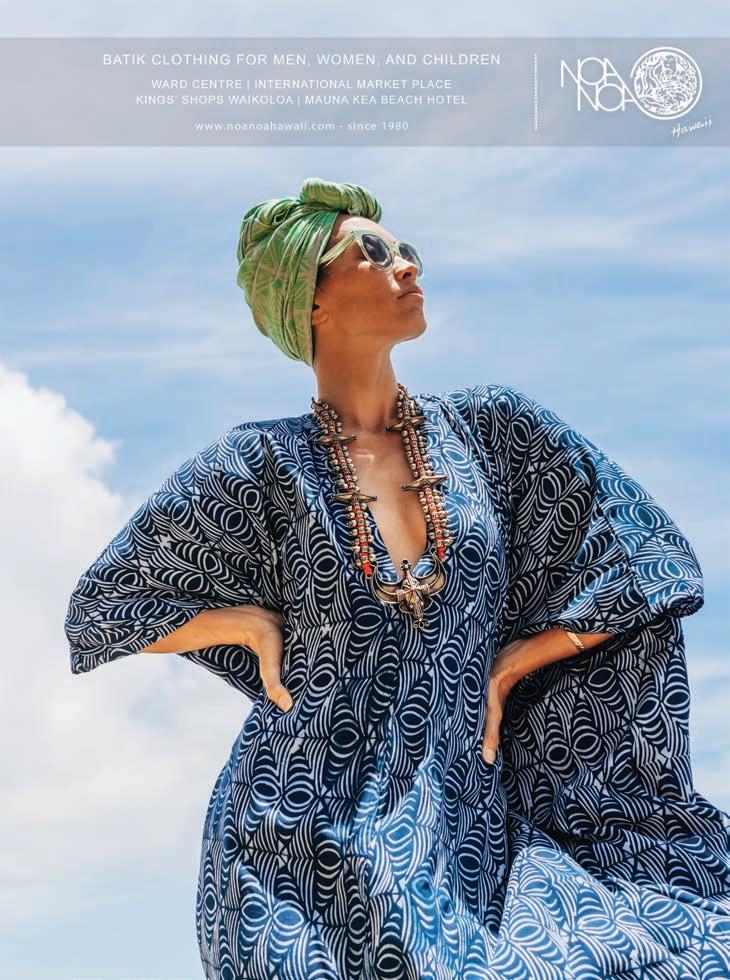

A ton of sandalwood yields about ten kilograms of oil and gallons of fragrant hydrosol. At retail the oil sells for $105 per five-milliliter bottle. Unlike the days of old, when commoners slaved to haul sandalwood down the mountain for the king, “this supports our family and the families of our thirteen workers,” Justin says.
When Elle was born, Wade invited his son to help with Hāloa ‘Āina—a safer line of work for a new father. So Justin left the fire department and started hunting even more. He maintains his ties to the firefighting community and has created water reservoirs at Hāloa ‘Āina for fire department helicopters to fill their drop buckets when fighting brush fires.
The next day, I bring my attempt at ram stew to a local-style barbecue at Wade’s place. There are a lot of kids and dogs under the command of Justin’s mother, Lillian. All of the meat dishes are the fruit of recent hunts (Justin’s sow has provided the kālua pork). He
credits his family, Wade especially, for his hunting prowess and every other success in his life. Wade, 64, chases his ten grandkids around with an awkward gait due to a spinal injury he suffered from decompression sickness while scuba diving. That didn’t stop him from joining the National Guard and becoming a nuclear, biological and chemical defense specialist. “Real superheroes don’t wear capes,” Justin says, “and my superhero drags his toes when he walks.” Wade in turn credits his bowhunting ability to his father and grandfather, who made their own arrows from cedar dowels fletched with turkey feathers.
Wade praises my ram stew as “tender,” which has me grinning. Wild meat tends to be tougher than pastured meat. Justin eats sparingly and drinks a gallon of water. He’s constantly vigilant about his weight—a long time has passed since his college years, when he was so ripped he could have danced for Thunder Down Under. But there’s another reason he holds back. “When I
was an infant, I was diagnosed with stage four neuroblastoma,” he says. “When they brought him in for surgery,” Wade remembers, “he was as big around as he was tall.” The surgery removed the cancer, but it also took a kidney, half his liver and most of his adrenal glands. It took years for Justin to recover, but by the time he was four, “he was playing baseball with his older brother, Brandon,” says Wade. Decades later, Justin met his surgeons on a guided hunt. They couldn’t believe it was the same boy whose life they’d saved. “I showed them my scars from where they took skin from my legs to graft my stomach back together,” he says smiling. “They had told my parents I had a 5 percent chance of survival.” These days he eats his quarry in moderation, he says, to prevent gout.
Justin lets his sleepy son Pa‘akai crawl up on his lap. He looks down at his son and lays a last bit of advice on us both: “Check your gear, every screw and fastener. If you break it down, life is all about getting dinner.” hh
40
When Lee wants to fish with family, he’ll go from land. Above, Lee with his wife Sonnaly and daughter Elle on the beach at Waipi‘o, Hawai‘i Island.

The Sound of Ancient Water Maui’s Kahoma Stream returns to its natural course

When Archie Kalepa brings people up to Kahoma, he asks them to stop and listen. “That sound you hear,” he says, “that’s the stream running. That sound was nonexistent in this valley for over one hundred years.”
Kahoma Stream has carved a narrow gorge through the fallow sugar cane fields above Lāhainā. It runs parallel to Kanahā, its neighbor immediately south. As the twin streams travel seaward, they pass beneath Lahainaluna School, where they
join. And just below that, the rocky streambed disappears under concrete. Channelized in 1990, the watercourse that empties at Mala Wharf doesn’t look or smell like a stream. And yet, even in its altered state, it supports life.
The Kalepa family owns a single-acre parcel straddling Kahoma Stream, but their ties to this area reach back many generations. “Kamehameha I made our great-great-great-grandfather a konohiki [caretaker] of Lāhainā,” says Kalepa. For as long as he can remember, his family and their neighbors have wanted to grow kalo (taro), the nutrient-rich staple of the traditional Hawaiian diet—but couldn’t
without water, which had long ago been diverted to supply sugar plantations. Even after Pioneer Mill Company, which had tapped Kahoma, closed in 1999, the stream remained dry.
In 2007, Kalepa and a few other longtime Lāhainā residents learned that the Kahoma Stream intake was on land owned by Kamehameha Schools and began petitioning the organization to restore the water. These steadfast Hawaiian families had held onto their land and the vision of their ancestors. Now, after years of advocacy, they are witnessing what happens when a stream comes back to life.
STORY BY SHANNON WIANECKI PHOTOS BY AMANDA BEENEN CANTOR 42


For a hundred and thirty years, the bed of Kahoma Stream lay dry, its water diverted to irrigate sugar cane plantations. The once productive lo‘i kalo (taro patches) and fishponds of Lāhainā disappeared. In 2007 the families of Kahoma, including that of Uncle Archie Kalepa (seen above) lobbied for the restoration of the stream’s natural flow (seen on page 42), one small battle in the larger fight for rights to Maui’s freshwater resources. On the previous page, Tiare Lawrence of Kamalu o Kahālāwai prepares kalo for planting.
For centuries, Lāhainā was a seat of Hawaiian power. After uniting the Islands under single rule, Kamehameha I established his royal residence here, in the lee of Pu‘u Kukui, the 5,788-foot summit of West Maui and one of the rainiest spots on Earth. Numerous streams flowed from the mountaintop, and that fresh water, or wai, was the wealth of the land.
The Lāhainā of the past was crisscrossed by streams and canals. Hawaiian farmers channeled stream water through their lo‘i kalo (taro patches) and fishponds via aqueducts, or ‘auwai. One of the largest ‘auwai dates back to 1390, when it was constructed and named for the chiefess Wao. Remnants of it still exist near Lahainaluna School.
The first foreigners to visit Lāhainā found a verdant patchwork of terraced lo‘i, fishponds with floating islands and breadfruit orchards so vast one could walk for miles beneath their shade. “The
environs of Lahaina are like a garden,” wrote French artist and explorer Jacques Arago in 1819. “It would be difficult to find a soil more fertile, or a people who can turn it to greater advantage; with little pathways sufficiently raised, and kept in excellent condition … frequently divided by trenches, through which a fresh and limpid stream flows.”
A shift in politics transformed this landscape. The Great Mahele in 1848 enabled the foreign ownership of land, and sugar plantations began proliferating throughout Hawai‘i. In 1860 the Pioneer Mill Company acquired several hundred acres above Lāhainā and installed drains, ditches and valves in West Maui’s streams to funnel the water to its sugar cane fields. Unlike the ‘auwai system, which returned the water to its course, the sugar ditches whisked the water many miles away, severing the connection between the summit and the sea. Beneath the intakes, streams slowed to a trickle or disappeared.
The diversion had profound effects: Native riparian species lost their habitat. Farmers lost access to the fresh, flowing water essential for kalo cultivation. Ultimately, many of the sugar magnates were among the leaders of the coup that overthrew the Hawaiian monarchy in 1893. Lāhainā’s royal fishponds and lo‘i were repurposed, buried or abandoned. By 1930 the place Captain George Vancouver called “the Venice of the Pacific” had dried up.
“Uncle
Archie,” as Kalepa is widely known, is a powerful ally—whether you happen to be a stream or a swimmer in distress. Most of his 59 years have been devoted to water safety and rescue. After graduating from Lahainaluna, he became a Maui County lifeguard and remains active in the Hawaiian Lifeguard Association. During Hurricane Iniki in 1992 he shuttled forty people to safety on his jet ski. That same year he joined the
44

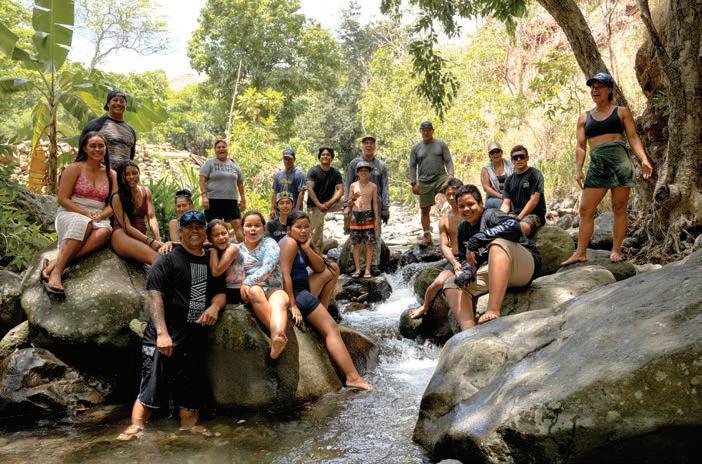
Polynesian Voyaging Society and has since sailed around the world as captain and crew aboard Hōkūle‘a, a replica of an ancient Hawaiian voyaging canoe. Among the first fearless surfers to drop into seventy-foot swells at Pe‘ahi, a.k.a. Jaws, he pioneered tow-in surfing and helped repopularize traditional canoe surfing and stand up paddling. Cut from the same cloth as Hawaiian watermen Eddie Aikau and Duke Kahanamoku, Kalepa is as much a cultural ambassador as an athlete.
While Kalepa may be Kahoma’s best-known native son, he’s joined by other heavyweights. His cousin Chad Babayan and niece Kala Babayan both sailed on Hōkūle‘a. The Keahi cousins, Kekai and Kapali, are Hawaiian-language experts, musicians, fishermen and vocal advocates for indigenous rights. Tiare Lawrence is an influential community organizer. The single mother of two grew up in a parched, tinder-dry Lāhainā. She remembers visiting East Maui as a kid and gazing in reverence at the taro
patches of Ke‘anae. “I didn’t know that the same amazing system once existed in my own backyard,” she says. “That made me feel really sad.” She channeled her sadness into determination: Her children would know a different Lāhainā—one with running water.
Even with these champions’ support, the decision to release water back into Kahoma Stream didn’t happen easily. Wai is wealth, after all, and many stakeholders laid claim to this particular vein. Historically, Lahainaluna School relied on water from Kahoma and Kanahā for its agricultural programs, as did West Maui Land Company and Kahoma Ranch. Some felt that letting a stream run into the sea was wasteful. Kalepa himself worried that sediment from the stream might harm the reef. (A marine biologist assured him otherwise.)
After long negotiations, Kamehameha Schools agreed to restore a portion of Kahoma’s water. “I thank God that they believed in us and what we were trying to do,” says
Kalepa. “Kamehameha Schools gave a few Hawaiians a chance to reestablish and regenerate our stream.” Kahoma’s recovery was slow at first. “The water was gray and warm,” says Kalepa. “It would run for a bit, then disappear.” Lawrence remembers watching and waiting. “It took five years for the water to saturate the aquifer,” she says. “That’s how thirsty it was.”
Once the flow was consistent, the crew could get serious about repairing the lo‘i and planting kalo. Lawrence organized community workdays to clear out the invasive plants. “I remember looking at Uncle Archie the very first workday thinking: This is one massive project,” she says. Each weekend, six or seven volunteers would show up to beat back the weeds and shoo away the freeranging cattle.
“One week we would cut down all the trees and grass. The next weekend it was all grown back,” remembers Kala Babayan. “I told a friend, ‘I’m mostly an ocean person. I don’t know what I’m
46
The restoration of the stream and lo‘i is a community effort; here, keiki gather for a workday to plant kalo, clear weeds, repair walls and maintain the ‘auwai, or irrigation system.


doing here.’ He said, ‘Just use the same skills you use when you’re out in the ocean—your kilo [observation]. The ‘āina [land] will tell you what it needs.’”
From the start, the crew committed to using traditional farming practices. “We do everything the old way,” says Kalepa. “We use shovels and ‘ō‘ō [digging sticks]. We don’t use any fertilizer. We do it all naturally.” They formed Kamalu o Kahālāwai, a nonprofit dedicated to reviving not just Kahoma but all of West Maui’s watersheds. The Kalepa family’s plot serves as its humble headquarters. A picnic bench sits in a small clearing beside a rock wall on which a dozen rakes lean. A dry-erase board welcomes visitors to Kahoma, lists tasks that need completing and identifies Hawaiian place-names and their meanings.
As it turned out, Kahoma’s ecosystem was surprisingly resilient. “The benefits far
outweighed anything we had expected,” Kalepa says. “We were able to see the native species come back—‘o‘opu [gobies], ‘ōpae [shrimp] and hīhīwai [snails].” Nearly all of these species are found nowhere else on Earth, and many are amphidromous—they hatch upstream, travel to the ocean and then return to their natal waters to spawn. Especially impressive are the ‘o‘opu, tiny fish that climb up thundering waterfalls to reach pristine, high-elevation pools. Five different species of ‘o‘opu inhabit Hawai‘i streams, including the bulldogfaced nākea and the flashy orange-tailed ‘alamo‘o. Kalepa was astonished to see all five return to Kahoma.
Another surprise: wiliwili trees. After the team cleared away the brush, they noticed a small grove of the rare endemic trees sprouting bright red seeds. “I never saw these wiliwili in the beginning,” says Babayan. “But as we have shown up, done the hard work and put our aloha in alignment with our kūpuna [elders], the wiliwili
are coming back, too. I think that is a hō‘ailona [sign].”
Kamalu o Kahālāwai caught a major break with the lo‘i lining the stream. Kahoma’s valley proved too steep and narrow for the sugar planters’ machinery, so the centuriesold Hawaiian stonework remained mostly intact. Slowly, the outlines of lo‘i began to emerge: beautiful, dry-stack rock walls built into the riverbank—a testament to the ingenuity of its creators. “There are hundreds of lo‘i the farther you walk back into the valley. And the kīpapa [paving] just gets nicer as you go up,” Lawrence says. “The system is still here. The sites are still here. They’re just waiting for us to bring life back to them.”
Volunteers from local canoe clubs and Hawaiian-language schools planted coconut trees and ti plants. They uncovered the original ‘auwai, which runs alongside the stream. Restoring it is Kamalu o Kahālāwai’s next big goal. Until then the team relies on six-inch PVC pipes to deliver water to each patch.
48
Lawrence (in blue cap) supervises keiki and community members in repairing the lo‘i and planting new kalo after storms brought heavy rain to Kahoma in January 2022.
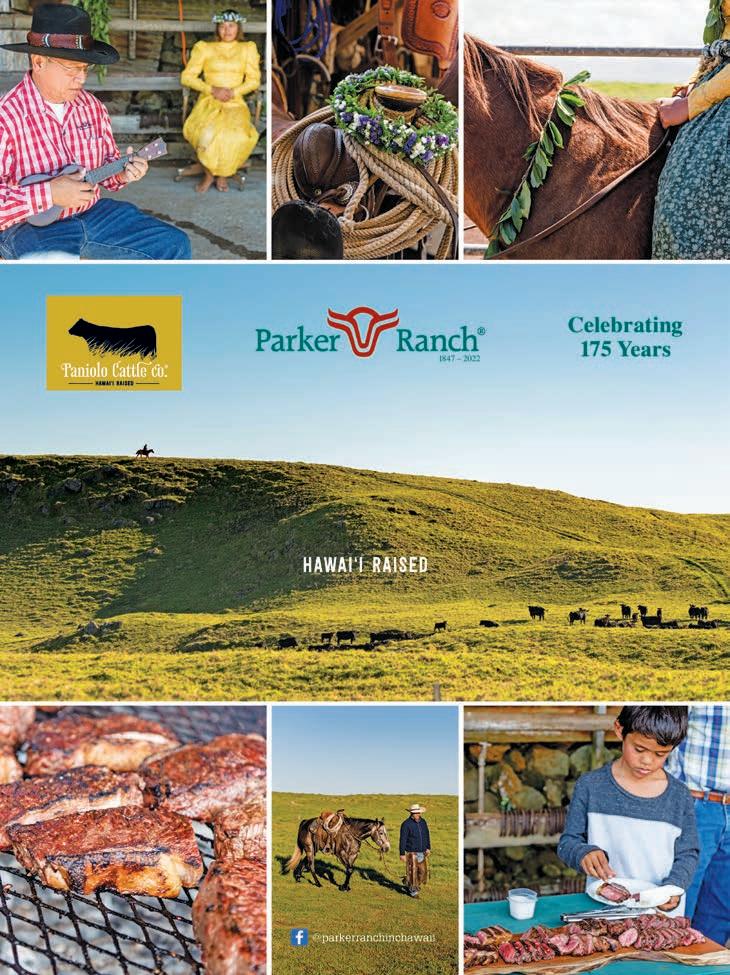
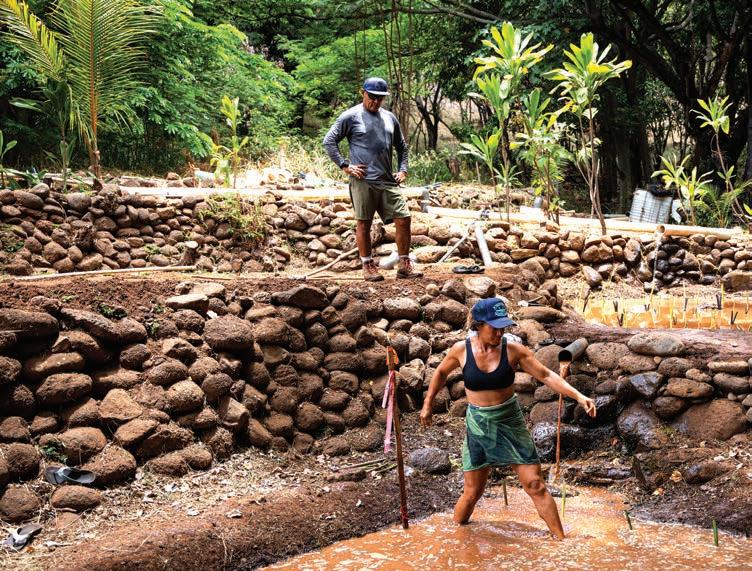
The pipe system the sailors rigged to the trees isn’t pretty, but it works.
By the summer of 2017, two lo‘i were ready for kalo. Nainoa Thompson, the head of the Polynesian Voyaging Society, attended the inaugural planting. Chad Babayan offered the pule (prayer). One by one, Kalepa and the others plunged knee-deep into the soft, cool mud. For the first time in more than a century, heartshaped kalo leaves bent in the breeze of Kahoma. For Kala Babayan, as a voyager, the act of planting food completed the circle. “If we didn’t have the ‘āina, if we didn’t have a place to grow food and trees for our canoes,” she says, “we literally would not be able to voyage.”
Kahoma’s waters replenished not just the taro patches. Mala Wharf’s corals began to flourish. Fishermen saw marine species that had been absent for years:
large schools of nenue (chub) and mullet. Native limu (seaweed) reappeared.
Despite these successes, the fight for water wasn’t over. In March 2019 someone shut off the valves upstream; Kahoma dried up overnight. Kamalu o Kahālāwai realized the precariousness of its position.
Meanwhile, the state Commission on Water Resource Management had just released its official assessment of Maui’s streams. The commission ranks each stream according to the quality of its aquatic, riparian, cultural or recreational resources and uses this ranking to determine interim instream flow standards—essentially what percentage of water can be removed. The commission initially gave Kahoma a low rating, citing few native species present and no real recreational value.
The report claimed that only one ‘o‘opu species occupied the stream.
Kamalu o Kahālāwai begged to differ. Dozens of people came to the public meeting to testify on behalf of the stream. “We’re a very strong community. When you put out the kāhea [call], people come,” says Lawrence. State aquatics expert Skippy Hau compared Kahoma favorably with Wailuku river, Maui’s largest waterway. Former Nature Conservancy fellow Kanoelani Steward, who assisted Hau in surveying multiple West Maui streams, recommended a 100 percent restoration of Kahoma and two million gallons per day to Kanahā. She had hard data to back up her recommendations. The state reevaluated its assessment, and while it didn’t grant Kahoma 100 percent undiverted flow, it did ensure enough water for mountain-to-sea connectivity.
50
Kalepa watches as Lawrence wades into the lo‘i during a community workday. Some of the lo‘i’s ancient stacked stone walls remained intact after Kahoma’s water was diverted in the nineteenth century, and many more remain unused higher up the valley. “The system is still here. The sites are still here,” says Lawrence. “They’re just waiting for us to bring life back to them.”
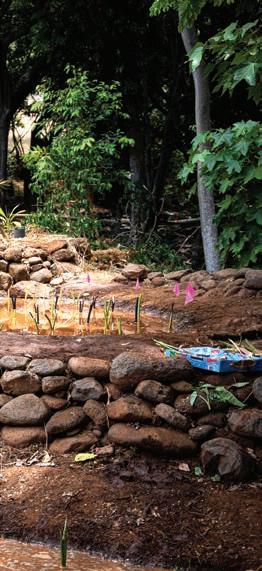
The stream would not run dry again.
“In the years that we’ve worked with this stream—watched it, monitored it and studied it, we’ve seen things we never expected,” says Kalepa. “It changed me as a person. I’ve come to realize that when we take care of the place, it will in turn take care of us.”
After a recent storm, Lawrence and Kala Babayan visited Kahoma to check on the pipe system. “This whole experience, the good and the bad, has really helped to ground me in who I am as a Hawaiian,” Babayan says. “Just being here today, how do you think our kūpuna feel? I think they are overjoyed and so happy.”
Lawrence nods, watching her 12-year-old daughter, Hinatea, plunge her feet in the bracing water. “Ola i ka wai,” Lawrence says. “Water is life.” hh
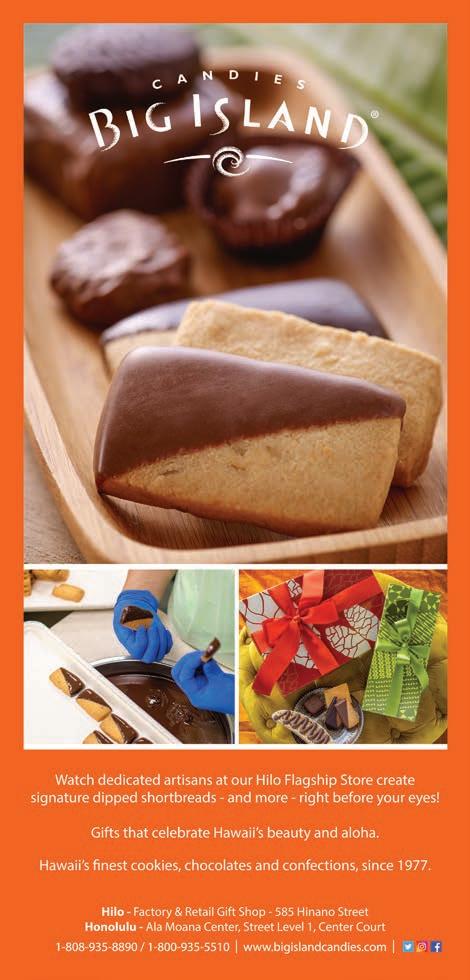
Reclaiming Pā‘ula‘ula
The deeply Hawaiian story of Kaua‘i’s “Russian fort”
Hawai‘i’s past lies written in stone, from magnificent heiau (temples) to the rubble and mortar walls of missionary churches to lava flows layered like the pages of a book. On the west side of Kaua‘i, perched on a promontory overlooking the mouth of the Waimea river, lies a ruin that tells the story of one of the more obscure chapters in that book of stone: Pā‘ula‘ula. Today there’s not much left of what later came to be called Russian Fort Elizabeth—the ruddy foundation stones roughing out the building’s shape, surrounded by dry grasses and invasive haole koa trees—but at one time Pā‘ula‘ula was among the most significant structures on Kaua‘i, both a fortress and a heiau that almost changed the course of Hawaiian history.
Constructed in 1816, Pā‘ula‘ula was a symbol of the power of Kaumuali‘i, the high chief of Kaua‘i, who intended to use it in a bold gambit to wrest control of Hawai‘i from King Kamehameha. But the story behind its construction and its rediscovery is filled with intrigue—of warring kings, merchant ships and Russian agents vying for power, wealth
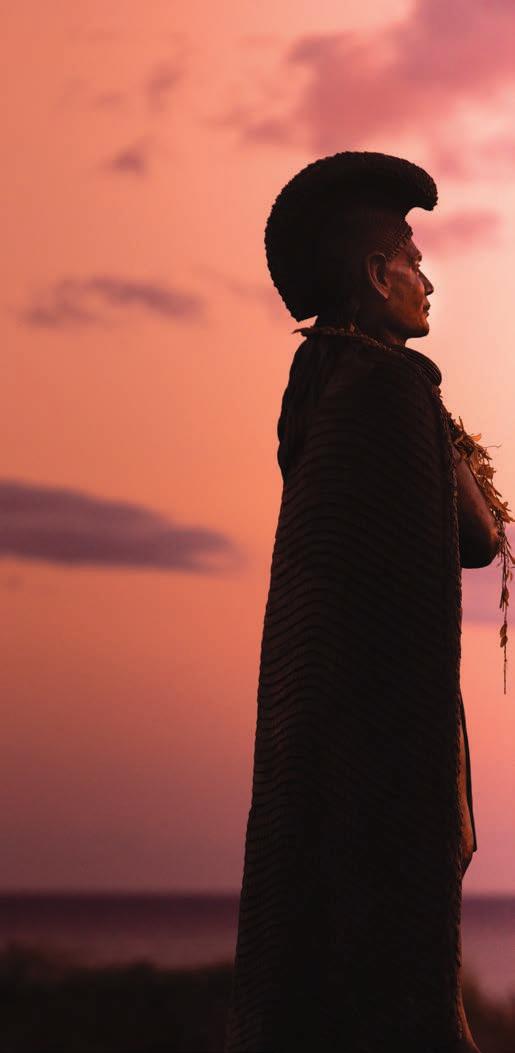
52 STORY BY PETER VON BUOL PHOTOS BY MIKE COOTS



Until recently called Russian Fort Elizabeth, Pā‘ula‘ula in Waimea was a fort and royal compound built on the site of a heiau (temple) in 1816. It was the largest stone structure on Kaua‘i at the time and the seat of power for King Kaumuali‘i, the chief of Kaua‘i. Above, a digital reconstruction of Pā‘ula‘ula as it might have looked in 1817, shortly after it was completed.
and prestige—a story that is still being rewritten today.
On January 31, 1815, a winter gale sent the Russian merchant ship Bering aground at Waimea, Kaua‘i, laden with valuable cargo: furs and winter provisions bound for Russia’s colony in Alaska.
The ship’s American captain, James Bennett, and its crew made it safely ashore and spent two months on Kaua‘i until an American ship arrived and gave them passage to New Archangel (now Sitka), Alaska, where the powerful trading enterprise, the RussianAmerican Company, was headquartered. Bennett angrily informed RAC chief manager Alexander Baranov that the Bering’s cargo had been impounded by the chief of Kaua‘i, Kaumuali‘i, and urged Baranov to retake it by force.
Baranov, however, took a more moderate approach: He would send a representative, Georg Anton Schäffer, to try diplomacy. A medical doctor fluent in multiple languages, Schäffer had an
impressive resume, including helping to develop a military balloon intended to assassinate Napoleon. But Baranov had bigger plans than just recovering cargo: He wanted Schäffer to establish trading relations with Hawai‘i, but that risked stepping straight into a conflict between the ruler of Hawai‘i, King Kamehameha, and his rival Kaumuali‘i.
In the early 1800s, British, Russian and American traders were crossing the Pacific, often stopping in Hawai‘i on their way to and from China, where they would sell furs and return with silk, porcelain and tea. The War of 1812 disrupted this lucrative trade and pitted the young nation of the United States against Great Britain. King Kamehameha, who had unified the Islands in 1810, was allied with Britain. To avoid capture by the British, American merchant ships sought refuge on Kaua‘i, where they knew Kaumuali‘i would protect them.
Kaumuali‘i was an unwilling subject of Kamehameha. In 1810, to avoid a
bloody invasion of Kaua‘i, Kaumuali‘i agreed to submit to Kamehameha’s rule. In return, Kamehameha permitted Kaumuali‘i to remain ali‘i ‘ai moku, or chief of the island of Kaua‘i—though still a vassal. While Kamehameha believed he had reached a lasting agreement, that wasn’t the case for Kaumuali‘i.
“What people leave out of the history, because it makes it messy, is that during the War of 1812 Kaumuali‘i had broken away from Kamehameha and stopped paying a tribute,” writes Peter R. Mills, professor of anthropology at the University of Hawai‘i-Hilo, in his 2002 book Hawai‘i’s Russian Adventure. “That is very clearly documented in several ships’ journals in 1814, before the Russians ever show up.”
Emboldened by the presence of the American traders, Kaumuali‘i began openly defying Kamehameha. In April 1814 three American sea captains pledged their “friendship and protection as far as lay in their powers, at all times” to Kaumuali‘i. But six months later the
54
COURTESY DR. ALEXANDER MOLODIN AND DR. PETER R. MILLS
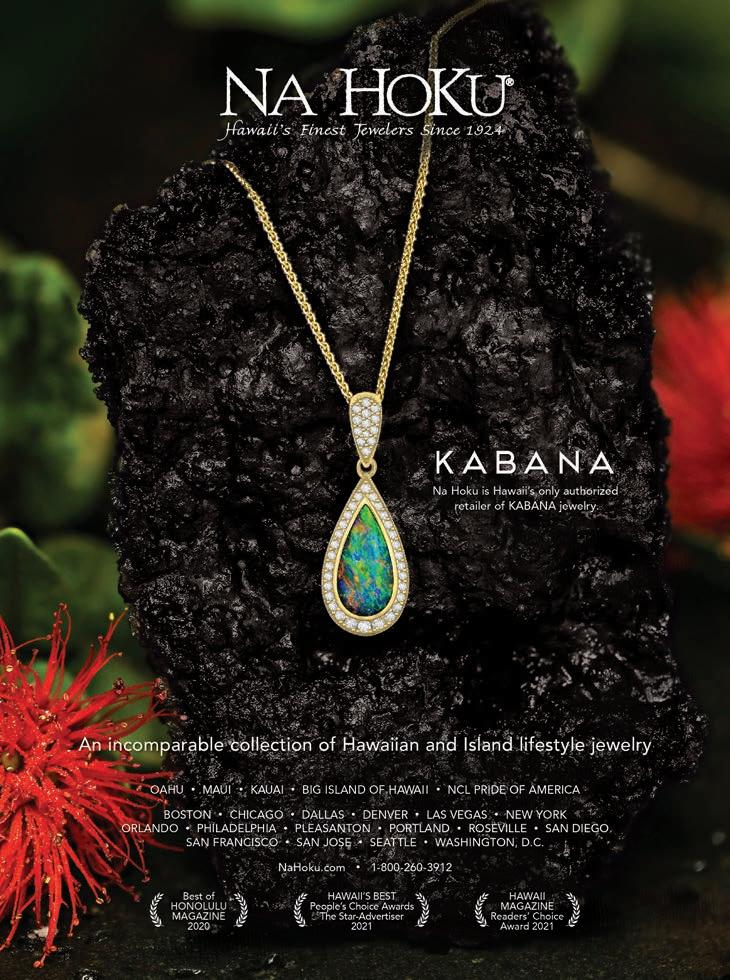

Though it was the result of Russian involvement with the Hawaiian Islands in the nineteenth century, Pā‘ula‘ula was built by Kaumuali‘i, in part to counter King Kamehameha’s power. “Russians were not the primary builders, and they never occupied the fort,” says University of Hawai‘i-
professor
built it and occupied it for forty-three years.” A statue of Kaumuali‘i (seen above and on page 52), was dedicated at the site in 2021.
war was winding down, the Pacific trade resumed and the Americans sailed off, leaving Kaumuali‘i without foreign alliances and vulnerable to Kamehameha’s retribution.
So when the Bering washed ashore in 1815, a matter of weeks after the last American ship departed, Kaumuali‘i saw an opportunity. “This Russian-American Company vessel wrecks on his shore, in front of his very own house, and he takes all the material,” writes Mills.
Schäffer departed Alaska aboard an American ship in October 1815, posing as a naturalist on a “scientific mission.” Baranov wanted a clearer understanding of the political dynamics in the Islands, so he directed Schäffer to meet with Kamehameha, then Kaumuali‘i. “His instructions stipulated that only after he gained the trust of Kamehameha or Kaumuali‘i, or both, was he to negotiate the return of the Bering’s cargo or request any restitution. Both
his arrival on a non-Russian vessel and his introduction as a naturalist gave Schäffer’s mission a peaceful appearance,” writes Mills.
Schäffer met Kamehameha in November 1815, but not everyone was buying the doctor’s cover story, including English-born John Young, one of Kamehameha’s most trusted advisers. Fortunately for Schäffer, both Kamehameha and his queen, Ka‘ahumanu, needed medical attention: He treated the king for a heart condition and the queen for yellow fever, which helped advance his plan.
Baranov had told Schäffer to give the king a letter once he’d gained his trust, explaining that his company wanted to reclaim lost cargo on Kaua‘i. Recognizing Kamehameha as the sovereign of all Hawai‘i, Baranov’s letter asked the king for permission to use force. While Kamehameha had treated Schäffer well, giving him a house on Hawai‘i Island and land in Honolulu to build a storehouse for the RAC, Young
saw trouble and the king refused to aid Schäffer in his recovery effort.
In spring 1816 three Russian ships arrived, and Schäffer escaped an increasingly tense situation on Hawai‘i Island. Sailing for Kaua‘i, Schäffer would not be incognito: He was coming as the agent of a powerful European company aboard an armed vessel and prepared to use it. But that turned out to be unnecessary: Upon arriving in Waimea, Schäffer was surprised to find that Kaumuali‘i had already sent a significant portion of the Bering’s cargo to Alaska and planned to return the rest. He agreed to pay restitution in sandalwood for any items that had disappeared.
Kaumuali‘i had not only defused a potent ial conflict, he had gained an ally. He noted that the Russians, unaccompanied by Kamehameha’s men, “could be used to protect his chiefdom from Kamehameha,” writes Mills. But Kaumuali‘i didn’t intend to stop there. He hoped the Russians might help him take back the islands
56
Hilo
Peter R. Mills. “Hawaiians

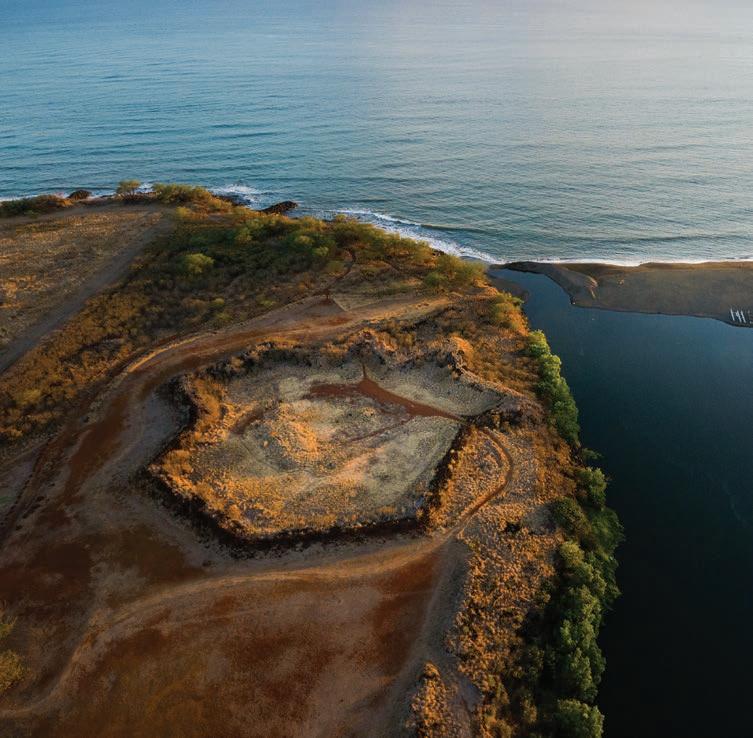
that Kamehameha had seized.
Coincidentally, in a repeat of what had happened with Kamehameha and Ka‘ahumanu, Kaumuali‘i and one of his wives needed medical attention, and Schäffer treated both. Schäffer offered support in helping Kaumuali‘i regain his sovereignty—not only from the Russian-American Company but also,
surprisingly, from Imperial Russia. In May 1816 they signed an agreement placing Kaua‘i under Russian protection. During the ensuing ceremony, says Mills, Kaumuali‘i raised a Russian-American Company flag next to his residence.
The pact was further cemented with a ceremonial offering, according to an official report from July 1817 co-written
by four Russians who participated.
“After the contracts were concluded with the Russian-American Company, they constructed, as a sign of gratitude, a new ‘morea’ or temple, and made sacrifices of various kinds—fruits, and, if reports are correct, two men,” they wrote.
“This may be the last reference to human sacrifice recorded for Kaua‘i,
58
Pā‘ula‘ula (“red fort”) as it looks today, on the east bank of the Waimea river. The name, says Mills, “is the term Hawaiian soldiers stationed at the fort used. We know this from written documents and family histories. There’s no record of Kaumuali‘i ever using the name ‘Fort Elizabeth.’”

and it came when Kaumuali‘i was considering reconquering other islands,” writes Mills.
According to Mills, the 1817 report’s use of the plural, “contracts,” might refer to a second, secret treaty stipulating that Kaumuali‘i would provide five hundred people to conquer O‘ahu, Lāna‘i, Maui and Moloka‘i. Schäffer would provide ships


and weapons in exchange for sandalwood. Schäffer also agreed to oversee the construction of new forts—one of them on the east bank of the Waimea river, on a spot where a heiau stood.
Construction began on September 12, 1816. Schäffer designed the starshaped fort, and Kaumuali‘i’s wives were among the hundreds of Native Hawaiians who labored to build it. “Pā‘ula‘ula was a nineteenth-century amalgam of Hawaiian and European monumental architecture,” Mills says, “a combination of a heiau and a European fort; the former was imbued with ritual, the latter with military strategy, and both with social control.” Mills suggests the location on the sacred eastern bank of the Waimea river indicates that the fort was a “dynamic interpretation” of a traditional war temple, imbued with spiritual significance and symbolism—not a purely utilitarian Western-style military fortification. Mills believes Pā‘ula‘ula was also intended to serve as a counter to Pu‘ukoholā, Kamehameha’s massive war heiau on Hawai‘i Island.
Construction continued at least through December 1816. Once complete, the octagonal fort was huge by contemporary standards, measuring 450 feet across, with walls 20 feet high and 15 feet thick—the largest stone structure ever built on Kaua‘i until then.
Schäffer’s achievement would be short-lived. Just as the fort was being completed, the Russian naval brig Rurik appeared in Honolulu, and Schäffer’s alliance with Kaumuali‘i quickly unraveled. The Rurik’s
commander, Lt. Otto von Kotzebue, assured Kamehameha that Imperial Russia had no intention to conquer Hawai‘i. Kotzebue made it clear that he wanted nothing to do with Schäffer and would not sail to Kaua‘i. To Kaumuali‘i this was evidence that the RussianAmerican Company did not really back Schäffer. While the chief remained cordial, Schäffer no longer received military salutes. The Russian-American Company flag came down. In June 1817, Schäffer left Kaua‘i.
While Kaumuali‘i’s dream of conquest went unfulfilled, he managed to distance himself from what has come to be called the Schäffer affair and retain control of Kaua‘i, due in part to Pā‘ula‘ula. “Kaumuali‘i used this resource to his full advantage, practicing military protocol of the period, firing cannons to salute ships and conspicuously displaying his mana,” or spiritual power, says Mills. Visiting merchant captains described the fort as an impressive feat of military engineering.
For about forty more years, Pā‘ula‘ula continued to symbolize the power of the kingdom of Hawai‘i. Even after it was obsolete militarily, guards remained posted. But by 1864 it was closed and the last of its cannons removed.
Pā‘ula‘ula became a forgotten landmark in a remote area of a remote island. A government surveyor, Capt. George Jackson, created the first detailed map of the site in 1885. Drawn nearly seventy years after its construction, he described it as a “Russian fort” and guessed at what the ruin represented. His offhand description would leave a lasting impression: Pā‘ula‘ula became associated with a failed attempt at Russian colonization and was no longer understood to be the impressive heiau built by Kaumuali‘i.
Until the 1960s the site was surrounded by cane fields but remained open to the public. In 1962 the fort and its surrounding seventeen acres were acquired by the State of Hawai‘i, and it was added to the National Register of Historic Places. Unfortunately, the name Jackson assigned stuck, and it was listed on the register as “Russian Fort.”
When it became a state park in 1972, a new name emerged: Russian Fort
Elizabeth State Park, based on a name Schäffer recorded in his journal in honor of the empress of Russia. But few had called it that, and the name would lead many to believe it wasn’t a culturally significant Hawaiian site. Because it has long been associated with Russian colonizers, Mills says, Pā‘ula‘ula hasn’t been treated with the same reverence as other Hawaiian sites.
Waimea historian Aletha Kawelukawahinehololioolimaloa Goodwin Kaohi, executive director of the West Kaua‘i Heritage Center and president of the Waimea Sugar Plantation Museum, offers guided walking tours at Pā‘ula‘ula and, like Mills, believes it deserves more recognition. She has long been campaigning to restore its Hawaiian name. “There is reason to believe that Jackson did not intend to officially designate the site as a Russian fort. It was merely a notation on his maps,” says Kaohi, who is herself a descendant of Kaumuali‘i. “In truth, the Russian experience on Kaua‘i was limited to two short years, hardly enough time to give it a prominent place in Hawaiian history.”
Kaohi isn’t alone: Last March, vandals blacked out the word “Russian” on the site’s signage, which at the time read “Russian Fort Elisabeth” (the spelling meant to reflect the softer Russian pronunciation of Elizabeth, says Mills). In a bizarre twist, the name change became a flashpoint in Russian-American relations; it was met with resistance from Russians and Russian-Americans, one of whom, Elena Branson, was indicted by the US Department of Justice for acting as a secret Russian agent—a development that only accelerated the effort to change the site’s name. On June 14, 2022, a little more than a year after an eight-foot-tall statue of Kaumuali‘i was unveiled at the site, the state Board of Land and Natural Resources approved the measure officially changing the name to Pā‘ula‘ula State Historic Site. The National Park Service is working to change the name on the National Register as well.
“Pā‘ula‘ula is imbued with sacred history,” says Kaohi. “It had been Kaumuali‘i’s royal compound, and it was where a heiau had stood in the past. It was much more than a ‘Russian fort.’” hh
60
Aletha Kaohi, seen above, helped lead the effort to rename the site and recover its Hawaiian history.
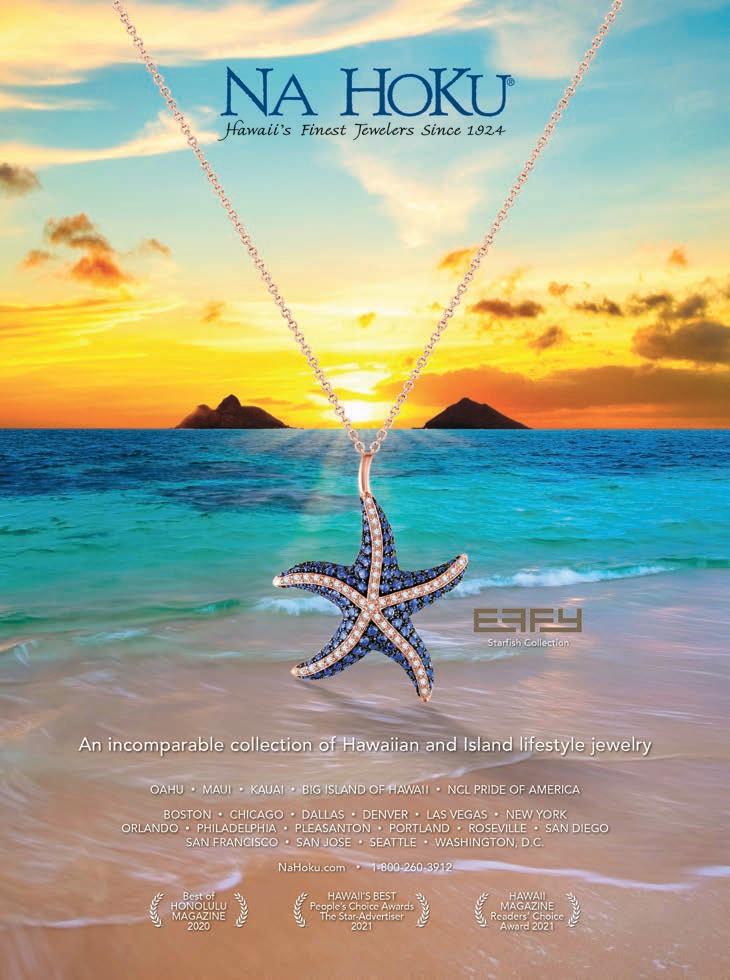
Science of the People
For environmental scientist Greg Asner, research only confirms what Native people have long understood

62
STORY BY MEGHAN MINER MURRAY PHOTOS BY ANDREW RICHARD HARA

Greg Asner isn’t your average scientist. His formal CV is fifty-six pages long, listing 850 peer-reviewed scientific publications and books, the names of more than five dozen doctoral and post-doc student advisees, several patents, numerous awards—including the Heinz Award for the Environment in 2017 (think the Heisman Trophy for environmental science)—as well as numerous conference speeches and movie and television appearances.
Following a 2019 stint on the television docuseries Judi Dench’s Wild Borneo Adventure, Asner dismissed rumors he was dating the Dame (he’s happily married to his colleague and research partner, Robin Martin). In August 2021, Pope Francis invited Asner to meet and discuss sustainability and climate change. Asner has developed and launched satellites. He casually calls the multimillion-dollar Global Airborne Observatory he invented “my plane.” The GAO can map a forest down to an individual tree’s branches or peer through water to identify individual coral heads from high in the sky. The aircraft is widely considered to have the most advanced mapping technology outside the government sector. Of the kittedout boat parked on his property, Asner offhandedly remarks, “Jim Cameron bought me this boat.” That would be, yes, director/explorer James Cameron.
To say Asner is at the top of his game as a respected sustainability scientist is an understatement. He’s one of the most prolific conservation and climate scientists on the planet, renowned for developing new technologies to study biodiversity, carbon cycling and ecosystem resilience. His work has spanned 137 countries. Few scientists, especially one as young as Asner, achieve such notoriety or have access to such advanced technology. So why has this researcher of global import established himself on the remote South Kona coast, in the tiny Native Hawaiian fishing community of Miloli‘i?
At 54, Asner maintains a militaryfit physique, a holdover from his time as a Navy diver, which first brought him to Hawai‘i from Maryland in 1986. Enamored with the Islands, he stayed to work for the University of Hawai‘i at Mānoa and for the Nature Conservancy on Moloka‘i, then headed to Hawai‘i Island in 1995; by 1997 he was measuring corals in Miloli‘i. He pursued his doctorate at the University of Colorado, Boulder, where he focused on gathering data to help manage the Amazon, yet did so mostly remotely, spending the majority of his time in Hawai‘i. In 2001 he joined the Carnegie Institution but maintained his base in Hilo, where he created a slew of new technologies for data collection and mapping.
“I often tell people I was born on the Mainland and was awakened in Hawai‘i,” Asner says. That awakening continues in his current position as director of Global Discovery and Conservation Science at Arizona State University; part of his job is to expand ASU’s presence on Hawai‘i Island, and Miloli‘i is the epicenter of that effort. In a 2021 TEDx Talk, Asner remarked that many of his important ideas were “born, raised and applied in Hawai‘i.” He hopes to make Hawai‘i Island a sort of campus/ proving ground—a new type of academic environment, where science can help address the immediate, real-world problems in the communities where it’s being conducted.
All that makes Miloli‘i, where Asner has based his research for the past fifteen years, an ideal campus/proving ground. While the village residents have sought to preserve their Native Hawaiian culture and traditions, Miloli‘i is experiencing the myriad environmental problems that rapid development brings, some of which affect the reefs that the villagers depend upon. In 2017, using prize money from the Heinz Award, Asner founded a nonprofit and built a facility at the edge of Hawai‘i’s “last fishing village”—a community bound
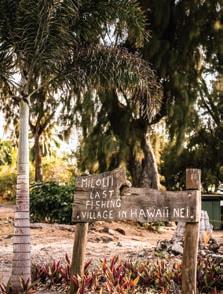

Mapping ecosystems and tracking their response to climate change has earned Greg Asner (seen on the opening spread right) international renown. But it’s through his enduring and special relationship to Hawai‘i, in particular the remote fishing village of Miloli‘i (seen opening spread left), that he feels big science can help make a difference at the local level. At right, Asner talking with Miloli‘i community leader Ka‘imi Kaupiko (far left) and Taha‘a Kahele about how Western science can support and affirm indigenous knowledge. Above, Asner with (left to right) Kaupiko, Carol Kahele and Taha‘a.
64
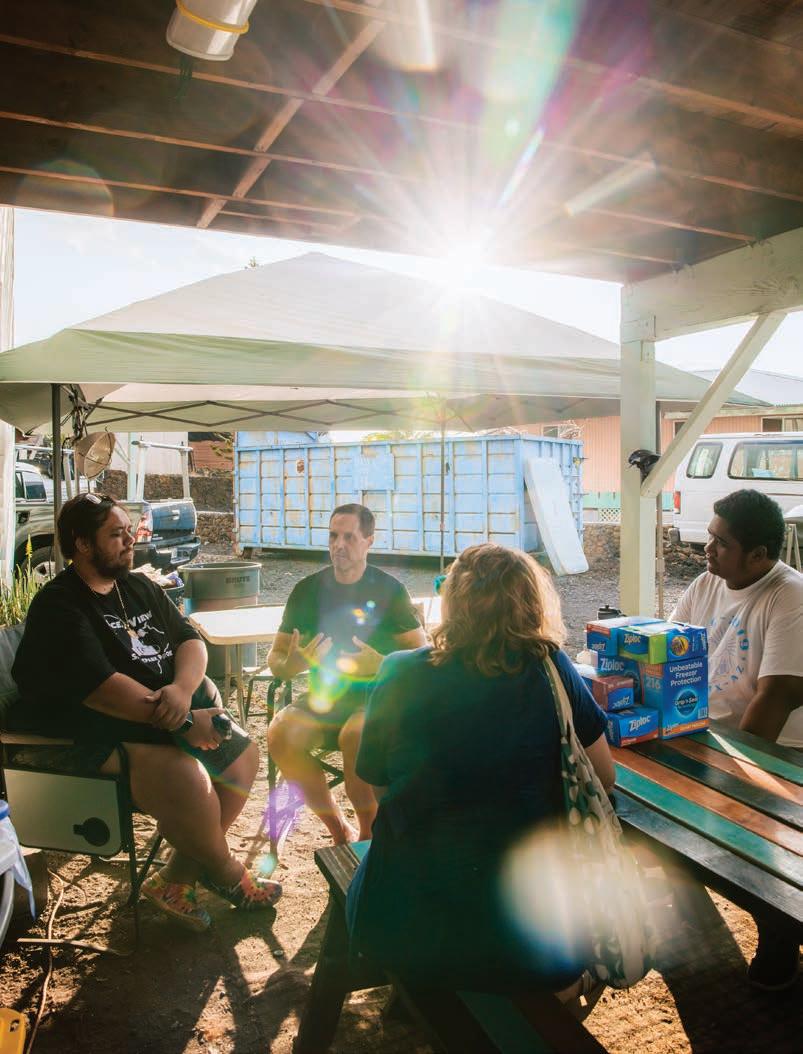
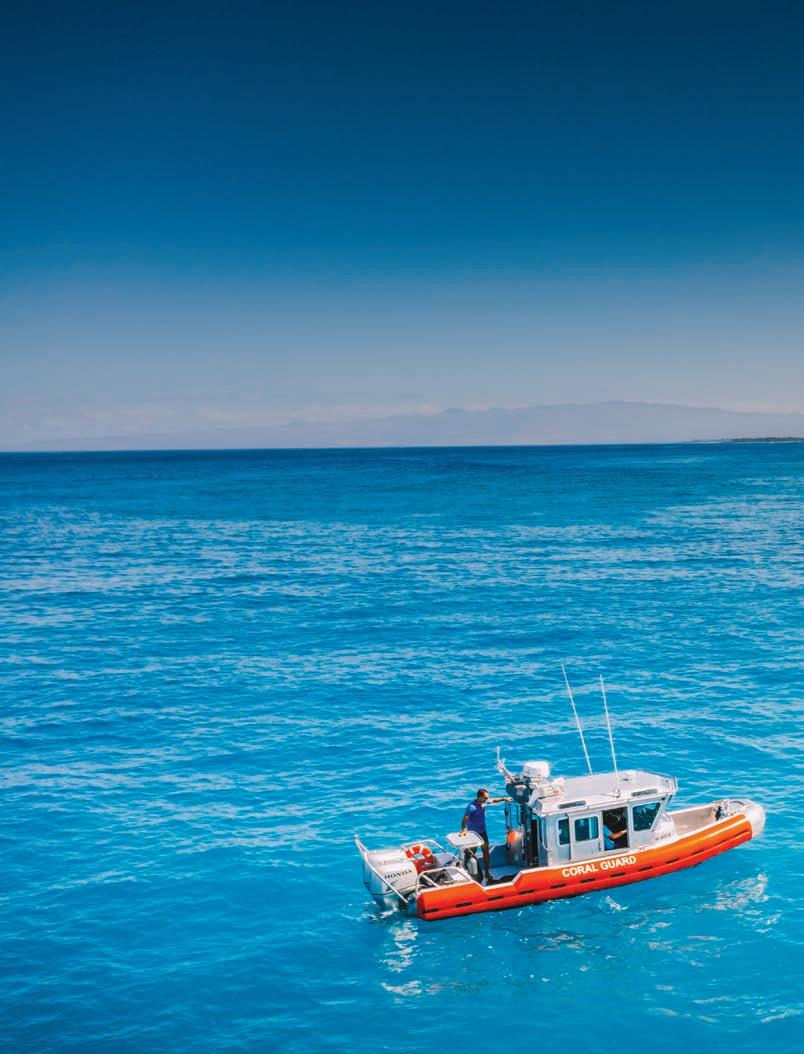

to the land, to the sea and to each other by centuries of history. It might seem an unlikely place for a scientist of such renown to set up shop, but if you ask Asner, it’s the most fitting.
On a recent visit to his center in Miloli‘i, constructed to blend in with the area’s residential buildings, Asner gives me a tour of the gear room, a meticulously clean, hangar-like space smelling of epoxy and neoprene and filled with gadgetry. He gives me a simplified summary of the dizzying scope of his work: Asner and his Hawai‘i-based team conduct shoreline and forest mapping as well as monitor coral and fish populations throughout the main Hawaiian Islands. His other projects—the Allen Coral Atlas, an online map of the world’s reefs, and the Global Airborne Observatory—are planetary in scope, but Miloli‘i gets special attention.
Asner’s work in Miloli‘i isn’t just about water sampling and reef surveys. He also runs the Hawai‘i Marine Education and Research Center (MERC), a nonprofit he cofounded with his wife, where residents can get support for their own marinerelated initiatives. For example, the village’s Makai Watch, which patrols the reef to stop aquarium fish poaching and shark finning, often monitors the coast from the building at night. MERC also connects the isolated village to the wider world: It’s a place where youth can find mentorship, internships and jobs beyond the village and learn what it’s like to conduct scientific research. Perhaps most important, the center gives residents a means to share their ancestral knowledge of the area’s marine resources with government managers.
Both of Asner’s roles—as the head of MERC and ASU’s programs in Hawai‘i— are part of a larger, fairly radical plan: “to ensure that science is conducted in service of community,” he says. Within a typical university system, “the science community is kind of in service to itself, and that’s really bad. … Why is the science so important if it doesn’t
help humans?” Conversely, in Miloli‘i, he says, “It’s about the people and this place—how important this place is in its own right, but also how it can be a model for how we take care of one another and the planet.”
The recent boom of residential construction in Miloli‘i makes it both a microcosm of what’s happening to indigenous communities worldwide and an ideal place to explore how local knowledge can inform sustainability science—and how that science can be used, in turn, to support those communities. Asner hopes his “experiment,” as he calls it, will inspire other scientists to do the same. But that’s an uphill climb: There isn’t much support within the scientific community for including local knowledge. When he gave his TEDx Talk in 2021 about tapping traditional knowledge to prepare for climate change, “Most of the pushback I received came from the science community,” he says. “They were like, ‘Nah, management has gotta be science- and technology-based.’”
But, he points out, Native Hawaiians have been employing hyper-local land-tosea stewardship strategies for centuries. “They don’t need ‘help’ from scientists,” Asner says. “They need partnering.” Modern resource management tends to be more general than local, with regional or statewide mandates created by managers often far removed from the systems they oversee. “Some days I get in the water and I go, ‘Man! The fish biomass is low today!’ And I’ll mention it to somebody in the village and they’ll tell me exactly why. They’ll say, ‘Well, it’s because the tidal cycle is this, we had king tides three days ago and the moon is over here.’ Hawaiian knowledge includes daily, lunar, solar and tidal cycles of the fishery. Science doesn’t know that. And I go, ‘Wow, you blew my mind, Uncle! You blew my mind, Auntie!’ It’s amazing. It gives you chicken skin. They really know the system because they are the system.”
Miloli‘i residents know their reefs down to individual crevices and coral
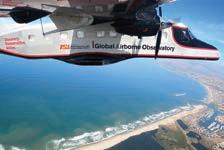
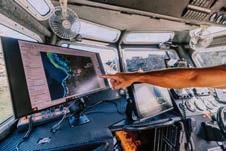
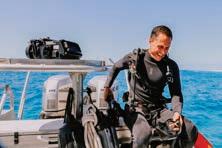
at his disposal. On the facing page, Asner, a former Navy SEAL, dives from Coral
, a retrofitted military vessel (seen also on the previous spread). Above top, Asner’s Global Airborne Observatory, a research plane outfitted with technology that can pick out individual coral heads and tree branches from the sky. Above middle, Coral Guard’s Graphic Information System generates a map showing the impact of wastewater effluent from land on Miloli‘i’s reefs.
68
A scientist of Asner’s stature has a few toys
Guard
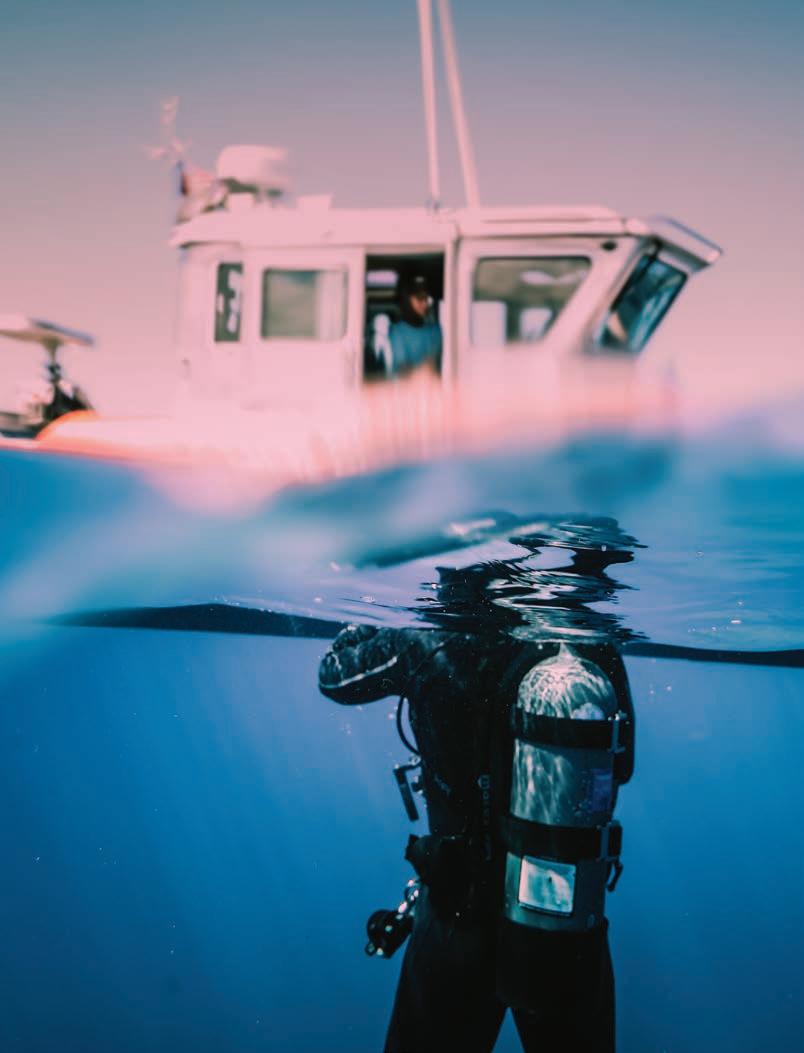
heads, but government scientists tasked with managing the fisheries and the coastline often don’t have access to such direct, intimate knowledge. The state Division of Aquatic Resources “has only one long-term research, long-term measurement site,” Asner says. “And they’ve historically come twice a year, I believe, to that site. And it’s like, but every day is different!” Asner is quick to point out that this isn’t the fault of government scientists. “They are really understaffed. We have 1,200 kilometers of coastline in the eight main Hawaiian Islands, and DAR has fewer employees than I have in my ASU unit. They can’t be expected to know about and manage fisheries on that fine a scale,” he says. “But we’ve got to fix it by having community knowledge compensate for the sparsity of government capability to create a different future.”
For generations the residents of Miloli‘i managed their coastal resources sustainably.
But over the past few decades, they’ve butted heads with outside managers and enforcement agents, who visit a few times a year to collect data and establish rules. For decades the community has been fighting for the right to steward their ancestral waters. Thanks to their tireless work, the state designated eighteen miles of Miloli‘i’s coastal waters as a Community-Based Subsistence Fishing Area (CBSFA), a fairly new type of public/private partnership regime, in 2005. There is currently only one other CBSFA in the state: at Hā‘ena on Kaua‘i, established in 2015, where local and indigenous people collaborate with the state to manage that beautiful and sensitive coastline. But it took years to hash out the specifics for Miloli‘i’s CBSFA, and it wasn’t until this past August—thanks to continued work by Miloli‘i families supported by many groups including Asner’s MERC—that Gov. David Ige signed into law the plan to sustain this vast stretch of intact reef, co-managed
by the Miloli‘i community and the state. Ka‘imi Kaupiko, a traditional fisher, teacher and community representative, was initially skeptical of Asner when he arrived fifteen years ago. “When I first met you, I wasn’t really sure,” he tells Asner as we talk just before sunset outside Kaupiko’s home. Ka‘imi’s father, Willy Kaupiko, a community leader who’s nicknamed “the Mayor of Miloli‘i,” “was very hesitant with a lot of the science,” says Ka‘imi, a sentiment shared by much of the community. “Most of us are subsistence fishermen who love to work from our own observations of the reef. That’s how we’ve survived off of it. Our way is our science.” After getting to know Asner’s work, though, “I was thankful,” Kaupiko says, “because it was really important for what we were trying to do: to create this management plan for Miloli‘i. It’s been our dream for a long time—since I was little.
“Greg helped us understand why what we’re observing is happening, and that’s been a huge awakening—to really invest in using the data you guys have shared.” Asner chimes in: “We are just putting numbers to what you already know.” The community had been voicing concerns about issues like declining fish populations for years, “But you put numbers on it and suddenly the Department of Land and Natural Resources goes, ‘Oh! We do have a decline!’” Asner says. “Our science is backing that up—that the community always knew what they were doing.”
From Kaupiko’s point of view, these efforts are all in service righting a larger historical wrong. Before the overthrow of the Hawaiian monarchy in 1893, he says, “We had our own identity, our sovereignty. We could feed each other and take care of this place for that. When the overthrow took place, it flipped the whole place upside down, because now we are going to a Western system that is not very pono [right, proper] to how our kūpuna [ancestors] would manage the entire ahupua‘a,” the Hawaiian term for traditional land divisions typically stretching from the
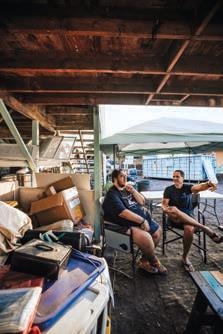
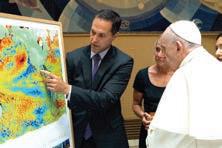
Above bottom, Asner talks with Pope Francis in 2021 about the Allen Coral Atlas, a massive project Asner directs to map the world’s reefs and monitor the impact of climate change. On the facing page, Asner measures the chemistry of corals off Miloli‘i undergoing a marine heat wave, with a device he created that uses spectroscopy so he can avoid contact with the vulnerable, heat-stressed corals.
70
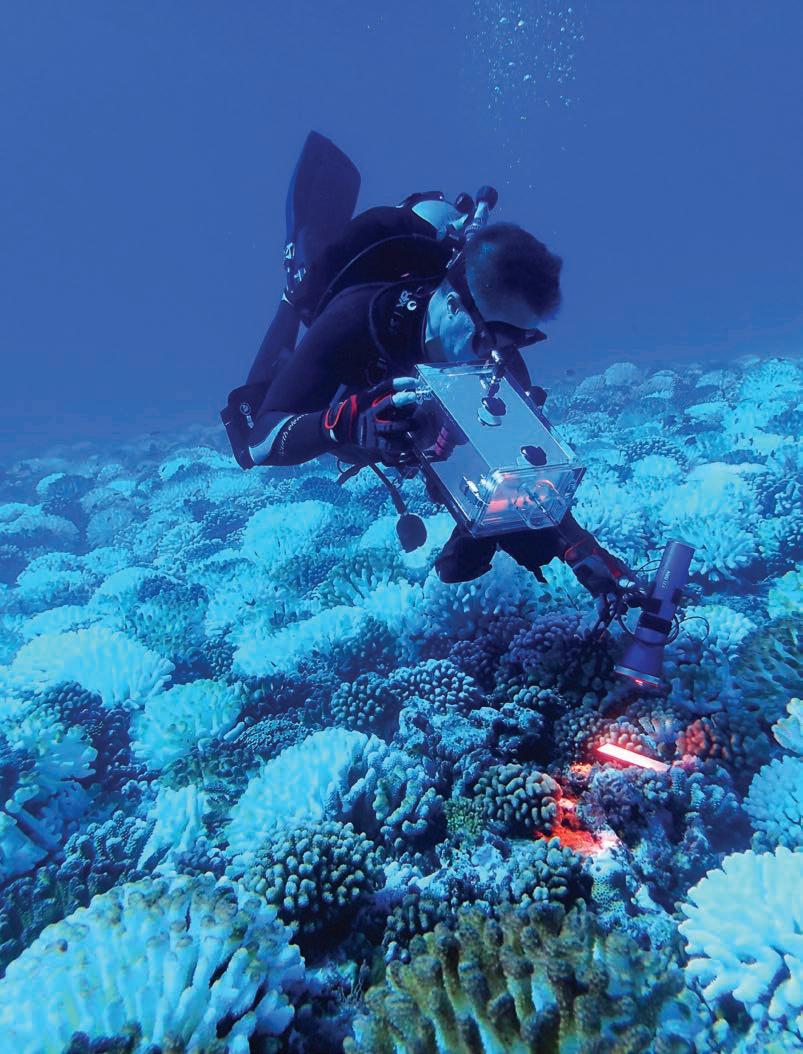
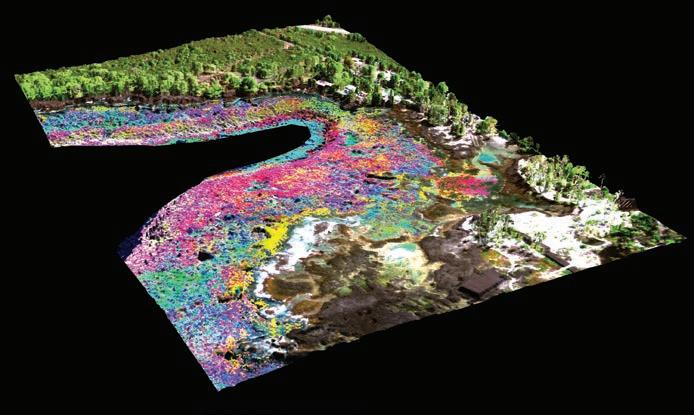
mountain peaks to the ocean. “We were so disconnected because we didn’t have our place, we didn’t have our language. Today we are doing the work. We’re getting information from Greg and his team—and others who have been here for longer—which helps us understand the Western, biological view of what’s going on in the ocean. We feel comfortable that they are not here just to tell us what to do; they’re here to support us. Our narrative is important because we are the people who will steward this place.”
When Ige signed the CBSFA designation into law during a ceremony at Miloli‘i on August 2, 2022, it was “the biggest thing for us as a people trying to figure out our identity,” says Kaupiko, “because our whole life is around
fishing. It’s critical at this time in our journey as a community to make sure that what our kūpuna did will continue. Our next generation will be able to carry on this work. Seeing this happen makes us feel that we can take ownership, that there’s hope for the future.”
Later, zipping around on Asner’s boat, a speedy, modified Coast Guard vessel, he relaxes. He pops the top on another can of UCC brand canned coffee (“my biggest vice,” he says) and half-jokingly discusses plans to mount Super Soaker water guns on the former (real) gun mounts before reflecting on his team’s work, both in Miloli‘i and in the wider world.
For many scientists, research directed toward a specific legal
outcome, like a CBSFA designation, would be a big no-no. There’s a view that scientists should present good data, not interpret it or promote policy solutions. But Asner, having reached the peak of his career, has the freedom and credibility to buck that view. “The best management comes from the communities, because outside managers don’t have the intergenerational knowledge,” he says. “Why does science think it can figure out some other way that’s more universal, when the system evolved with people? If you focus on communities—who you’re really doing the science for—you’ll actually look at the data not differently, but with the knowledge that your science will have an even greater impact.” hh
72
Above, a spectrographic map of the reefs at Hōnaunau, Hawai‘i Island, the world’s first map of coral biodiversity, from data collected using Asner’s Global Airborne Observatory.

Country Road Cruising the North Shore Bike Path

74
WORDS BY BEAU FLEMISTER
PHOTOS BY ARTO SAARI

Some roads must be walked to truly understand them. Paris’ Champs-Élysées, Rio’s Copacabana boardwalk, Havana’s lively Malecón seawall—and the North Shore bike path. Running 3.5 miles from Waimea past Sunset Beach, the paved trail runs through a tunnel of trees between Ke Nui Road and Kamehameha Highway, with access to some of the world’s best surfing. Nothing else in sports can compare; it’s like pedaling a beach cruiser by a Wembley Stadium, then a Fenway Park, then a Madison Square Garden every fifty yards. In terms of star power, it’s the surfing equivalent of bumping into Kevin Durant, Michael Jordan and Steph Curry in a span of ten minutes. But it’s also a residential thoroughfare. Yes, it connects champion surfers and big-wave greats to their arenas, but it also provides families safe passage to school, a place for neighborhood kids to adventure. It connects friends and lovers, it’s a place to share loose shakas and watufakas. Indeed, to truly understand the path, you have to walk it, as North Shore resident and photographer Arto Saari has done, capturing the vibe and vivacity of the thin asphalt thread connecting this fabled coast.
OPENING SPREAD LEFT
“The bike path is special,” says pro surfer Shayden Pacarro. “When me and my family were living near Velzyland, we’d always hit the path and go cruise together—it was like our family outing. Plus, during COVID, with not being able to do big gatherings, the bike path was such a healthy alternative to being social. You could see everyone in passing, you know? Like, ‘Ho, howzit, kden!’ … but you’re still moving. It was a cool little healthy party on the path.”
OPENING SPREAD RIGHT
“The bike has been my way of transportation my whole life until I could drive—and I still normally just ride my bike,” says pro surfer Zoe McDougall. “Growing up on the North Shore, I rode my bike to school every day, packing my friends on the handlebars, going to surf—I’ve probably spent more time on the bike path than I have in my home. You can’t be on the path without seeing someone you know—everyone in the neighborhood knows each other from the bike path, even if you don’t surf.”
FACING PAGE
One end of the path is at Waimea, and the other at Velzyland. In between it parallels the coastline, passing more than a dozen world-renowned surf breaks. Above, a surfer strolls up the beach after surfing “the Bay,” as it’s called, on one of the biggest days at Waimea last winter.
FOLLOWING PAGE
A posse of North Shore groms (young surfers) travels the path with the usual paraphernalia necessary for a North Shore adventure.
76
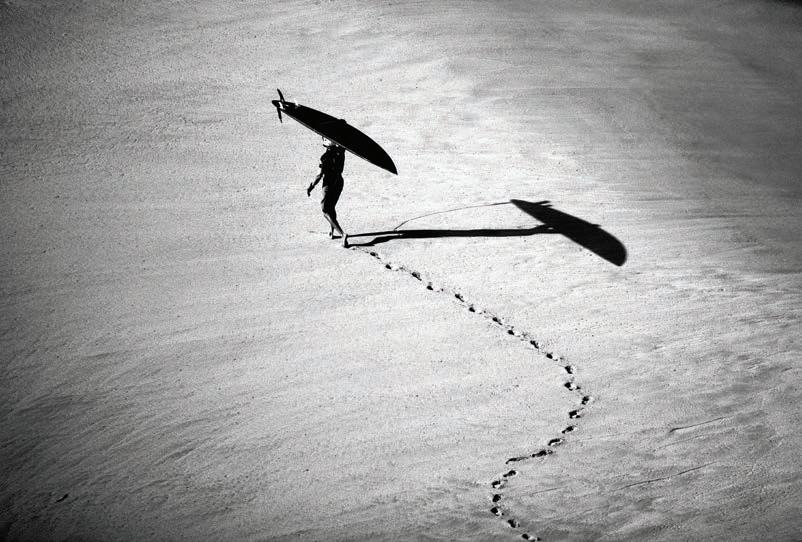
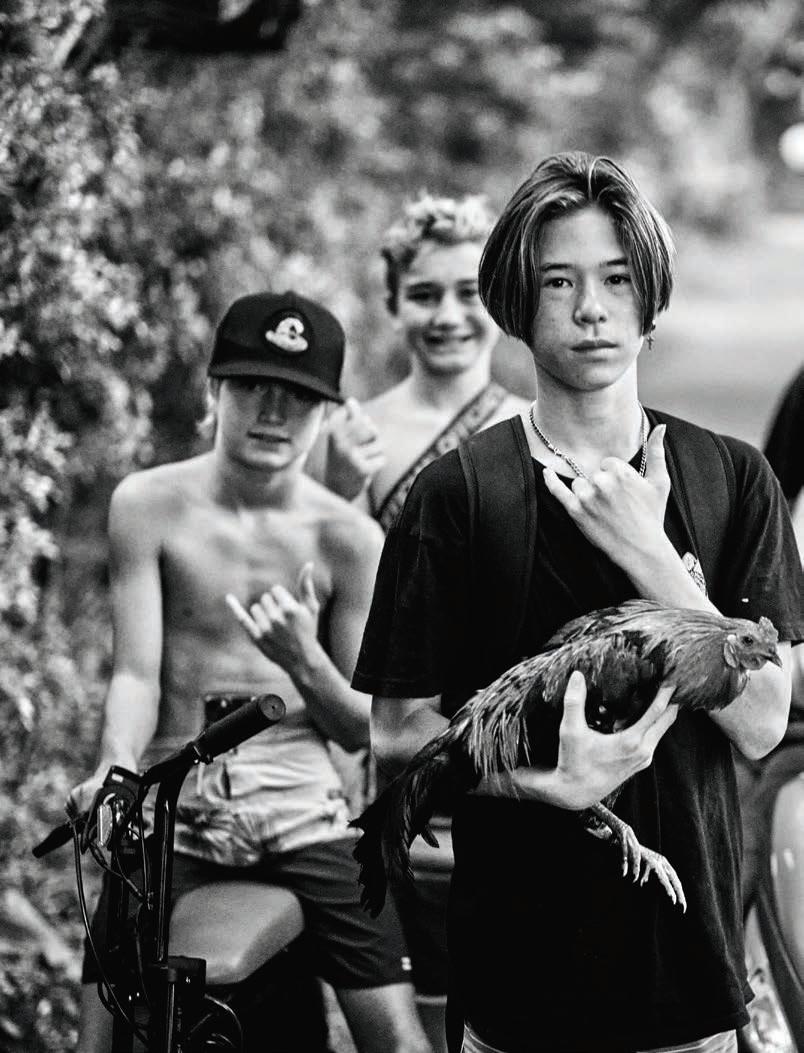
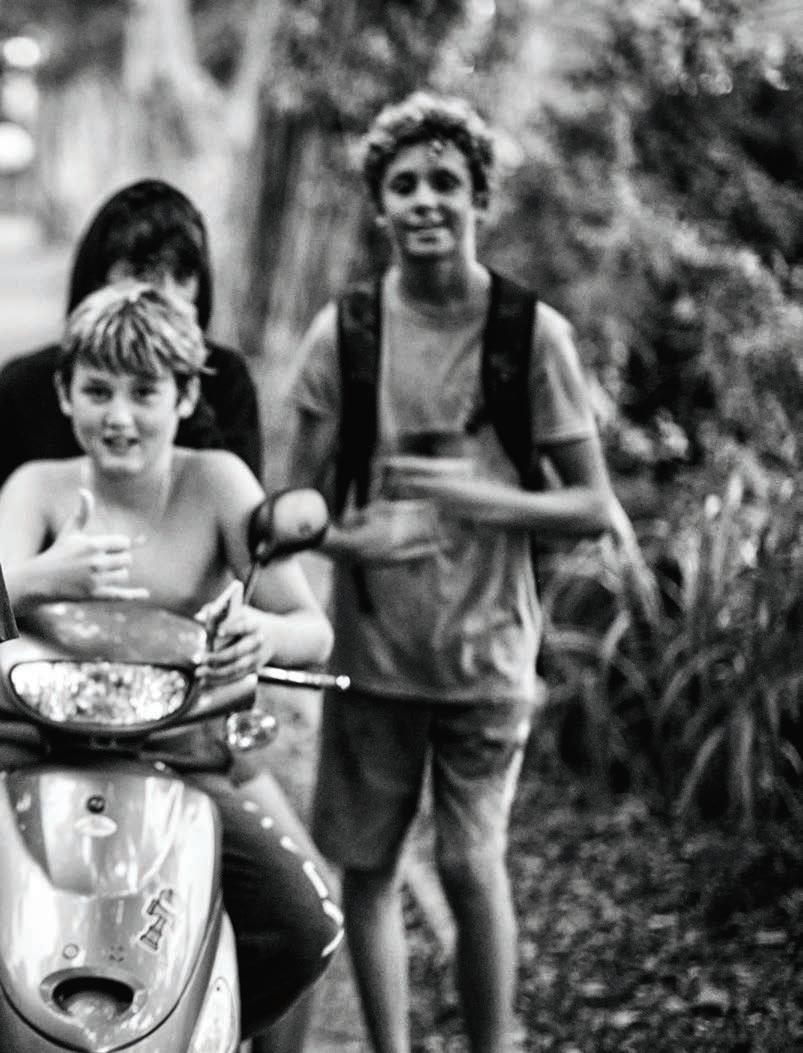
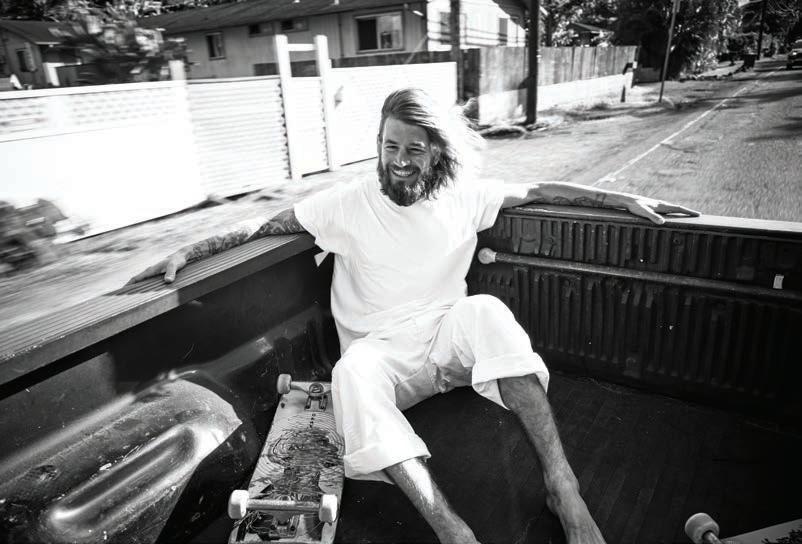
Mauka (toward the mountains) of Kamehameha Highway is the iconic Banzai Skatepark, where groms wait their turns alongside world champion surfers, celebrity skaters, local legends and fashion models. Professional skateboarder Clay Kreiner, pictured above, cruises in true Island style to a session at Banzai Skatepark.
80

“The path is amazing because you see big-wave legends like Michael Ho, Jordy Smith or Kelly Slater,” says world champion paddleboarder and pro big-wave surfer, Jamie Mitchell. “Any time you cruise down the bike path on a day with good surf, you’re going to see pros and legends and celebrities. It’s really a melting pot in our world.” On the day the photo above was taken, Mitchell says, “the waves were really good. I’d forgotten something back home and I was rushing back. You can probably see that little smile on my face is the look of someone knowing they’re about to really score.”
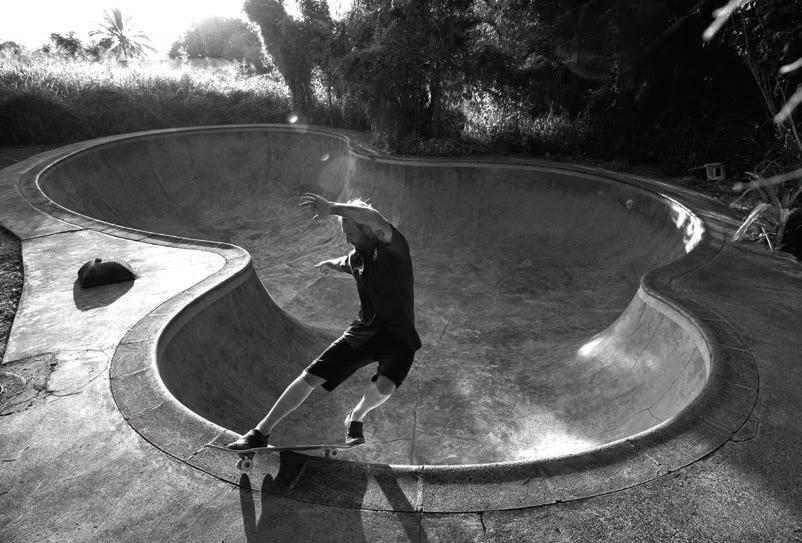 Skater-surfer Billy Fortier slides between light and shadow cast by the last rays of sun at a private pool on the North Shore.
Skater-surfer Billy Fortier slides between light and shadow cast by the last rays of sun at a private pool on the North Shore.
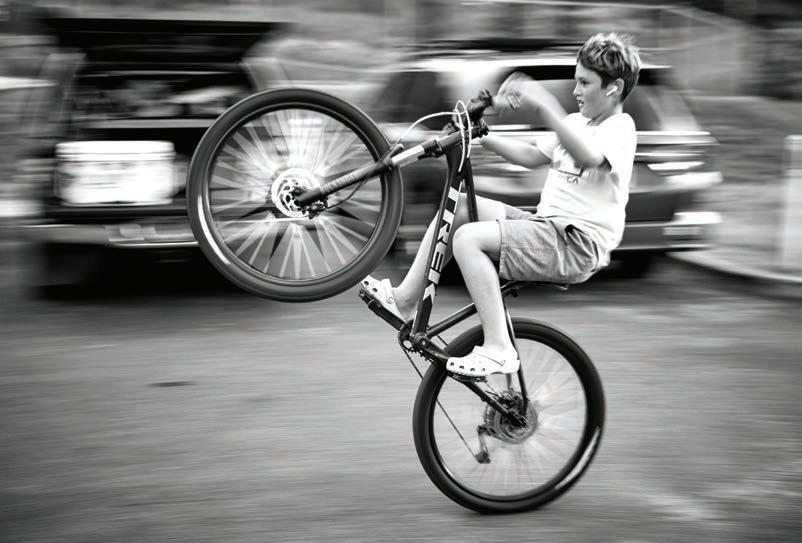
If your name is Rayge and you’re doing wheelies on a mountain bike in Crocs and ear buds before age 13, odds are you’re from the North Shore. Indeed, keiki in “the country” grow up a little wilder—perhaps it’s a side effect of all that raw energy in the ocean just beyond the bike path. Rayge Sussel-Suratt, pictured above, is a spearfisher, surfer and skater as often seen on one wheel as two along the bike path.
83
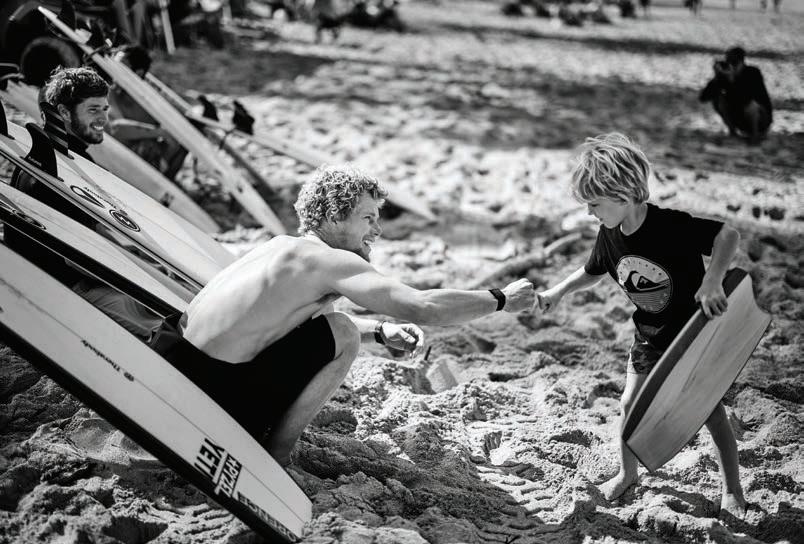
There’s probably no place on Earth where so many of the world’s best surfers live or have lived—permanently or part time—and all in proximity to the North Shore bike path. Seen here, two-time world champion, Olympian and local boy John John Florence with a young fan and his brother Nathan (seen at far left) shortly before a heat in the Da Hui Backdoor Shootout contest.
84
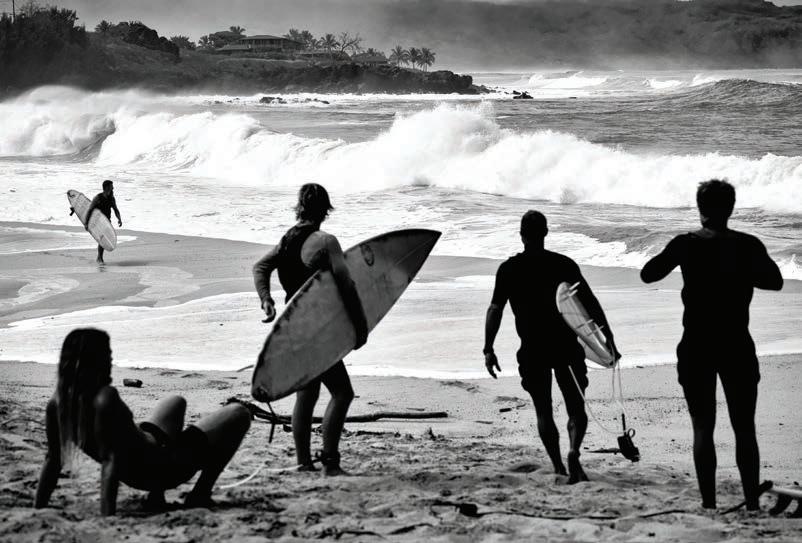
On a particularly big day, the local crew assesses, preps, stretches, prays and possibly regrets coming down to paddle out at
Waimea.
House of the Caretakers
Na Aikane o Maui Cultural Center preserves Lāhainā’s past and present

86
STORY BY KATHY MUNENO
PHOTOS BY JACK WOLFORD

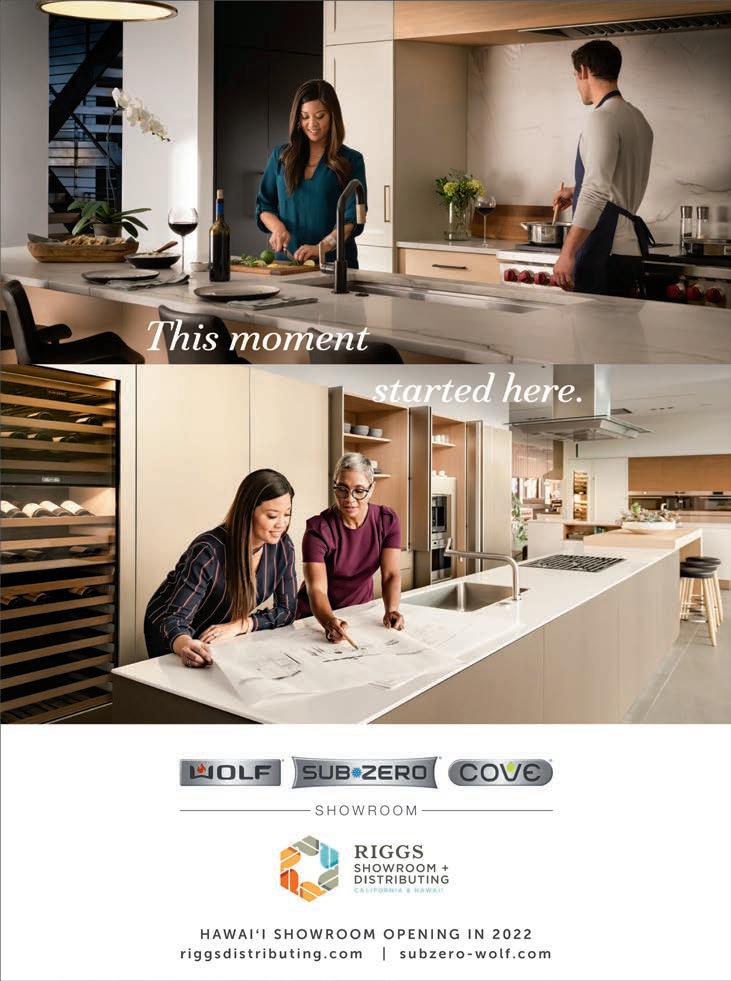


I n a corner of Lāhainā most pass without notice—old tennis courts, a park, a parking lot— there is a hint of what was. Off to one side, water stagnates in a small ditch: the last visible vestige of a time when water flowed plentifully from the West Maui Mountains, feeding a fishpond that surrounded the sacred home of Hawaiian royalty, Moku‘ula, which is where that parking lot now sits.
Moku‘ula was an island in Mokuhinia—a great, man-made fishpond said to have been home to Kihawahine, a mo‘o (lizard) deity whose name “means the clear voice in the heaven,” says historian, cultural expert and master carver Sam K. Kaai, who’s considered a “living treasure” by the State of Hawai‘i. “Her presence made this place sacred. So this was the holy of holies, and all of it was filled with water. That little ditch you crossed? That’s the only water left,” his voice rising to emphasize each of those last
three words. “Sacred ground doesn’t mean anything to anyone, but for us it is a whisper on the wind. We’re trying to make it a living song.”
The “we” he speaks of is the Na Aikane o Maui Cultural Center, located in a humble seventy-five-yearold wooden building just across the four-foot bridge spanning the ditch. That’s where you’ll find Sam among an abundance of treasures, stories and knowledge of place.
“Na aikane” means “the caretakers,” explains Ke‘eaumoku Kapu, president of the nonprofit that runs the center. “The aikane’s job was everything, the ‘āina [land], the people, the past, present, the future generations, to make sure that if we’re gonna make changes we have to have a reason. If not, don’t change it.”
It is a kuleana (responsibility) Na Aikane o Maui takes seriously. In 2011 the state awarded the nonprofit a longterm lease on the building, which had stood empty for a year. It was originally built as a cafeteria for sugar plantation
workers at Pioneer Mill Company. Later, when the plantation workers went on strike, the building served as a soup kitchen. Turning it from a sugar industry facility into a center for the preservation of Hawaiian culture marks a symbolic turning point.
“We had big plans for this place, and the plans basically turned into a pu‘uhonua,” a place of refuge, says Ke‘eaumoku. “A place where our people could come and learn. A place dedicated to retrieving generational knowledge. We’re about preserving and protecting our traditions and culture through language, music, dance.” Before the pandemic, hula hālau (hula troupes) would practice in the main room, and practitioners of the Hawaiian martial art of lua would train here. The farmers union held workshops, and the center hosted community meetings and discussions with government officials.
And Na Aikane taught the history of this National Historic Landmark District, which was once the seat of
89
“We are of the place, not from the place,” says Ke‘eaumoku Kapu (seen above right holding a lā‘au palau pōhaku, a war club he made for his father). As president of the nonprofit that runs Na Aikane o Maui Cultural Center in Lāhainā, it’s Kapu’s mission to preserve and perpetuate Maui’s Hawaiian history and culture. Above left, one of a pair of ki‘i (carved images) that Sam Kaai made for Hōkūle‘a, a replica of a Polynesian voyaging canoe, on its first voyage to Tahiti in 1976. On the opening spread, Kaai lays out pieces for a game of kōnane on a board he carved.
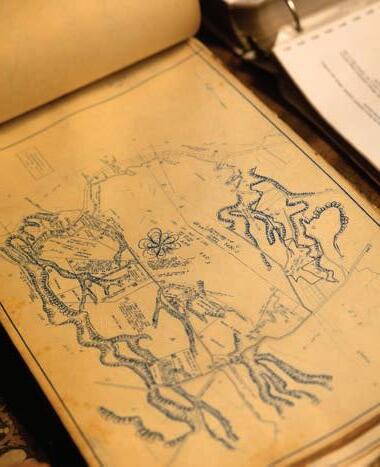
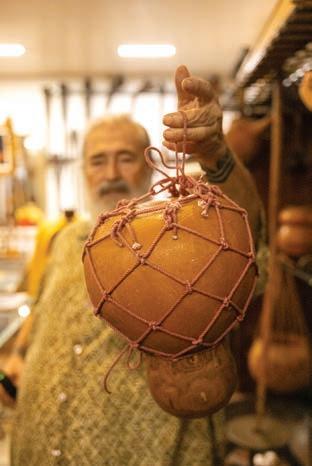
the Hawaiian kingdom’s government before it was moved to Honolulu. “Before COVID we had every school, every college; all the teachers, all the hotels would come here,” says Ke‘eaumoku’s wife, U‘ilani Kapu, treasurer of Na Aikane o Maui. “Even teaching the original place-names holds value,” Ke‘eaumoku says. “For instance, just the name Front Street, that wasn’t the original name. The original name was Ala ka Mō‘ī, the pathway of the king. Shaw street was Ala ka Mamo, the way of the people.” Children “should know the truth of their backyard,” U‘ilani says. “It gives them pride, and they go home and teach their parents, because so much was lost and they didn’t know.”
“We are of the place, not from the place,” says Ke‘eaumoku, who’s often poring over maps and documents or the collection of rare books in the center’s research room and library. The public is invited, by appointment, to dive in with him to research a specific interest, like finding out about the history of
a family property. Often people will bring or send documents or photos for Ke‘eaumoku to keep and catalog. “We get plenty family coming from the Mainland, and they’re soul-searching,” he says. “They all end up over here, and I become the docent of carrying information that families provide.”
Over the years the center also became the repository for ‘iwi kūpuna (ancestral bones) found on a beach down the road at Puamana Park. The park closed in January 2021 because beach erosion exposed an ancient burial ground. Seven sets of remains have been found so far, some by Ke‘eaumoku, others by local beachgoers and tourists, including one who brought a skull back to the hotel, which then called Na Aikane. If people find ‘iwi, they are required by law to call the police or the State Historic Preservation Division. Ke‘eaumoku served on the division’s Burial Council, so he knows how to handle the ‘iwi properly. “We mālama
[take care of] them, we wrap them in tapa [bark cloth], we place them respectfully in an area until we get word from the state on what we need to do. So this is not just a cultural center.”
In fact, in September 2021 the center also became a home, and as Ke‘eaumoku says, “it billowed into this museum of national treasures with a live-in docent known as Sam Kaai.” Last summer Sam needed a new place to live, where someone was always nearby. Word spread and reached Ke‘eaumoku.
“And I said, ‘Oh yah, of course, most definitely we’re gonna help kōkua [assist] with that,’” Ke‘eaumoku recalls. “And not just having the bedroom but building his carving room and making sure all his personal belongings are well taken care of. Never realized at that time that this guy had so much stuff!” he laughs. A lifetime of artifacts Sam has made or collected now have a home. These items, Sam says, “basically represent the tools of previous generations. Ke‘eaumoku
90
Kaai, 84, now resides at Na Aikane o Maui, and many of the artifacts he has created over his life are housed there. Above right, Kaai with an ipu, or gourd, wrapped with cordage he made himself. In addition to artifacts, Na Aikane o Maui’s research library is a repository of information, including genealogies, historic land titles and survey maps like the one seen above left.
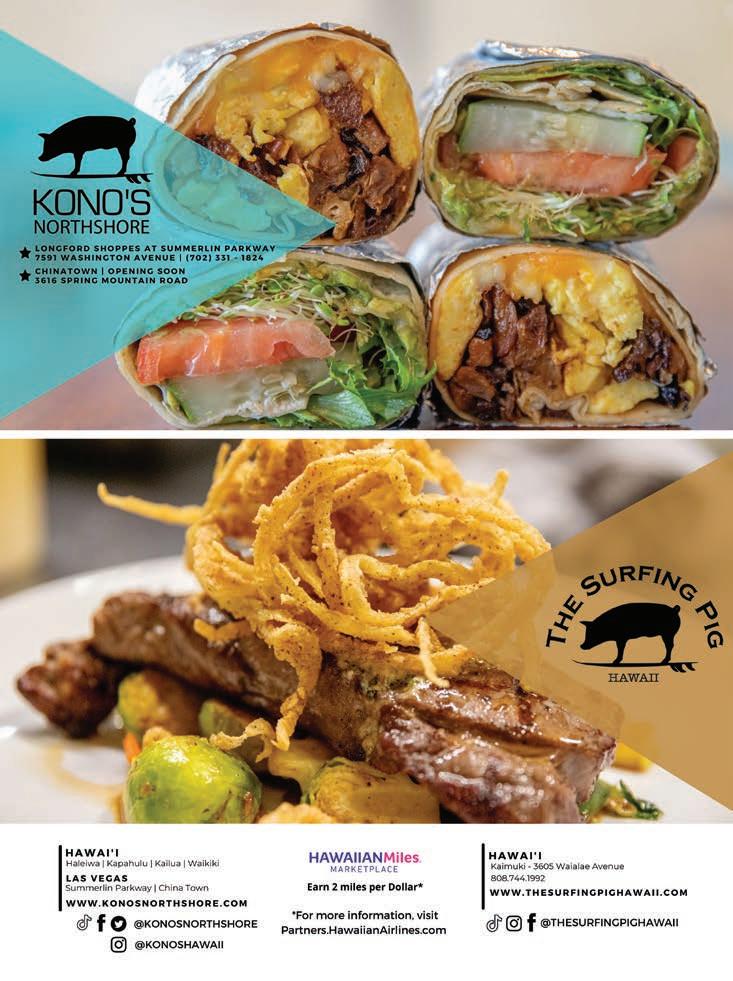


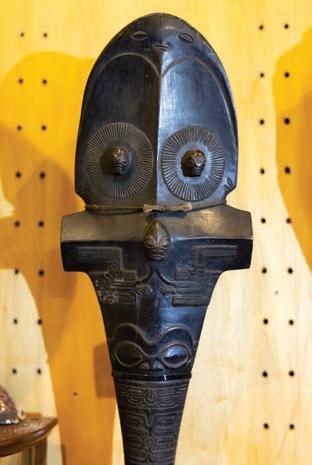
just found solutions and gave.” When I ask how he feels about it, Sam simply replies, “Maika‘i.” Good.
Many of Sam’s treasures are now on display in a room past the research library. It’s open for small group tours by appointment, a very rare opportunity to see his collection and hear personal stories from a kupuna (elder) of such high esteem. Sam was born in Hāna, Maui, in 1938 and raised in Kaupō, a remote southeastern area of the island. At 84 he still walks upright, with a regal presence that’s hard to ignore. It wasn’t long ago that he used a staff to keep his balance, but it seems that since moving here he stands taller and no longer needs the assistance.
With a flashlight to illuminate the details of his artifacts, Sam approaches the open doorway to his “museum” and pauses in front of the two large wooden ki‘i (statues). One represents a male reaching toward the heavens, the other a female, Kihawahine, the mo‘o of
Mokuhinia. Sam carved these in 1975 and lashed them to the aft of Hōkūle‘a, a replica of an ancient Polynesian voyaging canoe that sailed from Hawai‘i to Tahiti, navigating without modern instruments, in 1976. “The idea of reaching into a place that there was nothing and pulling out a craft that would stand against mighty seas that would roll ships over,” Sam intones about the beloved canoe that helped spark the cultural revival now called the Hawaiian Renaissance. He, too, had been a voyager and recalls a bird that flew above Hōkūle‘a for four days straight. “You get the feeling he was watching over you,” he says. “Standing the watch when you were doubting everything.”
One wall of the room beyond the ki‘i is lined with weapons and clubs—gifts from Tonga, Sāmoa and other Pacific Islands, as well as ones Sam carved. “I was privileged to see caves in Kaupō that either the old man [his grandfather] says, ‘No touch ’em, you just get to see,’ or he brought them out, took a look at
them. … Every one that he showed, I go make one.”
On shelves along the opposite wall are ipu, or gourds, that long ago would be filled with water. Another ipu he created for carrying the fishhooks he carved. Sam shares mo‘olelo, or stories, about each object, as well as memories of his youth in a Hawai‘i now mostly slipping into memory. He recalls how every home had a wooden tool to open a coconut. He speaks of his grandmother, who “considered the head sacred, so ‘No slap, no touch, no pull the hair.’ I mean you do that and she says something, and your place at the table will not be served that night.”
The room is large but feels small because of everything in it: a board on which the ancient, checkers-like game of kōnane is played, rows of stone adzes, shelves of coral and stone poi pounders. If you’re lucky, Sam will grab the large pū (conch shell) and make it sing. He did so for me but wasn’t satisfied with the quality of the sound. “No can,” he said,
93
Above right, a prized war club that Kaai brought back from the Marquesas Islands, “a very old and honored possession,” says Kapu. Above left, an 1864 copy of the Bible in ‘ōlelo Hawai‘i, the Hawaiian language.

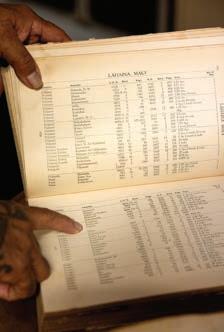
Kapu holds a niho palaoa (seen at left), a whale-tooth pendant that in ancient times was a symbol of royalty, given to him by a family member. Along with it came a kuleana, a responsibility: to protect it and pass it on to the next generation, he says. Above, a record of Lāhainā family names and land titles in the center’s research library.
and put it back. He has high standards, but I heard a note of greatness and my arms prickled with chicken skin. Or maybe Sam will take a moment to beat one of the pahu (drums) with a small woven rope with a large knot at the end. Even better, maybe he’ll sing an oli, a chant, to the rhythm.
Ke‘eaumoku says Sam seems to have a healing effect on people, “Especially if people get things on their mind, the best person to give ’em is Sam. He’ll talk your brains off for two hours and you going forget about the reason why you’re mad!” You
can tell that Sam enjoys sharing, but cautions he needs to cap the number of visitors to no more than five at a time, otherwise “things get touched and things drop,” he says.
The center is not just preserving the past but protecting the present. The display cases are quickly filling up with family heirlooms and artifacts found around Lāhainā, all donated, brought here for safekeeping. Sam’s tours and the center’s programs are all manuahi (free). “There’s a thing in Hawaiian belief,” Sam says. “If you give first, it will be multiplied.”
“You gotta give in order to receive,” Ke‘eaumoku concurs. “Not monetarily, but richness in the things that we do.” He recalls something an elder in Aotearoa (New Zealand) once told him: “‘If I cannot tend to my people, then I don’t belong sitting in the position that I am.’ So that’s why we do what we do.”
To make an appointment to visit the center or book a tour with Sam, call Ke‘eaumoku at 808-298-5639 or 808-250-1479 hh
94

One for the Team
The best young surfers in Hawai‘i go for gold in the Junior World Championships
Amob of paparazzi was waiting at the airport in El Salvador when the Hawai‘i Surf Team got off the plane a week before the start of the International Surfing Association (ISA) Junior World Championships. Flashes flashed, shutters clicked—the sort of reception usually reserved for famous hometown surfers or returning champions, but neither was the case here. Ten of the twelve teenagers had never competed in this contest before, and even though Hawai‘i is the birthplace of surfing, no team from the Islands had won since 2014. Still, for El Salvador and for youth surfing globally, the juniors were a big deal, and nothing—not even a barrage of cameras—could distract Team Hawai‘i from its mission: to bring gold back to Hawai‘i.
The ISA World Junior Championships started in 1980, and since then it has become the premier competition for surfers under age 18 to showcase their talent and see if they’re ready for the next level. Historically, the “next level” meant the World Surf League (WSL) championship tour, which is to surfing what the major leagues are to baseball. Only thirty-two surfers compete on the WSL championship tour every year, but now that surfing is an Olympic sport—a direct result of the ISA’s lobbying efforts—there are new competitive avenues. A strong performance at the Junior World Championships won’t qualify a surfer for the WSL or the Olympics, but almost all of the top surfers in the world are contest alumni: Thirty-three of the forty surfers in the Tokyo Olympics competed in it, including gold medalist and five-time WSL world champion Carissa Moore. Medaling at the juniors signals a promising career ahead.
It had been seven years since Hawai‘i had won team gold in the juniors, and this year the team started from behind.

STORY BY ERIC STINTON PHOTOS BY PABLO FRANCO 96

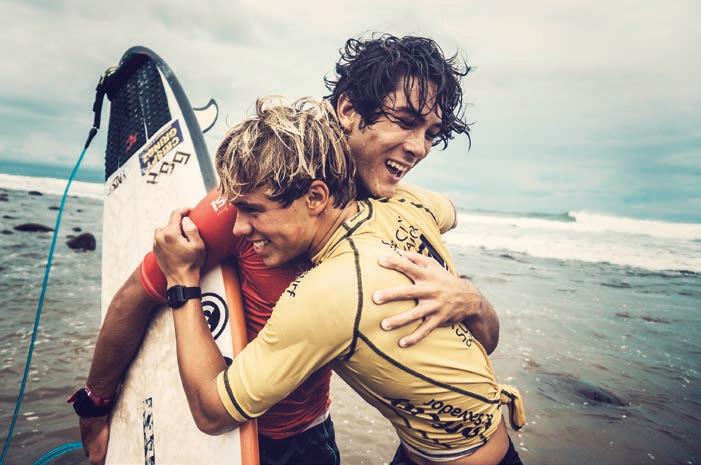
The 2020 and 2021 competitions were canceled due to the pandemic, and there were doubts about whether it would take place this summer. By the time it was officially announced, Hawai‘i was unprepared: no coaches, no team, no time for tryouts. “Hawai‘i was in a pinch getting coaches,” says Chris Martin, whose son Kai was on the 2019 team, which took silver. “So I volunteered. I didn’t want the kids to lose out on the opportunity to represent Hawai‘i.”
Martin grew up on Hawai‘i Island, the on ly one in his family who surfed. Though he taught his son to surf and coached him for most of his life, Martin’s experience as a competitive surfer was limited to local amateur contests—a far cry from the Junior World Championships, in which over four hundred surfers from forty-five countries compete. But coaching a gold-medal-level surf team is a full-time job, and because Martin already has one at a shipping company, he couldn’t do it alone.
As it happens, one of Hawai‘i’s best up-and-coming surfers is Jackson Dorian, son of Shane Dorian, who surfed professionally on the WSL championship tour for eleven years and ranked as high as fourth in the world before becoming renowned as one of the best big-wave surfers on the planet. Dorian was part of a generation of surfers who revitalized the sport in the ’90s alongside titans like Kelly Slater and Rob Machado. “I was probably going to go as a parent anyway, so I volunteered to be a coach,” Dorian says. “Our team wasn’t chosen until six weeks before the event, so it was very last-minute.”
Without proper tryouts, Dorian and Martin relied on former team coaches and people in the surf industry to pull a team together. There’s no shortage of talented surfers in the Islands, but making the team takes more than skill. “Character and results,” Martin says. “We looked for surfers
who had good character, who wanted to represent Hawai‘i and had the results to back it up.”
It was a laborious process for the coaches, but for the twelve kids selected, it was just an email that arrived out of the blue. “It was surprising,” says Puamakamae Desoto, who competed in the girls under-18 division. “I didn’t know I was in the running. I didn’t know the contest was even back on.”
“We found out we made the team, did a couple of trainings and then left for El Salvador,” says Ēwelei‘ula Wong, who competed in the same division.
Those training sessions were essential, and not just because there wasn’t much time to prepare. Most of the surfers had never been on a team before, in surfing or otherwise. Kids surfing at this level aren’t playing AYSO soccer or flag football in their spare time. By third grade they’ve dedicated their lives to training for surf competitions, most hoping to go pro. By high school they almost always pursue alternative
98
Luke Swanson shares a congratulatory hug with teammate Shion Crawford after a heat during the 2022 International Surfing Association’s Junior World Championships in El Salvador last May, where Team Hawai‘i competed against forty-five countries for a gold medal. On the opening spread, teammates hoist Ēwelei‘ula Wong for a victory carry up the beach after her win in the girls under-18 division.


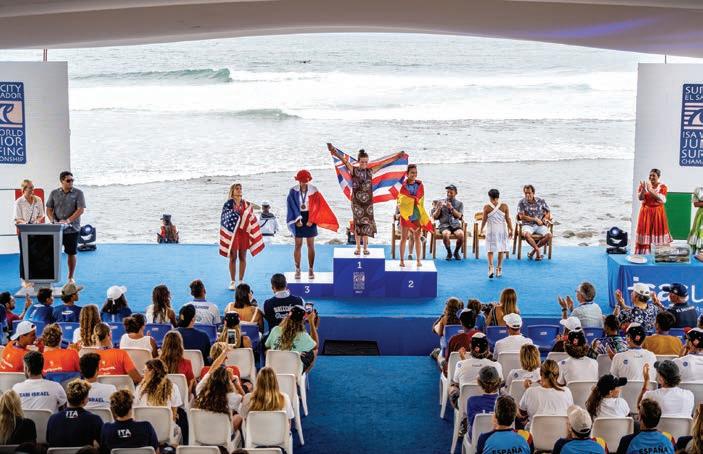 BY MIKE RODRIGUEZ
BY MIKE RODRIGUEZ
forms of education—homeschooling or online classes—so they can learn around their surf schedules. But it’s a solitary sport for the most part: Surfers usually train and compete as individuals. Aside from the Olympics, the juniors is a rare chance for surfers to be a part of something bigger than themselves. Surfers can win individual medals, but the ultimate achievement is the overall team medal, determined by the total combined points earned by everyone on the team.
“We’d all meet at the beach early in the morning,” says “Kai-boy” Martin, a team captain and one of only two members of the 2022 team who had competed in the juniors before. “We’d all warm up together and then just run heats. There wasn’t much surfing advice. It was more heat management, understanding what you were doing to earn your scores. They wanted us to really understand how to score.”
In competition there are four surfers in each twenty-five-minute heat, with
the top two moving on to the next round. Each surfer can catch as many waves as they can, but only their best two waves count. Each wave is judged on a ten-point scale, meaning the best possible score in a heat is twenty. Points are awarded for performing maneuvers with “speed, power and flow,” states the rulebook. Longer rides means surfers can attempt more maneuvers; the more difficult they are and the more gracefully they’re executed, the higher the score. Usually, a combined score of twelve or thirteen is enough to win. During Team Hawai‘i’s training sessions, the coaches gave the kids fifteen minutes to catch exactly two waves, with the goal of scoring no less than twelve points. “That makes you make good decisions and pick good waves,” says Kai-boy. They also ran heats of three surfers each, with the rest of the team giving feedback. “That’s the part I really loved,” Desoto s ays. “Now nine people, not just the girls you might compete against but the guys,
too, are critiquing you. We’re not used to having our competitors telling us how to better ourselves.”
Yet even with the handful of training sessions, some things you can learn only in competition, practical things like hydration, rest and not overtraining, as well as more abstract things like mental preparation and positive thinking. For Shane Dorian it was an opportunity to pass his knowledge and experience to the next generation. “It was important to them to perform at a high level and not let the team down,” he says. “I really wanted to give them the knowledge and mindset and confidence.” Dorian competed in the juniors three times in the 1980s and knows how important it is to do well. “It was a formative experience in my life. It really was the catalyst for me to get serious about surfing.”
Young surfers can usually get by on energy and pure enthusiasm. But this was a grueling, nine-day contest against the best surfers in the
101
Wong wraps herself in the flag of Hawai‘i at the awards ceremony. While Hawai‘i competes as part of the United States in Olympic surfing, it has the distinction of its own category in junior and pro competition—a meaningful distinction for Native Hawaiians in particular. Being Native Hawaiian “gives me a sense of kuleana,” or responsibility, Wong says. “I’m part of something bigger than myself: I’m part of the community that created surfing.”
PHOTO
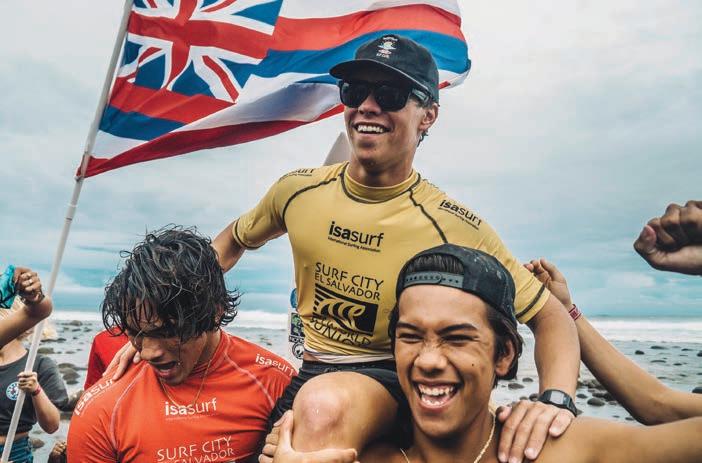
world, with heat after heat including a second-chance repêchage bracket where athletes who lose can still fight for a spot in the finals. When the air feels like a sauna and the ocean like a roiling bowl of warm soup, it takes focus and determination to perform at your best— and that’s when things are going well. But Team Hawai‘i faced adversity before the competition even started.
Luke Tema, who competed in the boys under-16 division, and Vaihiti Inso, who competed in the girls under-16, both tested positive for COVID soon after arriving in El Salvador. They quarantined in separate hotel rooms, and it seemed they wouldn’t be able to compete, which would have essentially killed Team Hawai‘i’s hopes of bringing home an overall team medal. Meanwhile, the rest of the team struggled with heat exhaustion. Things felt like they were starting to unravel.
On the first day of the competition, both Inso and Tema tested negative and were cleared to compete. The team’s
morale soared, and Tema hit the water like he had something to prove. “Luke was super inspirational as far as not giving up and surfing his heart out,” says Kai-boy. “He had three or four heats where he found a wave at the last minute to advance.” The kids rallied around Tema’s buzzer-beating heroics, and those who had been knocked out of competition encouraged their teammates from shore, shouting praise and critique just as they had during training. “Our team spirit and support for one another was off the hook,” says Inso. “I full-blown lost my voice because I was screaming, cheering everyone on.”
The screaming reached a fever pitch when Ēwelei‘ula Wong, another team captain, got to the finals. After suffering heat exhaustion and losing early in the third heat of the contest, Wong powered through an additional seven repêchage rounds to reach the final. She was exhausted but buoyed by her teammates’ success: Luke Swanson and Shion Crawford took gold and
silver in the boys under-18 division. “I’m stoked!” Crawford told a reporter after winning the silver, with no sour grapes over Swanson’s gold. “If it was anybody else [who beat me], I would’ve been bummed,” he said. Wong was already in the water by then, and she knew that even if she didn’t win her final, she could still earn enough points to push Team Hawai‘i to the overall team gold.
Wong faced off against surfers from Spain, France and the United States. The United States? one might rightly wonder. In the Olympics, Hawai‘i is part of Team USA, but in the ISA and the WSL, Hawai‘i has the distinction of being its own entity and competes separately. This adds an additional element of pride for these surfers, especially because the United States and France won four of the past five team gold medals, and particularly for Wong because she’s Kanaka Maoli, or Native Hawaiian. “That gives me a sense of kuleana [responsibility],” Wong says, “because I know my kūpuna, my
102
Swanson takes his victory lap after winning gold in the boys under-18 division; Crawford took silver.
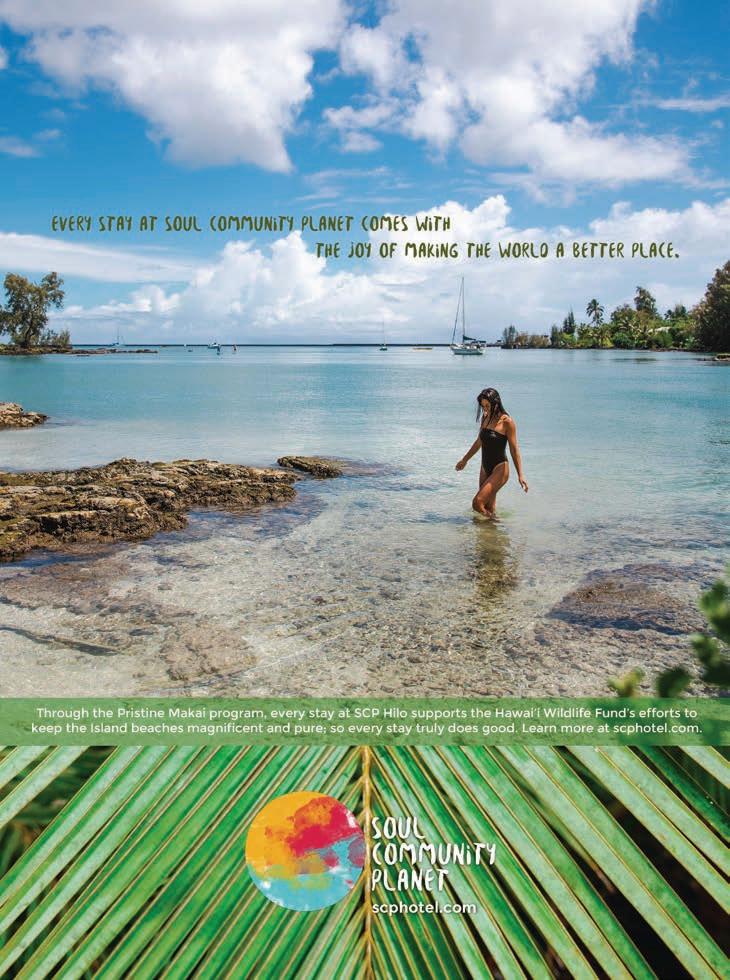



Schedule your complimentary consultation!

We offer in-person and virtual options, perfect for out-of-state patients.

Same Day New Smile™
Shawn Keller, DDS
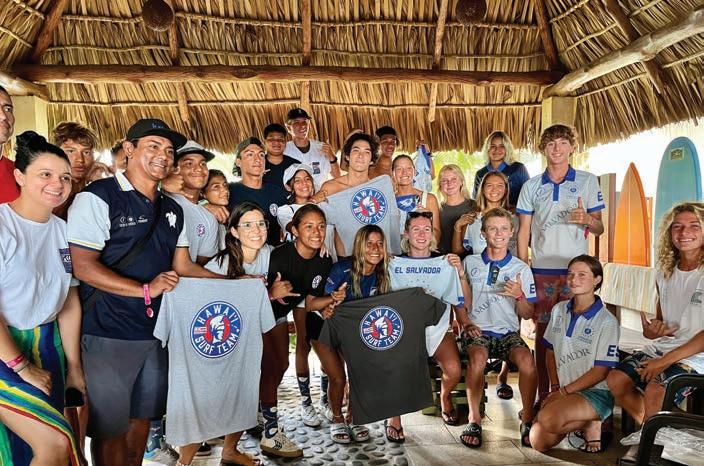
ancestors, created surfing. It gives me a greater sense of identity. It gives me a lot of confidence in the water. I’m part of something bigger than myself: I’m part of the community that created surfing.”
The waves were moderate and messy, with six- to seven-foot faces and steady offshore winds peeling spray off the lip like a comet’s tail. Within a minute Wong dropped in and went left, carving a bottom turn and slashing off the lip. Her 6.83 gave her the early lead. Her competitors started scratching to catch up, putting points on the board, but Wong held her lead and her composure, waiting for the right wave, just as she had practiced. Her patience paid off.
This time she went right, executing a perfect bottom turn, then smoothly maneuvering to the lip before whipping her board back down again to continue riding—not once, not twice but three times, faster each time and with a fluidity that left even the most poetic of her teammates too awestruck to say
anything except “Braaah.” With her score of 8.17, it was pau (finished).
Hawai‘i took home four of the twelve individual medals: two gold, one silver and one bronze. More important, they won the overall team gold medal. “We all got a gold medal,” says Crawford. “It wasn’t like, ‘You got one and I didn’t.’ We all got it together.” For the coaches, too, the team gold was the mark of true success, the first in seven years and the fourth in the eighteen years that the ISA has held the Junior World Championships. “We were noticed not just for surfing well but for being humble and respectful,” Martin says. “We wore our flag around and repped Hawai‘i well. Our team was more focused on winning overall gold than individual gold. That’s very unique in surfing.”
The kids on the under-16 teams will have a chance to return next year, but for the rest the win is a gold-plated bon voyage as they embark on the next stage of their surf journeys. Even though an Olympic
gold medal would be a nice companion to an ISA gold, all the surfers are pursuing a greater prize: the WSL world title, the holy grail of surfing. These competitors-turnedteammates will almost certainly become competitors again.
But even as they turn pro, with all the seriousness and determination it demands, these kids maintain both a sense of adventurousness as well as greater purpose. “I want to surf all the breaks I can,” says Crawford, prioritizing process over results. True, too, for Kai-boy Martin: “I just want to travel and get better at surfing,” he says. Desoto sees herself doing more with surfing than simply winning: “I want to inspire girls all over the world. I want to share Hawai‘i and the culture and the story of surfing.”
As for Wong, her love for surfing is unwavering, but her love for competition waxes and wanes. “I really just want to be a good representation of my people,” she says, “on a global scale and in my everyday life.” hh
105
Above, Team Hawai‘i poses for a photo-op during a cultural exchange with their hosts, Team El Salvador. COURTESY ISA HAWAII

H o MA NIGHTS
Every Friday and Saturday
Honolulu Museum of Art remains open until 9 p.m. with opportunities to explore the galleries, stargaze in the courtyards, enjoy live art experiences and music and connect with the museum community. Honolulu Museum of Art, (808) 532-8700
MADE WITH
ALOHA GIFT FAIR
Every third Saturday and Sunday
Support dozens of small local businesses, selling their handcrafted jewelry, baked goods, unique apparel, charms and more. 10 a.m. to 5 p.m. Free. Pearlridge Center, (808) 689-9091
THE HEALER STONES OF KAPAEMAHU
Through 10/16
An exhibit exploring the past and contemporary meanings of four large stones that were long ago placed on Waikīkī Beach to honor four māhū, extraordinary individuals of dual male and female spirit, who brought healing arts from Tahiti to Hawai‘i. Bishop Museum, (808) 847-3511
TWO HAWAIIAN OLYMPIC CHAMPIONS
Through 10/30
An exhibit celebrating the lives and achievements of the two Native Hawaiian Olympic Gold Medalists, Duke Paoa Kahanamoku and Carissa Kainani Moore. Bishop Museum, (808) 847-3511
CROSS POLLINATION: FLOWERS ACROSS THE COLLECTION
Through 6/4/2023
Presented in conjunction with the immersive anchor installation, Rebecca Louise Law: Awakening, this exhibition
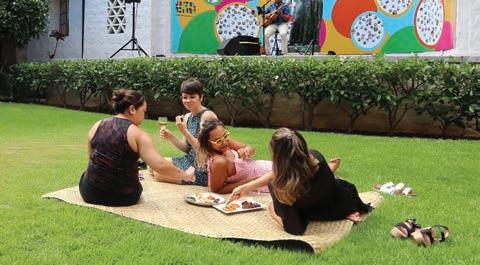
unites a diverse arrangement of floral artworks from HoMA’s permanent collection. Honolulu Museum of Art, (808) 532-8700
PRIDE N SEEK W/ INIKO
10/9
Iniko rose to fame with their viral hit The Kings Affirmation which started as an acapella freestyle on Tik Tok garnereing millions of views. 8 p.m. The Republik, blackbazaarhnl.com (808) 941-7469
GAY BOWL XXII
10/6-9
More than 1,200 LGBTQIA+ athletes compete in the 22nd NGFFL Gay Bowl Flag Football Tournament along with social events throughout the weekend. Kapi‘olani Park, (808) 726-3639
BISHOP MUSEUM AFTER HOURS
10/14
Museum exhibits are opened for viewing from 5:30 to 9 p.m., along with cultural demonstrations and food and drinks for sale from local vendors. Bishop Museum, (808) 847-3511
HONOLULU PRIDE PARADE & FESTIVAL
10/15
Hawai‘i’s largest and most colorful celebration for the LGBTQ+ community, its friends, families and allies. A parade along Kalākaua Avenue is followed by a festival with music, activities, food and libations at Diamond Head Greens. Free
and open to all. 10 a.m to 6 p.m. Waikīkī, (808) 265-1720
ALI‘I SUNDAY: PRINCESS KA‘IULANI
10/16
A worship service in honor of Princess Ka‘iulani in a church that has profound ties to Hawai‘i’s royal past. The procession will begin at 9 a.m. Kawaiaha‘o Church, (808) 469-3000
FAMILY SUNDAYS
10/16
Free museum admission for kama‘āina (residents) on the third Sunday of every month. HoMA offers creative activities for keiki of all ages, community-focused programming and entertainment. 10 a.m. to 6 p.m. Honolulu Museum of Art, (808) 532-8700
HAWAI‘I’S WOODSHOW 2022 10/16-30
Hawai‘i Forest Industry Association’s 30th annual juried woodworking exhibition. Attendees will be treated to extraordinary heirloom-quality works made from locally grown woods. 10 a.m. to 6 p.m. Hawai‘i Opera Plaza, (808) 933-9411
ANJELAH JOHNSON-REYES
10/21
Stand-up comedian, actress and author Anjelah Johnson-Reyes performs her latest act combining comedy with stories from her new memoir Who Do You Think I Am? 7 p.m. Blaisdell Concert Hall, (808) 768-5252
106 EVENTS: O‘AHU
OCTOBER
HoMA Nights
Pride N Seek w/ INIKO


KEHLANI - BLUE WATER ROAD TRIP TOUR
10/21
Following the release of her critically acclaimed album Blue Water Road, Kehlani performs alongside special guests Rico Nasty. 7 p.m. Tom Moffatt Waikiki Shell, (808) 768-5252
HONOLULU ON TAP
10/22
Browse and sample more than a hundred selections from some of America’s best craft breweries. The festival includes live music, food for purchase and product vendors. 1 p.m. to 5 p.m. Blaisdell Exhibition Hall, (808) 768-5252
HARRY
POTTER AND THE ORDER OF THE PHOENIX™ IN CONCERT
10/29
The Harry Potter Film Concert Series returns with the fifth film in the series. Shih-Hung Young will conduct the Hawai‘i Symphony Orchestra in performing the score live while the entire film plays in high-definition on a 40-foot screen. 7:30 p.m. Blaisdell Concert Hall, (808) 768-5252
NOVEMBER
HAWAI‘I FOOD & WINE FESTIVAL
11/3-6
Now in its twelfth year, the festival features a roster of more than 150 internationally renowned master chefs, culinary personalities, winemakers and mixologists. Various Locations, (808) 738-6245
42ND HIFF FALL FESTIVAL
11/3-27
Feature films, shorts and series from around the world, specifically from Asia and the Pacific region. This year’s hybrid in-person and virtual fall festival includes talks with topics ranging from film festival submission strategy to pop culture. Inperson events will take place on O‘ahu 11/3-13 and neighbor islands 11/17-20. Various locations, (808) 792-1577
KHRUANGBINFIRST CLASS TOUR
11/9
The enigmatic Texas three-piece band is bringing its brand of atmospheric psychfunk to Honolulu on its largest tour to date. 8 p.m. Blaisdell Concert Hall, (808) 768-5252
BISHOP MUSEUM AFTER HOURS
11/11
Museum exhibits are opened for viewing from 5:30 to 9 p.m., along with cultural demonstrations and food and drinks for sale from local vendors. Bishop Museum, (808) 847-3511
O KE KAI SERIES 2022
11/12
Friends of Hōkūle‘a & Hawai‘iloa present on Hawaiian traditions of building, restoring and caring for canoes, centered around the 100-year-old outrigger canoe Kalele restored by the organization. 9 a.m. to 1:30 p.m. Outrigger Reef Waikiki Beach Resort Ao Cultural Center, (808) 924-6007
KAIWI COAST RUN & WALK
11/20
A four-mile run/walk along the Kaiwi coast. The race starts at dawn at Sandy Beach and ends at the Hui Nalu Canoe Club on Maunalua bay. Proceeds benefit the Hui Nalu Canoe Club. Maunalua bay, (808) 256-7394
FAMILY SUNDAYS
11/20
Free museum admission for kama‘āina (residents) on the third Sunday of every month. HoMA offers creative activities for keiki of all ages, community-focused programming, and entertainment. 10 a.m. to 6 pm. Honolulu Museum of Art, (808) 532-8700
WHOSE LIVE ANYWAY?
11/25
The improv comedy stars of television’s Whose Line Is It Anyway? perform scenes live with a theatre audience. 8 p.m. Hawaii Theatre Center, (808) 528-0506
EVENTS 107
Kehlani - Blue Water Road Trip Tour
Two Hawaiian Olympic Champions

NIAULANI NATURE WALK
Mondays
A one-hour nature walk through an oldgrowth Hawai‘i rainforest on an easy loop trail. Walkers are introduced to the native plants and birds of Kīlauea volcano. Free. 9:30 a.m. Volcano Arts Center’s Niaulani Campus, (808) 967-8222
PORTUGUESE BREAD BAKING
Thursdays
Observe the traditional art of baking Portuguese bread in a large wood-fired stone oven, or forno. The programs team will share the importance of such ovens in our community and the history of the Portuguese, and bread sales begin at 1 p.m. 10 a.m. Kona Historical Society, (808) 323-3222
A WALK INTO THE PAST
Fridays
Take a walk back in time to 1912 and meet the founder of the Hawaiian Volcano Observatory, Dr. Thomas A. Jaggar at the edge of Kīlauea volcano. Dressed in period costume, Ka‘ū actor and director Dick Hershberger brings the renowned geologist to life. Free. 10 a.m. to noon. Hawai‘i Volcanoes National Park, (808) 985-6000
HALEKI‘I FARMERS MARKET & CRAFT FAIR
Every First Saturday
Local crafts and art vendors, keiki entrepreneurs, fresh food, ‘ohanacentered outreach, sustainable-living resources and live music. Free. 9 a.m. to 2 p.m. Kona Grill House, (808) 960-7728
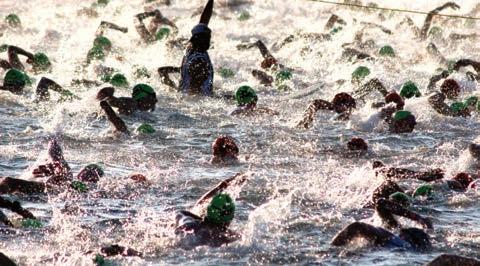
YOUTH ARTS SATURDAYS
Every Second Saturday Keiki of all ages are welcome to join guest artists and other local organizations in making a variety of creative projects. Free. 10 a.m. to 2 p.m. East Hawai‘i Cultural Center, (808) 961-5711
IRONMAN WORLD CHAMPIONSHIP
10/6 & 8
Two thousand triathletes from dozens of countries and all fifty states converge for the Super Bowl of triathlons. KailuaKona’s challenging environment— black lava rock, powerful crosswinds and scorching sun—will push race participants to their limits. 6:30 a.m. to 1 p.m. Kailua-Kona, (808) 329-0063
FOREST FAIR
10/8
This celebration of Hawai‘i’s native forest and natural resources includes displays, vendors, free forest tours, and plant and book sales. Volcano Art Center’s Niaulani Campus, (808) 967-8222
THE LION KING JR
10/14-23
A young lion named Simba becomes heir to the pride lands, but flees his home when tragedy strikes. After years in exile, he decides to return and fight to take his rightful place in the circle of life. Presented by the Hilo Education Arts Repertory Theatre (HEART). Palace Theater, (808) 934-7010
KŌKUA KAILUA VILLAGE STROLL
10/16
Ali‘i Drive transforms into a festive, pedestrian-only marketplace filled with music and art. At 4 p.m. there is a free Hawaiian music concert at Hulihe‘e Palace. 1 p.m. to 6 p.m. Kailua-Kona, (808) 936-9202
ALOHA FRIDAY NIGHT MARKET
10/28
An evening marketplace with food trucks and over thirty local vendors. Each market helps support one of Hawai‘i Island’s nonprofit organizations. Free. 4 p.m. to 8 p.m. Kona Commons Shopping Center, (808) 854-1439
HAWAI‘I FOOD & WINE FESTIVAL
10/28 & 29
Now in its twelfth year, the festival features a roster of more than 150 internationally renowned master chefs, culinary personalities, winemakers and mixologists. Various locations, (808) 738-6245
NOVEMBER
KONA COFFEE CULTURAL FESTIVAL
11/4–13
Founded in 1970, Hawai‘i’s oldest food festival aims to preserve, perpetuate and promote Kona’s unique coffee heritage with multiple events including tastings,
108 EVENTS: HAWAI ‘ I ISLAND
OCTOBER
Ironman World Championship
Hawai‘i Food & Wine Festival
farm tours, competitions and an evening lantern parade. Kailua-Kona, (808) 326-7820
HAWAI‘I NEI 2022
11/4–12/15
A juried art exhibition celebrating the native flora and fauna of Hawai‘i Island. The opening reception will announce winners from youth and adult divisions, with live music and refreshments. Free. Wailoa Center, (808) 933-0416
JAZZ IN THE FOREST
11/12
Volcano Art Center’s monthly jazz concert highlights local musicians at the Dietrich Varez Hall surrounded by native Hawaiian rainforest. November’s concert is themed Autumn Leaves. Volcano Art Center’s Niaulani Campus, (808) 967-8222
100% KONA COFFEE HALF MARATHON
11/12
Run the scenic coast of Kailua-Kona, beginning at Coconut Grove Marketplace and heading south on Ali‘i Drive. 6 a.m. to 10:30 a.m. Coconut Grove Marketplace, (808) 600-1113
KŌKUA KAILUA VILLAGE STROLL
11/20
Ali‘i Drive transforms into a festive, pedestrian-only marketplace filled with music and art. At 4 p.m. there is a free Hawaiian music concert at Hulihe‘e Palace. 1 p.m. to 6 p.m. Kailua-Kona, (808) 936-9202
ALOHA FRIDAY NIGHT MARKET
11/25
An evening marketplace with food trucks and over thirty local vendors. Each market helps support one of Hawai‘i Island’s nonprofit organizations. Free. 4 p.m. to 8 p.m. Kona Commons Shopping Center, (808) 854-1439


OCTOBER
WILDLIFE WEDNESDAYS
Wednesdays
Join naturalists from the Hawai‘i Wildlife Discovery Center at the beachfront every Wednesday morning and learn all about humpback whales, turtles, monk seals and more Maui wildlife. 10 a.m. to noon. Whalers Village, (808) 661-4567
HĀNA FARMERS MARKET
Fridays
Locally grown produce and products from farmers in the East Maui communities of Ke‘anae, Hāna, Kīpahulu and Kaupō. Online pre-orders and drive-through ordering available. Free. Kūpuna-only (65+) shopping starts at 2:30 p.m., general admission from 3 p.m. to 5 p.m. Hāna Town Center, (808) 378-0084
UPCOUNTRY FARMERS
MARKET
Saturdays
Locally grown produce, fish, prepared food and products. Free. 7 a.m. to 11 a.m. Kula Malu Town Center, (808) 572-8122
MAUI SUNDAY MARKET
Sundays
A weekly evening marketplace with local food and product vendors and live entertainment, organized by the Maui Food Technology Center. Free. 4 p.m. to 8 p.m. Kahului Shopping Center, (888) 948-6382
WHITE RABBIT, RED RABBIT
Through 10/9
No director. No rehearsal. A different actor every night. An avant-garde piece of theater written by Nassim Soleimanpour and featuring Ally Shore, Ted Anderson, Kiegan Otterson and others. ProArts Playhouse, (808) 463-6550
INFINITE NIGHT, PHOTOGRAPHY BY STAN HONDA
Through 10/22
The night sky landscapes of New Yorkbased photojournalist Stan Honda show the beauty of the sky in relation to the Earth as it moves through the universe with a multitude of celestial objects. This exhibition will highlight his recent work of Haleakalā and other works from the night skies project. Maui Arts & Cultural Center (MACC) Schaefer Gallery, (808) 242-2787
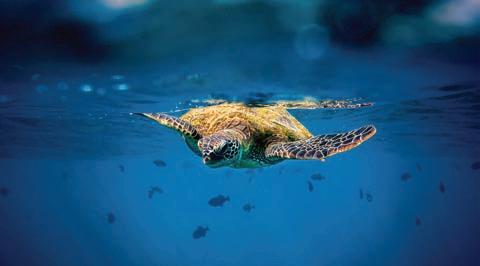
MĀLAMA WAO AKUA 2022
Through 11/5
A juried art exhibition of all media celebrating the native species of Maui Nui (Maui, Lāna‘i, Moloka‘i, Kaho‘olawe). Maui artists explore watersheds and raise awareness about the importance of protecting native species. Hui No‘eau Visual Arts Center, (808) 572-6560
FESTIVALS OF ALOHA, LĀNA‘I
10/1
The annual Festivals of Aloha, Maui Nui Style honors Hawaiian heritage through events on Maui, Moloka‘i and Lāna‘i. The Lāna‘i ho‘olaule‘a (celebration) includes entertainment, cultural demonstrations, lei making, art and aloha attire contests and ‘ono (delicious) eats. Dole Park, (808) 870-7546
MAUI PLANTATION DAYS FESTIVAL
10/1
A celebration of Hawai‘i’s historic plantation communities that will feature food and performances from the many cultures that immigrated to the Islands during plantation days. Kids 5 and under are free. 9 a.m. to 4 p.m. Alexander & Baldwin Sugar Museum, (808) 871-8058
FESTIVALS OF ALOHA, MOLOKA‘I
10/7 & 8
Moloka‘i celebrates the annual Festivals of Aloha, Maui Nui Style with the Royal Court’s investiture, a poke and aloha
attire contest, a kalo-‘ulu-‘uala recipe contest and a keiki talent contest. Other events include a parade and ho‘olaule‘a (celebration). Various locations on Moloka‘i, (808) 553-3356
QKC KEIKI CLUB
10/15
Learn about the vast diversity of sea life in Hawai‘i with one of Maui Ocean Center’s Marine Naturalists at the QKC keiki play area. Enter to win giveaways and enjoy family friendly festivities. 10 a.m. to 11 a.m. Queen Ka‘ahumanu Center, (808) 877-3369
FESTIVALS OF ALOHA HĀNA
10/15-22
Festivals of Aloha, Maui Nui Style comes to Hāna with a full week of community events including a parade, karaoke night, talent show, sports night, multiple contests and more. Various locations in Hāna, (808) 248-7758
NEON BEATS SILENT DISCO
10/20
A monthly silent disco with multiple DJs and channels available for a personalized outdoor dance party. Beverages available and $5 headphone rental fee. 10 p.m. to 1 a.m. Down the Hatch, (808) 661-4900
110 EVENTS: MAUI/ MOLOKA‘I/ LĀNA‘I
Wildlife Wednesdays
HAWAI‘I FOOD & WINE FESTIVAL
10/21-23
Now in its twelfth year, the festival features a roster of more than 150 internationally renowned master chefs, culinary personalities, winemakers and mixologists. Various locations, (808) 738-6245
ANJELAH JOHNSON-REYES
10/22
Stand-up comedian, actress and author Anjelah Johnson-Reyes performs her latest act combining comedy with stories from her new memoir Who Do You Think I Am? 7 p.m. MACC Castle Theater, (808) 242-7469
NOVEMBER
BENT
11/4-20
Set amidst the decadence of pre-war fascist Germany, Bent is an emotional tale of love, as three homosexual men fight for survival in the face of persecution. ProArts Playhouse, (808) 463-6550
HULA O NĀ KEIKI
11/10–12
Now in its thirtieth year, this annual children’s hula competition celebrates the mele (songs) of Maui and the talents of hula students, ages 5 to 17 as they compete in both kahiko (ancient) and ‘auana (modern) categories. Kā‘anapali Beach Hotel, (800) 262-8450
NEON BEATS SILENT DISCO
11/17
A monthly silent disco with multiple DJs and channels available for a personalized outdoor dance party. Beverages available and $5 headphone rental fee. 10 p.m. to 1 a.m. Down the Hatch, (808) 661-4900
QKC KEIKI CLUB
11/19
Learn about the vast diversity of sea life in Hawai‘i with one of Maui Ocean Center’s Marine Naturalists at the QKC keiki play area. Enter to win giveaways and enjoy family-friendly festivities. 10 to 11 a.m. Queen Ka‘ahumanu Center, (808) 877-3369


111
OCTOBER
KAUA‘I CULINARY MARKET
Wednesdays
A weekly farmers market featuring fruits, vegetables, flowers and a cooking demonstration. A partnership with the Kaua‘i County Farm Bureau. 3:30 p.m. to 6 p.m. The Shops at Kukui‘ula, (808) 742-9545
MAKAI MUSIC & ART FESTIVAL
Wednesdays
A weekly gathering with performances by local musicians and an assortment of handmade jewelry, crafts, art and more from local vendors. Free. 1 p.m. to 5 p.m. Princeville —Makai Lawn, (818) 318-7338
ALOHA MARKET
Thursdays
Everything from fresh fruits and vegetables to noodles, spices, sweets, treats and items like jewelry, clothing, art and household and family accessories will be available for purchase. Hula performance at 12:30 p.m. every week. Free. 10 a.m. to 2 p.m. NTBG South Shore Visitor Center, (808) 742-2623
ALOHA FRIDAY ART NIGHTS
Fridays
Each Friday night Kress Street fills with live art demonstrations. From music to murals, artists share their craft with the community. Līhu‘e—Kress Street, (808) 652-1442
HANALEI FARMERS MARKET
Saturdays
Locally grown fruits and vegetables from Kaua‘i North Shore farmers along with fresh-squeezed juices, locally made honey, fresh-baked goods and arts and crafts. 9 a.m. for senior citizens, 9:30 a.m. to noon for general admission. Hale Halawai ‘Ohana o Hanalei, (808) 826-1011
ALAKOKO PLANT SWAP
Sundays
This weekly market offers plant lovers the chance to buy, sell or trade a wide variety of greenery. Free. 10 a.m. to 1 p.m. Alakoko Shop, (808) 652-1442
ART KAUA‘I
Through 10/28
Art Kaua‘i is the annual juried show of the Kaua‘i Society of Artists, featuring works in multiple mediums by a distinctive group of artists living on the island. Kukui Grove Shopping Center, (808) 245-2782
OHANA FITFEST
10/1
This family friendly event includes a 5K obstacle-filled fun run, community expo, silent auction and live entertainment. Event proceeds will be used to help maintain public-access beach and hiking trails on the North Shore of Kaua‘i. 6:30 a.m. to 11:30 a.m. Prince Albert Park, (858) 967-7817
PAU HANA TRIVIA NIGHT
10/7
A family-friendly trivia night in Porter Pavilion with food trucks, beer and wine hosted by Katie C., Kaua‘i’s “trivia girl.” Free. 6 p.m. to 8 p.m. Anaina Hou Community Park, (808) 828-2118
DOWNTOWN LĪHU‘E NIGHT
MARKET
10/8
Locally made crafts, gifts, food trucks, baked goods, live entertainment, and more. Featuring more than fifty vendors each month. Free. 4 p.m. to 8 p.m. Līhu‘e —Kress Street, (808) 652-1442
PRINCEVILLE NIGHT MARKET
10/9
This monthly festival features live music, pottery, paintings, apparel, jewelry and more than forty local artisans. Free. 4 p.m. to 8 p.m. Princeville Shopping Center, (808) 635-2572
PRINCEVILLE ARTIST AND FLEA MARKET
10/9
This monthly marketplace focused on vintage apparel, accessories and home goods also features local vendors offering crafts, jewelry, health products, food, a keiki zone and live music. Free. 3 p.m. to 7 p.m. Princeville Community Center, (808) 826-6687
KAUA‘I CHOCOLATE AND COFFEE FESTIVAL
10/14 & 15
This celebration of two of Kaua‘i’s tastiest crops includes lots of sampling,
educational displays and workshops, entertainment and exhibitor booths featuring a variety of chocolate and coffee products from around the state. Hanapēpē, (808) 234-0404
OLD KŌLOA TOWN MARKET
10/15
Kaua‘i artisans, photographers, food trucks, food vendors, musicians and entertainers gather for this monthly makers market. Free. 4 to 8 p.m. Old Kōloa Town, (808) 245-4649
PO‘IPŪ FOOD AND WINE FESTIVAL
10/19-22
The fifth annual Po‘ipū Food and Wine Festival will include three days of cooking demonstrations and classes capped off with an evening of small plates and wine pairings from some of Hawai‘i’s most popular and award-winning chefs. Po‘ipū, (808) 265-2096
DMYTRO CHONI
10/30
Ukrainian concert pianist Dmytro Choni, the 2022 Van Cliburn International Piano Competition Bronze Medalist, performs live. 5 p.m. St. Michael’s Church Līhu‘e, (808) 245-7464
NOVEMBER
PAU
HANA TRIVIA NIGHT
11/4
A family-friendly trivia night in Porter Pavilion with food trucks, beer and wine, hosted by Katie C., Kaua‘i’s “trivia girl.” Free. 6 p.m. to 8 p.m. Anaina Hou Community Park, (808) 828-2118
SUTTON LEE SEYMOUR AND CACOPHONY DANIELS
11/5
The award-winning, live-singing drag queens return exactly one year from their Kaua‘i debut with a new show. 7 p.m. Sheraton Coconut Coast, (808) 245-7464
KAUA‘I VETERANS PARADE 11/5
A parade including Kaua‘i’s largest school marching bands, JROTC units, the Pacific Fleet band and more. Following the parade there will be a fair for veteran vendors and local products, a program honoring veterans and entertainment. 9 a.m. to 2 p.m. Līhu‘e, (808) 652-1442
112 EVENTS : KAUA ‘ I
KAUA‘I WRITERS CONFERENCE
11/7–13
A faculty of more than forty-five bestselling authors, literary agents and publishers share tips and ideas with hundreds of writers of all levels. Genres include fiction, nonfiction, memoir, poetry, short story and young adult. Royal Sonesta Kaua‘i Resort, (808) 245-5050
OLD KŌLOA SUGAR MILL RUN
11/12
Featuring 5K, 10K and half-marathon runs, as well as a noncompetitive 5K walk, sponsored by the Rotary Club of Kaua‘i. Live Hawaiian music accompanies the complimentary breakfast served at the end of the race. 7 a.m. to 11 a.m. Anne Knudsen Park, (808) 635-5404
DOWNTOWN LĪHU‘E NIGHT MARKET
11/12
Locally made crafts, gifts, food trucks, baked goods, live entertainment, and more. Featuring more than fifty vendors each month. Free. 4 p.m. to 8 p.m. Līhu‘e—Kress Street, (808) 652-1442
PRINCEVILLE ARTIST AND FLEA MARKET
11/13
This monthly marketplace focused on vintage apparel, accessories and home goods also features local vendors offering crafts, jewelry, health products, food, a keiki zone and live music. Free. 3 p.m. to 7 p.m. Princeville Community Center, (808) 826-6687
PRINCEVILLE NIGHT MARKET
11/13
This monthly festival features live music, pottery, paintings, apparel, jewelry and more than forty local artisans. Free. 4 p.m. to 8 p.m. Princeville Shopping Center, (808) 635-2572
OLD KŌLOA TOWN MARKET
11/19
Kaua‘i artisans, photographers, food trucks, food vendors, musicians and entertainers gather for this monthly makers market. Free. 4 to 8 p.m. Old Kōloa Town, (808) 245-4649


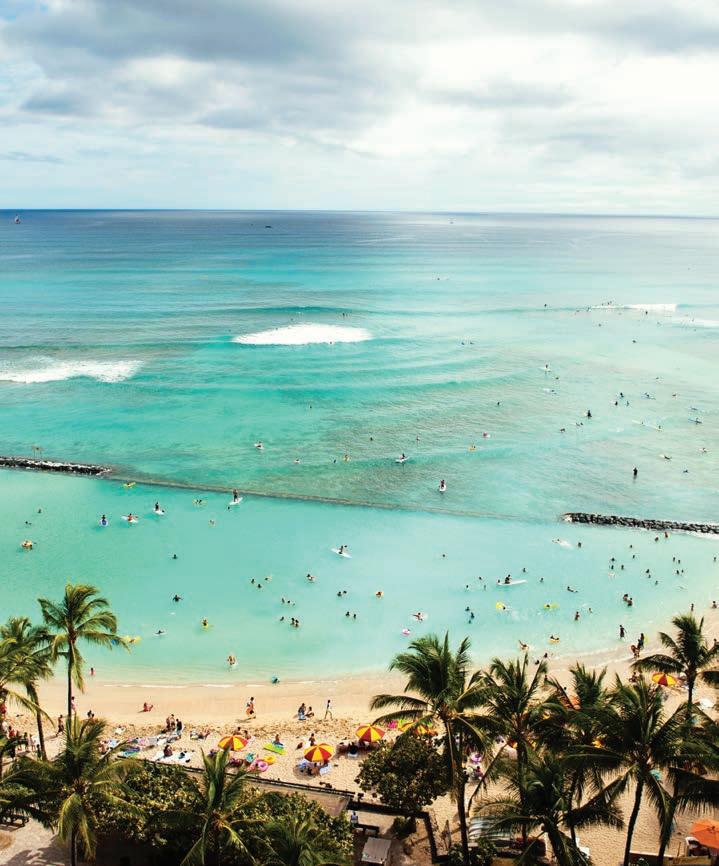
114 ISLAND BY ISLAND : O‘AHU
O‘AHU
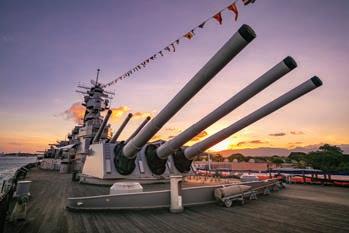

BATTLESHIP MISSOURI MEMORIAL
Arizona Memorial Place, Honolulu ussmissouri.org (808) 455-1600

Complete your Pearl Harbor Experience. The USS Missouri is no ordinary ship, this is America’s most historic battleship. Home to 2700
Sailors, nine 66-foot-long guns, 1220 projectiles and a deck big enough to host a surrender ceremony presided by General Douglas MacArthur. Shuttle service from the Pearl Harbor National Memorial visitors center included with admission.
dolefruithawaii.com
(800) 697-9100 Toll-Free (808) 847-3234 O’ahu

Bring Home a Bite of Paradise! The exotic pineapple has been associated with Hawai’i & the DOLE® brand for over 100 years. The fertile, volcanic soils of O ‘ahu are kissed with Hawaiian sunshine, warm tropical rain, and gentle tradewinds, creating the sweeter, jucier DOLE Royal Hawaiian ® Pineapple.
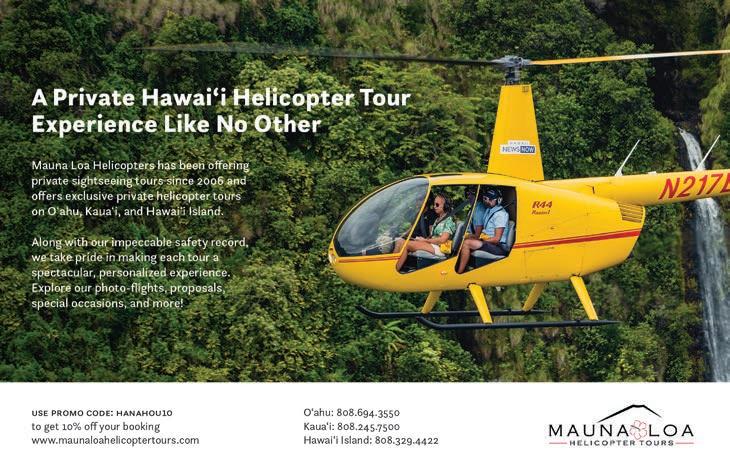
DOLE
EAT / SHOP / PLAY
PROMOTIONAL
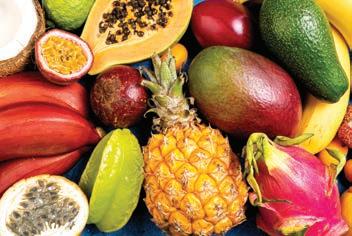
FARMLOVERS FARMERS MARKETS
Kaka‘ako, Pearlridge Center, Kailua Town, Hale‘iwa farmloversmarkets.com (808) 388-9696

Immerse yourself in local food culture at any one of our Farmers Markets. Taste the true Hawai'i. Experience our local farmers, culinary masters, and artisans. Fresh locally grown produce. Tropical Fruits and Vegetables. Come Hungry! Leave Happy. Our chefs cook healthy, island style grindz. Need a Gift? Our local artisans have you covered. Kaka ’ako (Sat), Pearlridge (Sat), Kailua Town (Sun), Hale’iwa (Thur).

NORTH SHORE SOAP FACTORY
67-106 Kealohanui Street, Waialua Sugar Mill northshoresoapfactory.com (808) 637-8400
Watch what our Master Soap Maker is working on when you visit North Shore Soap Factory! Come for the soap, stay for the stamping…customize your bar at our Stamping Station. Book a Behind-the-Scenes Tour* to see how we handcraft Hawaiian Bath & Body® soaps and skincare. Local art, gifts and more. Find us in the Big Coneshaped building!
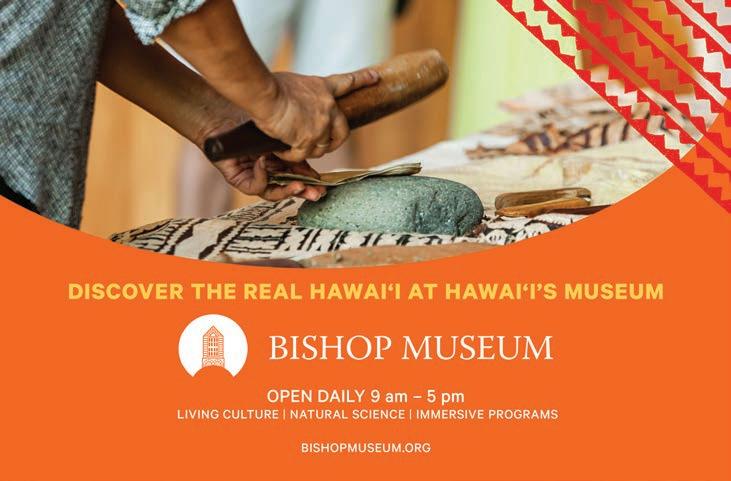
ISLAND BY ISLAND : O‘AHU
North Shore Soap Factory PROMOTIONAL

PANDORA
Ala Moana Center, Honolulu (808) 946-8001
Celebrate your favorite place. A trip of a lifetime, Hawai‘i is a true paradise. Celebrate the times you’ll never forget with our beautifully engraved Hawaii charm. Pandora jewelry gives a voice to your loves through pieces that remind you of everything you are and everything you love. Discover our full collection of bracelets, charms, earrings, necklaces and more.

RAINBOW DRIVE-IN
Kapahulu, Kalihi, Pearlridge, ’Ewa, rainbowdrivein.com (808) 737-0177
Family owned since 1961, Rainbow Drive-In is known for their generous portions of simple, hearty Hawai‘i comfort food. Stop by one of four locations for the best Loco Moco or a delicious plate lunch. After enjoying a famous Slush Float for dessert, leave with one of our famous logo with one of our exclusive logo-emblazoned merch items from the Rainbow Tiki shop.
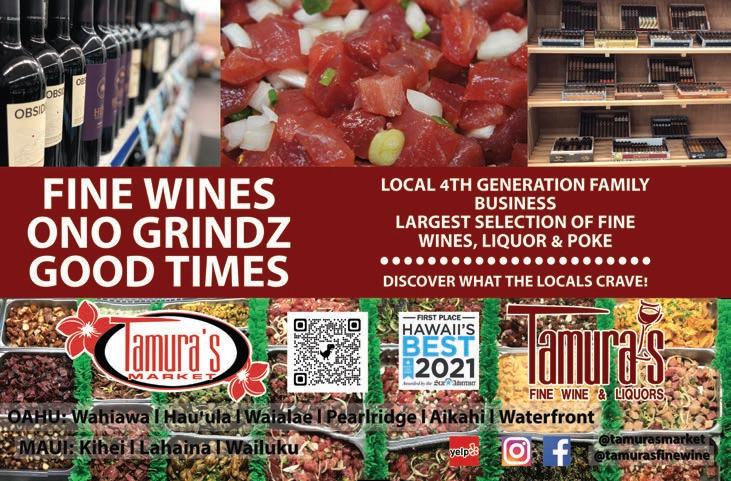
EAT / SHOP / PLAY

TRADITION COFFEE ROASTERS
905 Kalaniana’ole Hwy, #3201, Kailua TraditionCoffeeRoasters.com (808) 207-7022

Discover what makes good coffee, how to brew your best cup and bask in the smell and taste of fresh roasted coffee. Tour the Roastery, take a coffee sensory class or just come and enjoy your best cup of coffee on island! Open to the public for guided tours, free tastings, classes, retail and shopping our coffee beans and brewing supplies.
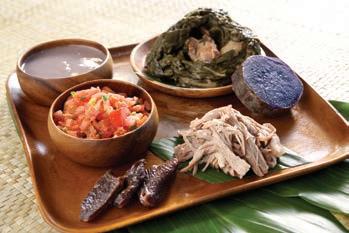
YOUNG'S FISH MARKET
Kapolei Commons, 4480 Kapolei Parkway, City Square, 1286 Kalani St, Honolulu youngsfishmarket.com (808) 841-4885
Home of the famous laulau! Young’s Fish Market has been Hawai‘i’s go-to for delicious local foods since 1951. Laulau, kalua pork, poke and more... We have everything to satisfy your Hawaiian food cravings. Want to send a taste of Hawai‘i to loved ones on the mainland? Send a Laulau Care Package delivered right to their door! Visit our website for information!

WAIMEA VALLEY
59-864 Kamehameha Hwy., Hale’iwa waimeavalley.net (808) 638-7766

Waimea Valley is a wahi pana (storied place) deeply rooted in Hawaiian culture. Today Waimea is home to six cultural sites and 5,000 unique plants from all over the world. Allow the wonders of Waimea to speak to you as you walk through this place of healing. Experience the tranquility and the sites that harken back to a bygone era in Hawai‘i’s history.
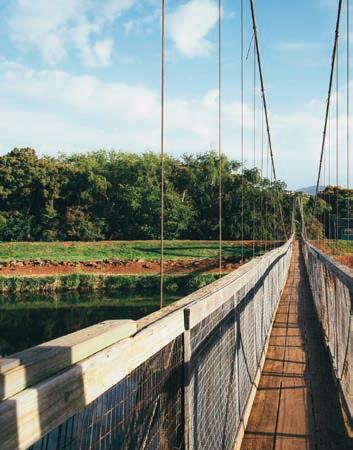
118 ISLAND BY ISLAND : O‘AHU
FISH MARKET & RESTAURANT PROMOTIONAL
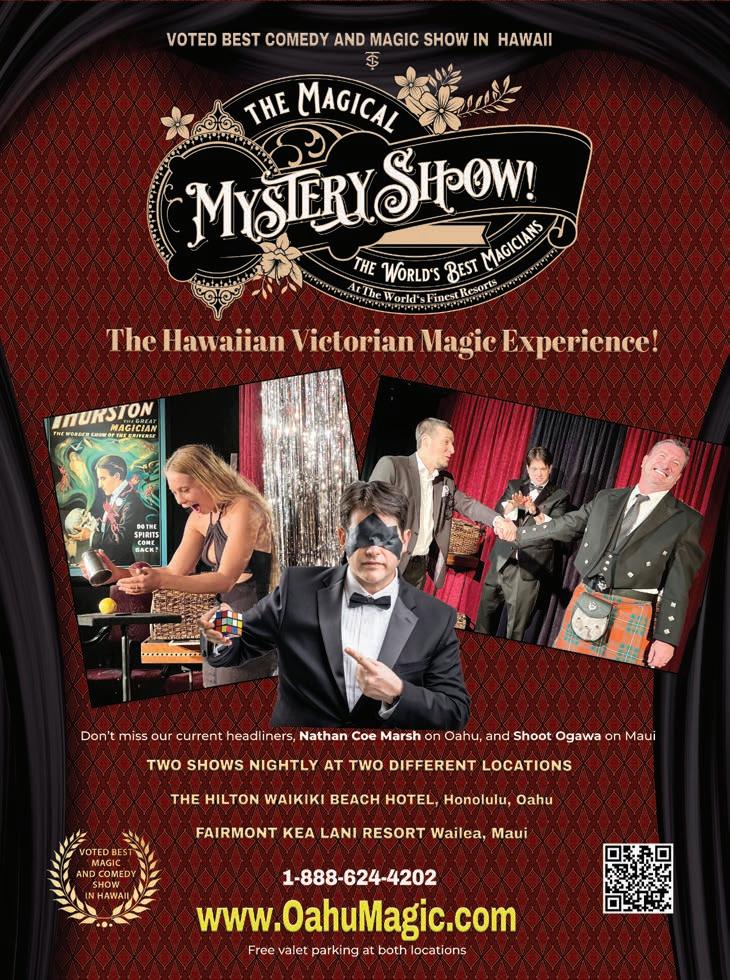

120 ISLAND BY ISLAND : HAWAI ‘ I ISLAND
HAWAI‘I ISLAND

Ā HUALOA FAMILY FARM
45-3279 Mamane Street, Honoka’a ahualoafarms.com (808) 775-1821

Stop by “The Nuthouse” and see what’s crackin'! Ā hualoa Family Farms grows, processes, and produces delicious 100% Hawaiian macadamia nuts and 100% Hamakua coffee in Historic Honoka’a town, the gateway to Waipio Valley. Come in for free samples, relax on the lanai, enjoy a cup of coffee and take home your favorite macadamia nut flavor. See you at The Nuthouse!

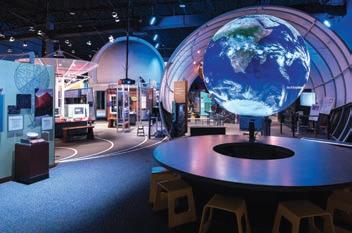
‘IMILOA ASTRONOMY CENTER
University of Hawai‘i at Hilo 600 ‘Imiloa Place, Hilo imiloahawaii.org (808) 932-8901

Visit ‘Imiloa in Hilo, Hawai‘i, and explore the science of Hawai‘i! Immerse yourself in our Planetarium and interactive Exhibit Hall and take a walk through our native Hawaiian garden landscape. We are an ideal venue for group tours, educational field trips and event hosting. Don't forget to ask about membership discounts too!
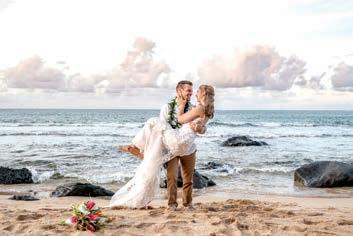
SHELLY LYNN PHOTOGRAPHY
Hawai‘i Island shellylynnphotography.com (808) 484-2759

Specializing in Weddings, Elopements, Vow Renewals & Family Portraits. Envelop yourself in love and have this skilled photographer capture the beauty of your celebration. Natural portrait and adventure photography in stunning Hawaii locations. Located on Hawai‘i Island and available to travel to all Islands. Let us craft the perfect day with photos that look and feel like your favorite memories!
121 EAT / SHOP / PLAY
PROMOTIONAL
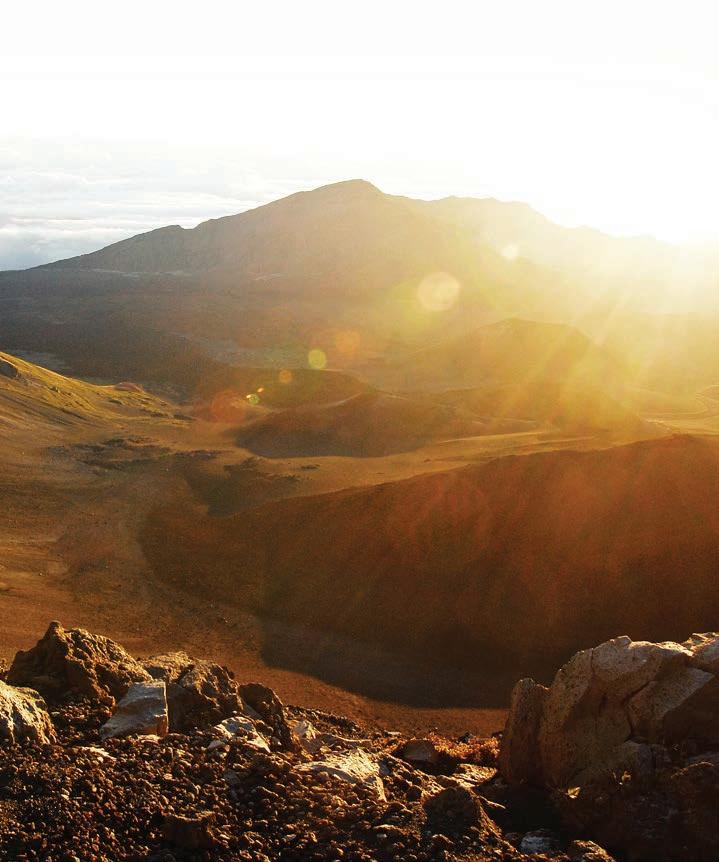
122 ISLAND BY ISLAND : MAUI
MAUI
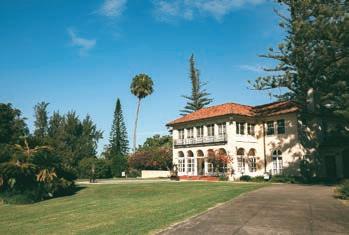
HUI NO‘EAU VISUAL ARTS CENTER
2841 Baldwin Avenue, Makawao, Maui huinoeau.com (808) 572-6560

Located in Upcountry Maui at the historic Kaluanui Estate, Hui No‘eau Visual Arts Center is a nonprofit, community arts center offering art classes, workshops, exhibitions, and events. Visitors are invited to explore the 100-year-old Kaluanui home, enjoy artwork by local artists in the gallery and gift shop, or take a self-guided tour of the scenic 25-acre grounds.
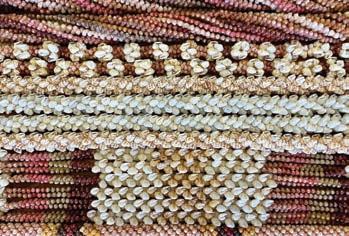
MAUI HANDS ART GALLERIES
Lahaina, Pa‘ia, Makawao, and Wailea mauihands.com @mauihands

Maui Hands is the creative efforts of 300 Hawai‘i-based artists working in every conceivable medium to bring the best of the islands to you. Each location is uniquely curated with a selection of fine and casual jewelry; original artwork and prints; ceramic, glass, and wood creations; linens and home goods; and an extensive collection of exquisite Ni‘ihau shell lei.
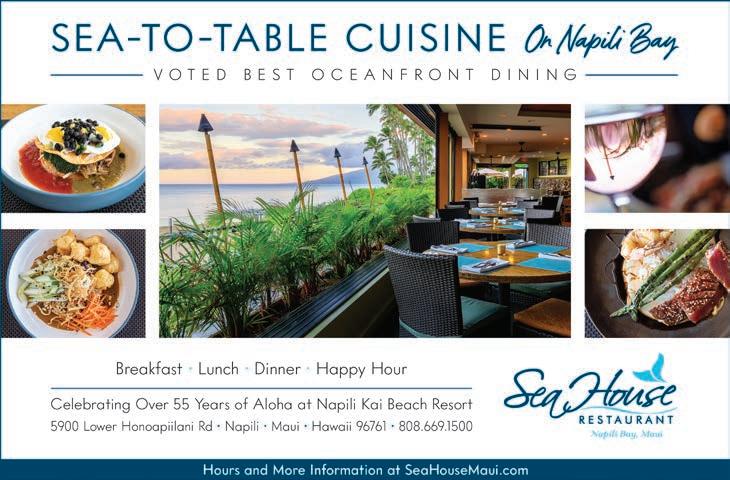
EAT / SHOP / PLAY
PROMOTIONAL
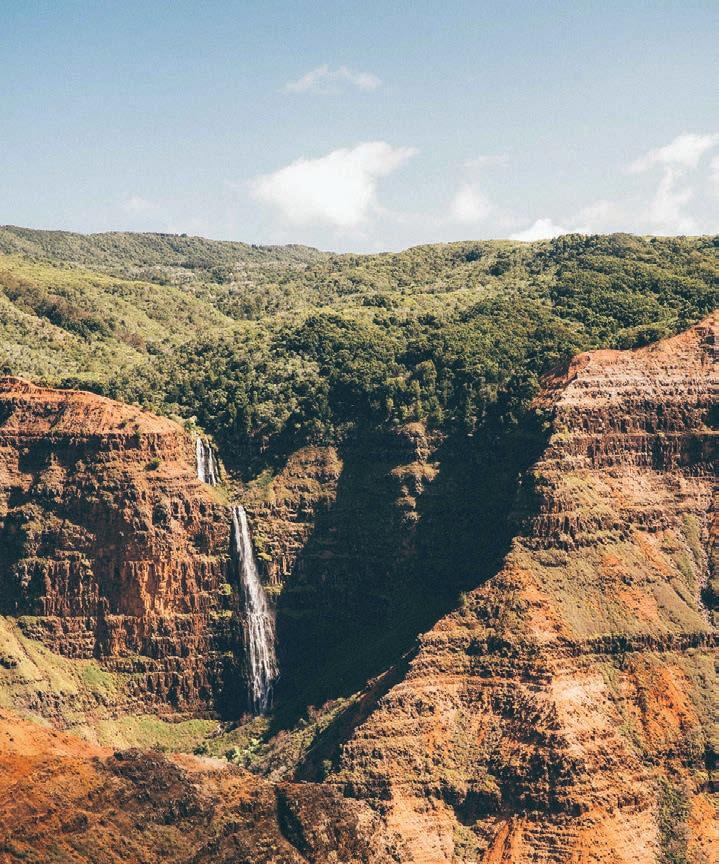
KAUA‘I 124 ISLAND BY ISLAND : KAUA ‘ I
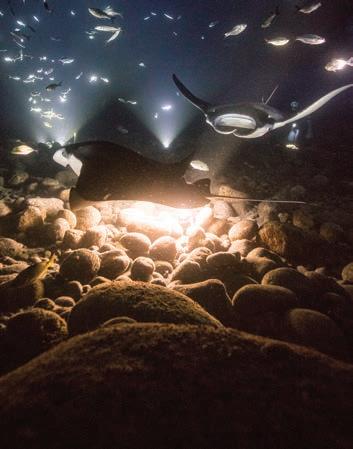

KELA'S GLASS
GALLERY
4-1400 Kuhio Highway, Kapa ‘a, Kaua ‘ i www.glass-art.com (808) 822-4527

At Kela’s Glass Gallery, it’s all about the glass art. See for yourself the stunning Color Changing Jewelry by the owner Mimi. This impressive gallery features the works of over 150 fine glass artists. Apparently the specialization works. Kela’s Glass Gallery won the prestigious Top Retailer Award from NICHE Magazine voted on by over 10,000 American artists.
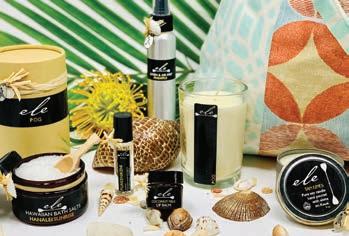
ELE KAUA‘I
@elekauai Kaua ‘ i, Oahu, Maui, Hawai ‘ i Island elekauai.com (808) 346-6020

Transport yourself to the gorgeous islands of Hawaii, all without leaving the comfort of your home! Ele Kaua‘i is passionate about creating highquality candles, air mists, body scents and bath salts that will fill your space with the aroma of the Hawaiian islands. Made by hand with aloha on the North Shore of Kaua‘i, visit their website for more information.

SALTY WAHINE GOURMET HAWAIIAN SEA SALTS
1-3529 Kaumualii Highway, Unit 2B Hanap ē p ē saltywahine.com (808) 378-4089

Salty Wahine Gourmet Hawaiian Sea Salts is a family-owned Kaua ‘ i Made Company that specializes in Kosher Hawaiian Sea salts, seasonings, and tropical sugars using fruit infusions like mango, coconut, guava, passionfruit, dragonfruit, and pineapple. All products are made by hand with Aloha in our Salty Wahine commercial kitchen/factory in Hanap ē p ē , Kaua ‘ i. Salty Wahine’s goal is “making eating healthy and fun”.
125 EAT / SHOP / PLAY
PROMOTIONAL

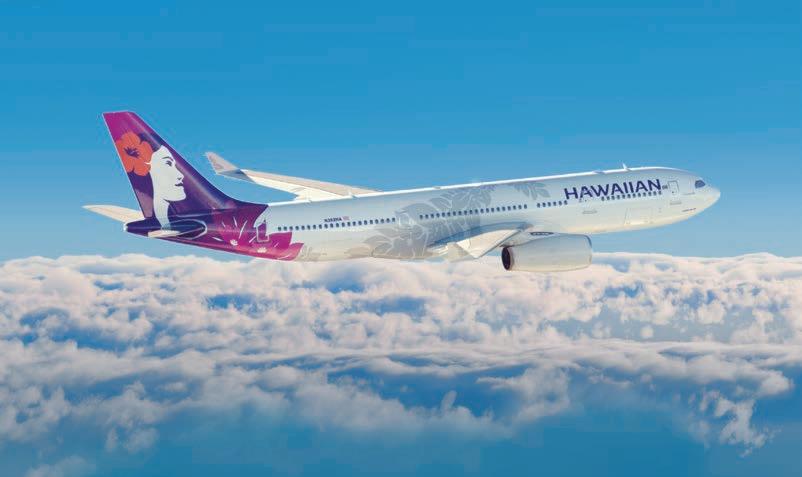
Aloha
Welcome aboard
luana i ka lele ‘ana. E lawelawe mākou iā ‘oe me ka ha‘aha‘a.
In Hawaiian culture, mea ho‘okipa means "I am your host." This phrase expresses the spirit of hospitality you'll find on our flights, whether you're traveling to the Neighbor Islands, between Hawai‘i and North America or within the Asia-Pacific region. If there is anything that we can do to make your flight more enjoyable, please don't hesitate to let us know.
128 / In-Flight Meals
129 / Streaming Entertainment on A321neo Aircraft
130 / In-Flight Snacks, Souvenirs and Beverages
132 / Terminal Maps
134 / HawaiianMiles Partners
136 / Route Map
138 / The ‘Ohana Pages
E
ALOHA FROM HAWAIIAN AIRLINES 127
In-Flight Tastes of Hawai‘i
Delicious Complimentary Meals
It’s true. We’re one of the only airlines left in the country to serve you a complimentary meal at mealtime in the Main Cabin. You’ll find Hawai‘i-inspired meals on select flights to and from Hawai‘i, always served with our unique brand of Hawaiian hospitality.
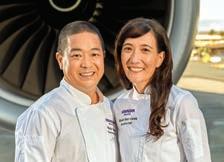
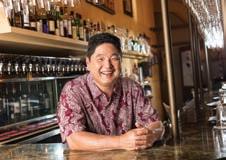
Above top: Wade Ueoka and Michelle Karr-Ueoka
Bottom: Chuck Furuya
Left to right: Chef Eric Oto of Hoku's at the Kahala Resort and Spa, Chef Robynne Maii of Fete Hawaii, Chef Dell Valdez of Vein at Kaka‘ako, Executive Chefs Wade Ueoka and Michelle Karr-Ueoka of MW Restaurant, Chef Chris Kajioka of Miro Kaimuki and Chef Jason Yamaguchi of Mugen Waikiki.
Hawaiian Airlines Featured Chef Series showcases star chefs
Hawaiian Airlines’ in-flight service shares the sights, sounds and tastes of Hawai‘i, and when it comes to our First Class meal service, that means exciting, varied Pacific Rim cuisine with our Featured Chef Series. This esteemed collaboration showcases some of Hawai‘i’s most dynamic chefs creating menus for meals served in our forward cabin.
The Featured Chef Series is overseen by Hawaiian Airlines Executive Chefs Wade Ueoka and Michelle Karr-Ueoka.
Sit back and enjoy Hawai‘i’s vibrant food culture and our distinct onboard experience.
A taste of tradition
Executive Chefs Wade Ueoka and Michelle Karr-Ueoka opened MW Restaurant in Honolulu in 2013. Their cuisine combines inspirations from travels around the world with Hawai‘i’s culinary traditions and local bounty. To sample MW’s latest creations visit their new location at 888 Kapi‘olani Boulevard in Honolulu.
MWRestaurant.com
Wine pairings by our Master Sommelier
Chuck Furuya has a passion for the world’s oldest fermented beverage and holds the distinction of becoming only the tenth person in the United States to pass the rigorous Master Sommelier examination, in 1988. You can find Chuck at Chuck Furuya Uncorked on YouTube.

HO‘OKIPA
128
In-Flight Entertainment on A321neo Aircraft
Streaming Entertainment to Personal Devices
Guests on our new A321neo aircraft are able to stream complimentary inflight entertainment on their personal electronic devices. We offer a wide selection of movies, TV shows and music as well as Hawaiian Airlines’ own exclusive programming.
Viewing on Smartphone or Tablets (Apple iOS or Android only)*
1. To enjoy all the movies and TV selections you must download the Hawaiian Airlines app.
2. Once onboard:
• Switch to Airplane Mode
• Connect to the wifi network “HawaiianAirWifi”
3. After connecting to wifi network, open Hawaiian Airlines app:
• Select More
• Select In-Flight Entertainment
Note: For iOS users, Select “Ok” when prompted to connect your device to Hawaiian Airlines local network. Supported on iOS 12.5 or higher, and on Android 8.0 or higher.
Viewing on a Laptop
1. Connect to wifi signal "HawaiianAirWiFi"
2. Open one of the supported browsers— Google Chrome (ver. 58+), Apple Safari, or Firefox (ver. 69+)—and type in URL: HawaiianAirlinesWiFi.com
*Available only on A330 and A321neo aircraft.
3. Choose from the menu of entertainment selections and enjoy!
4. Please note: Internet Explorer and Edge browsers are not supported browsers at this time. Supported computer operating systems include MacOS X 10.10-10.14 or Windows 7-10 (Windows 8 must be in desktop mode.)
Having trouble accessing the entertainment? Try these general troubleshooting steps:
1. Is your WiFi signal on? Double-check device settings to ensure airplane mode is on but WiFi is available.
2. Ensure you are connected to the WiFi network: HawaiianAirWiFi. You may need to disconnect and reconnect to wifi network to re-establish secure connection.
3. On a mobile device, make sure you are using the latest version of the Hawaiian Airlines app.
4. It may be helpful to close and relaunch the Hawaiian Airlines app after connecting to WiFi network.
Mele
Collections to suit your musical tastes
Hawaiian Airlines offers DJ-hosted, curated audio programming devoted to musical styles from across the globe, ranging from award-winning Hawaiian music to jazz and K-Pop.*
FEATURED CHANNELS INCLUDE:
Island Favorites
From the latest songs to all-time classics, Island Favorites presents the best of Hawaiian musicians, including Ei Nei, Maunalua and others.
Classic Jawaiian Rhythms
The melding of Hawaiian melodies and Jamaican rhythms creates a uniquely Island groove, with artists Henry Kapono, Butch Helemano, Maoli and more.
Slack Key Serenity
Stephen Inglis, Kapono Beamer and other kī ho‘alu guitar masters present varied interpretations of the Hawai‘i-born slack key style.
‘Ukulele Wizards
A celebration of Hawai‘i’s iconic instrument, featuring Bryan Tolentino, Jesse Kalima and Kimo Hussey.
These and more special audio programs can be found in the Radio category available in our onboard in-flight entertainment systems.


129 HO‘OKIPA
Kapono (left) and Stephen Inglis (right).
In-Flight
Snacks and Souvenirs
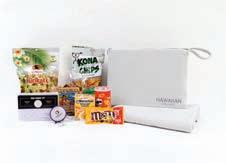
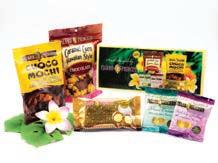
in Hawai‘i Snack Sampler

Pau Hana Snack Cart
Blanket and pillow set, popular local snacks, souvenirs and sundries are available from the Pau Hana Snack Cart. Cabin crew will advise when the cart is heading down the aisle on domestic flights or is open in the galley on Australia and New Zealand flights.
Selections and quantities are limited and may vary. To print receipts of in-flight purchases, visit HawaiianAirlines.com/receipts.
Popular Local Snacks
Mananalu Water in Aluminum Bottle, 16 oz.**
Hawaiian Chip Company Taro and Sweet Potato Chips
Island Princess Caramel Macadamia Nut Popcorn
Kona Chips Furikake Chips
Samurai Furikake Popcorn
Snack Packs*
Made in Hawai‘i Snack Sampler K
Choco Caramel Popcorn, Choco Mochi, Lightly Salted and Maui Onion Macadamia Nuts, Mele Mac
Classic Snack Box GF Crackers, Cookie, Chickpeas, Turkey Stick, Hummus, Gummies
Keiki (Child) Snack Box GF Cheese Puffs, Granola Minis, Turkey Stick, Applesauce, Gummies, Cookie
‘Ono Snack Box GF Salami, Cheese Spread, Dried Fruit, Olives, Crackers, Cookie
Cheese Tray with Crackers and Dried Fruit
Classic Snacks
M & M's Peanut
Maruchan Cup Ramen Chicken
Pringles K
Sundries
Ear Buds with Hawaiian Airlines Zipper Case**
Hawaiian Airlines Blanket and Pillow Set** $3.50
130 HO‘OKIPA
$7.50 $10.00 $8.00 $8.00 $8.00 $7.00 $3.50 $4.00 $4.00 $4.00 $10.00 * Snack box components are subject to availability. Please see snack box for list of included items. ** Available on select North America flights only. GF Gluten-Free K Kosher
$8.00 $6.00 $8.50
Made
‘Ono Snack Box
In-Flight Beverages
Juices
Passion-Orange-Guava* (POG)
Pineapple I Apple I Orange
Mott’s Tomato I
Mr. & Mrs. T Bloody Mary Mix
Hot beverages
Lion Coffee* I Tea
Soft drinks
Coke / Diet Coke I Sprite / Sprite Zero
Canada Dry Ginger Ale
Milk (Lowfat or Whole)
Club Soda / Tonic Water / Sparkling Water
Spirits
Rum (Koloa Rum)
Vodka (Ocean)
Scotch (Dewars)
Bourbon (Jack Daniel’s)
Gin (Tanqueray)
Hard Seltzer Dragon Fruit** (Maui Brewing Co.)
Koloa Breeze Rum Punch*** (Koloa Rum)
On The Rocks (OTR)
Signature Mai Tai**
Signature Moloka‘i Mule**
Signature Tropical Landing**
Wines & Champagne
Sparkling Wine Split
Red Wine Split**
Red Wine Half Bottle
White Wine Split**
White Wine Half Bottle
$9.50
$8.00
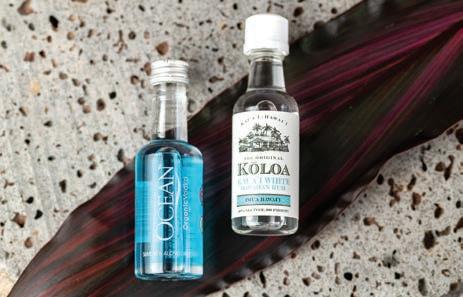
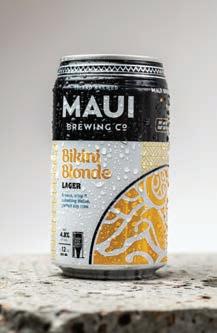
Complimentary beverages provided by
* Complimentary on Neighbor Island flights.
** Available for purchase on Neighbor Island flights.
***Complimentary glass on flights to/from Hawai‘i and West Coast North American cities. $6 per glass thereafter.
All beer, wine, champagne and spirits available for purchase on North American flights. Complimentary in First/Business Class.
Alcoholic Beverages
Only alcoholic beverages provided by Hawaiian Airlines and served by Flight Attendants may be consumed on board the aircraft. No alcoholic beverages will be served to persons who appear intoxicated or to those under 21 years of age.
Hawaiian Airlines' complimentary items may change or vary from time to time, and availability can be affected by aircraft schedule changes.
Beverage menu is subject to change. Some items may not be available on all flights and/or classes of service. Beverage availability is limited. Beers, wines, spirits, snacks and sundries are available for purchase with major credit/debit cards only.
131 HO‘OKIPA
$8.00 $8.50 $8.50 $8.50 $6.00 $8.00 $8.00 $8.00
$8.00 $8.50
Beers Heineken**
$16.00 $8.00 $16.00
Bikini
Blonde Lager** (Maui Brewing Co.) $8.50 $8.50



E10 E11 E12 E9 E8 E7 E6 E5 E4 To Gates E1-E3 and Terminal C JetBlue codeshare flights are located in Terminal C B OS I Bo st on Loga n In t erna t io n al Airp o r t Hawaiian Airlines flights use Terminal E 23 D22 D21 D20 D8 D10 D11 D12 14 D56 D57 D58 D D42 D43 D39 D
132
Tram To Terminal 1
L AX I
1. Collect baggage, if necessary, and proceed to Customs clearance.
Check-in at the JAL Domestic Connection Counter on Level 2 .
Proceed through the domestic transfer security inspection area. 4. Take the escalator down to the JAL Domestic Transfers bus stop. Exit the bus at Domestic Terminal 1.
• If you HAVE NOT checked in to your final destination at your departure airport, go to the International Transfers Counter just before Immigration.
• All travelers must go to the Security Inspection Area (entrance next to the Transfers Counter) before heading to Departures on Level 3.
• Guests on JetBlue codeshare flights will need to transfer from Terminal B to Terminal 5.
• Please follow the dotted-lined pathway as shown in the map above (minimum 30 minute walk).
Tok yo N ari t a In t e rn ati o nal Ai r p or t TERMINAL 4 Gates 40-49 TERMINAL 5 Gates 50-59 Tunnel Level Tunnel Level 210 (A/B) 208 207 205 203 206 204 202 221 225
NRT I
Hawaiian
209 (A/B) 201 (A/B) Gates 201-225 Third Floor TERMINAL 4
UPPER LEVEL TERMINAL B Gates 130-225
Baggage
to TERMINAL
Basement Level
Airlines flights use Gates 201-225.
Connector
Check-In Third Floor
Claim First Floor
6
Los A n gele s In t e rn ati o nal Ai r p or t 114 148 147 146 145 144 143 142 141 113 112 110 111 109 108 Gates 105 -107 HND
Tok yo Ha n ed a In t erna t io n al Airpo r t INTERNATIONAL TO DOMESTIC
2.
INTERNATIONAL
INTERNATIONAL
I
3.
TO
For
transfers,
visit HawaiianAirlines.com INTERNATIONAL TERMINAL 3 75 76 77 82 92 94 96 84 86 88 87 85 83 81 91 93 95 97 99 98 74 73 72 71 61 62 63 64 65 66 67 68 TERMINAL 3 TERMINAL 2 TERMINAL MAPS 133 Fourth Floor
more information regarding
please


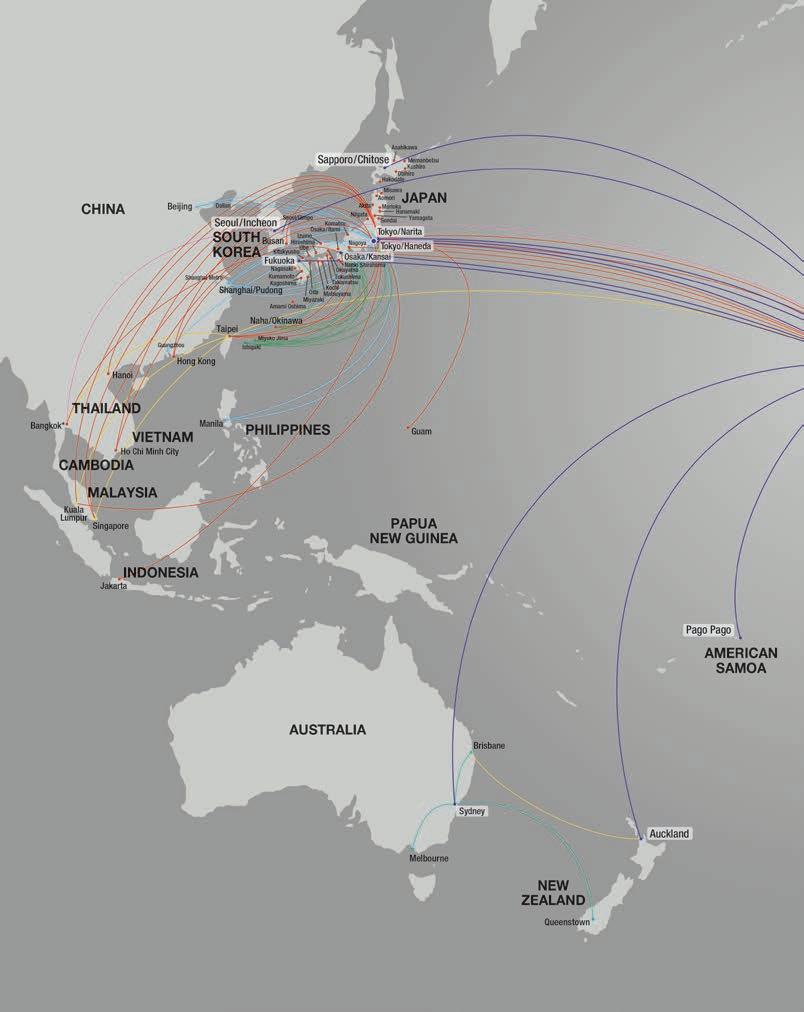
HAWAIIAN AIRLINES ROUTE MAP 136
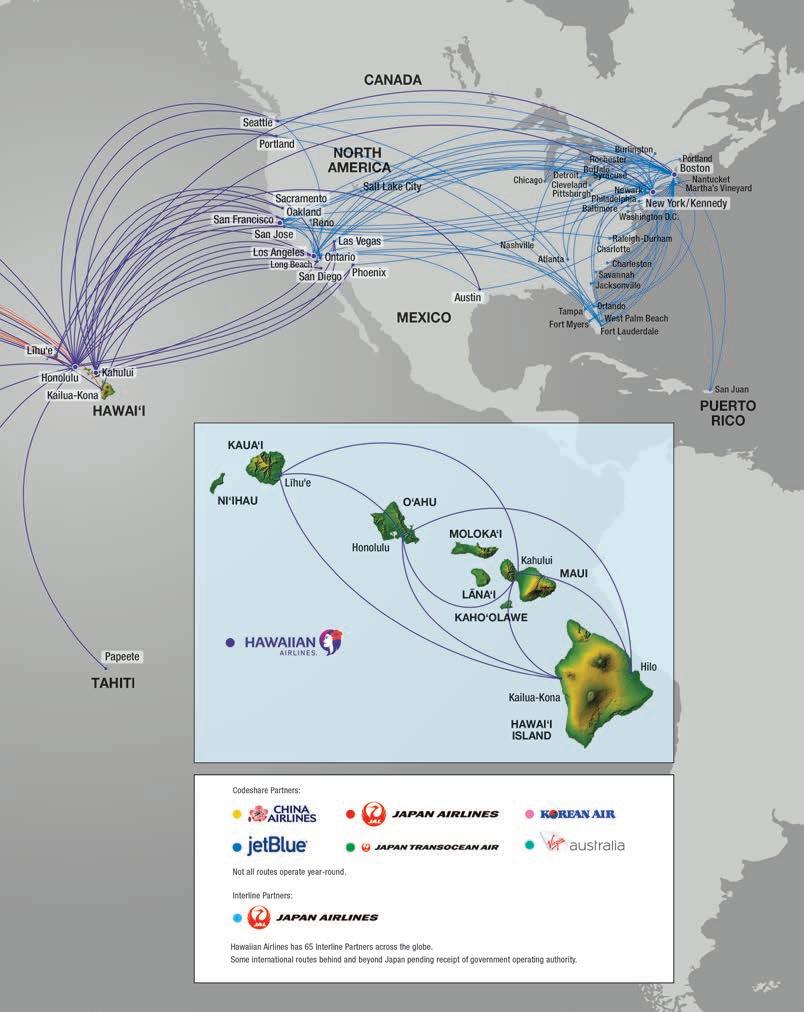
137

Future Flyers
As Hawai‘i’s hometown carrier—and one of the largest employers in the Islands—Hawaiian Airlines is committed to fostering the next generation of aerospace professionals. In July, more than thirty of our employees teamed up with the nonprofit Organization of Black Aerospace Professionals (OBAP) to host a group of local middle- and high school students enrolled in OBAP’s annual Aerospace Career Education (ACE) Academy. Over the course of the day, participants experienced virtually every aspect of our industry.
The ACE students began their day at our corporate headquarters where chief
operating officer Jon Snook shared his own history and gave an overview of our worldwide operations. Employee volunteers then escorted the group to various work areas, including our pilot and flight attendant training facility where our pilots welcomed students into our new Boeing 787-9 Dreamliner simulator. The students then took the controls to experience firsthand various flight scenarios.
Our maintenance and cargo teams then led the students through our state-ofthe-art facility, detailing what goes into maintaining an aircraft and transporting freight. Students also toured our avionics
shop and saw one of our twenty-four Airbus A330 aircraft undergoing regular maintenance before boarding the widebody plane to explore its cabin features.
ACE Academy Director Randall Rochon, a United Airlines Boeing 737 captain, was among the OBAP members hosting the Academy’s week-long introduction to Hawai‘i’s various aerospace operators. “You’ll walk through the airport, or you see somebody on television and be like, ‘Oh, that’s a CEO, I’ll never do that.’ Or ‘That’s a pilot, I’ll never be a pilot,’” he said. “But yes, you can! You can do everything you want—the question we want to help answer is ‘How do I get started?’”
HAPPENINGS AT HAWAIIAN AIRLINES
Pages 138
The ‘Ohana
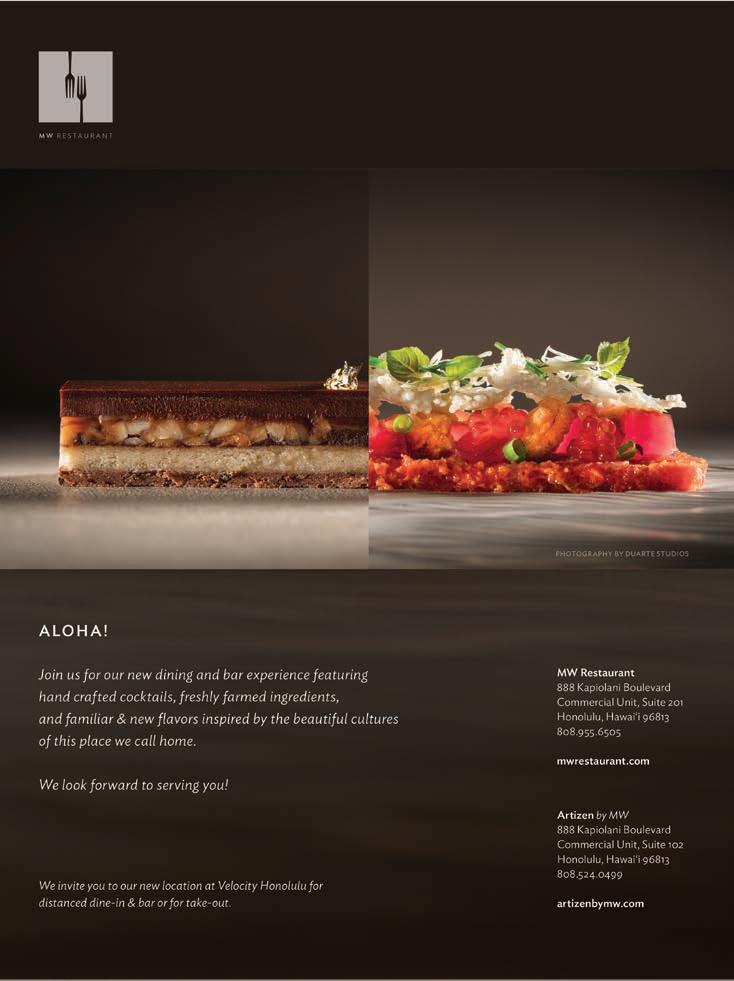
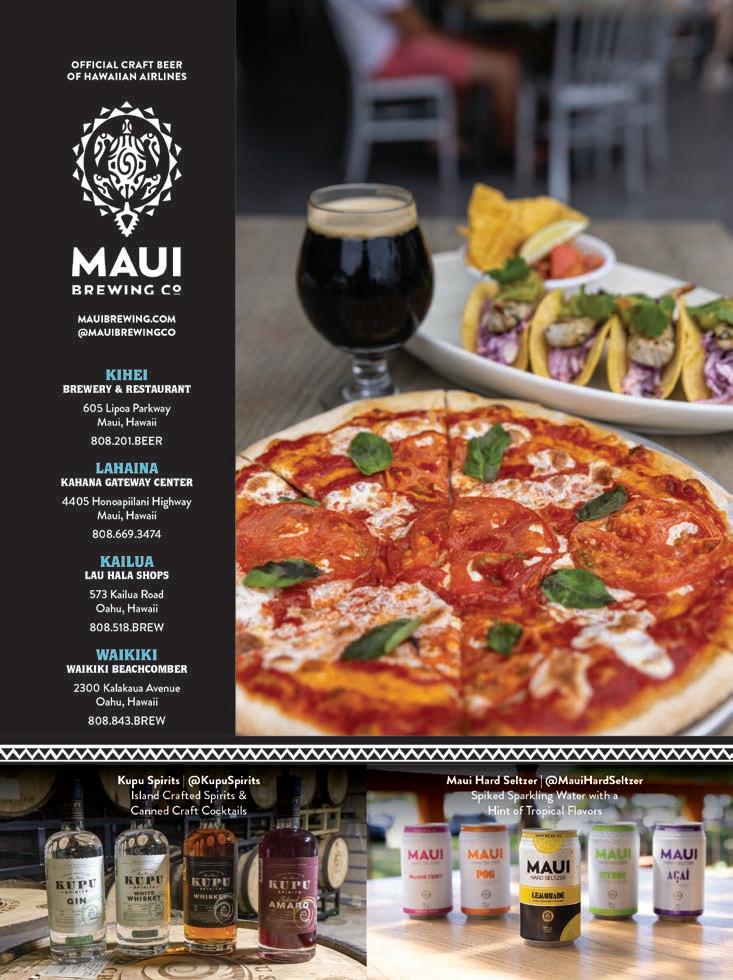
Rainbow Runway Challenge
October is National Pride Month, and Hawaiian Airlines is the presenting sponsor and official airline of Honolulu Pride, which is returning as an in-person celebration for the first time since 2019. In June, we tapped Hawai‘i-born dance celebrity Mark Kanemura to kick off our #RainbowRunwayChallenge with a vibrant celebration of inclusivity and aloha. Coinciding with the debut of the airline’s new TikTok channel, the challenge encouraged followers to create their own video short for a chance to win 160,000 HawaiianMiles, a five-night stay at the Royal Hawaiian Resort and a seat beside Kanemura as the guest of honor on Hawaiian’s Rainbow Runway float during the October 15 Honolulu Pride Parade and Festival.
“Dance is a universal language that can break barriers, and the #RainbowRunwayChallenge represents an opportunity for people to express themselves in a fun way,” said Kanemura. “This video is all about self-expression and pride, and during the filming I was reminded how proud I am to be from this special place and to be a part of this beautiful community.”
The 2022 Honolulu Pride Parade and Festival will kick off on October 1 with events throughout the month. Visit hawaiilgbtlegacyfoundation.com for more on the festival, and find our TikTok channel at tiktok.com/@hawaiianair.
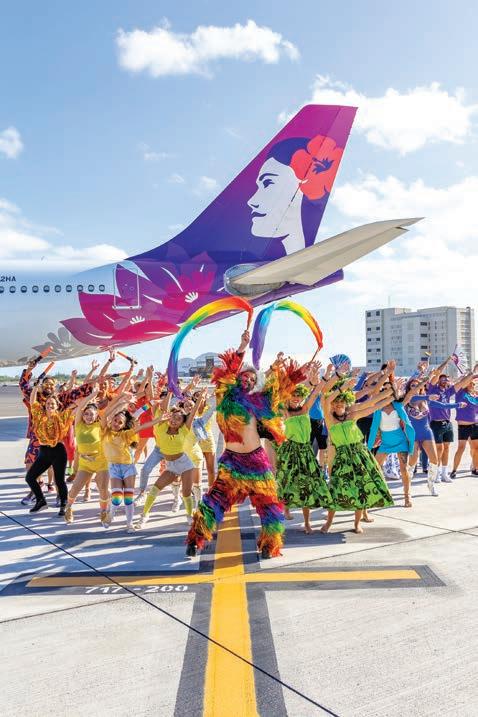
HAPPENINGS AT HAWAIIAN AIRLINES
141
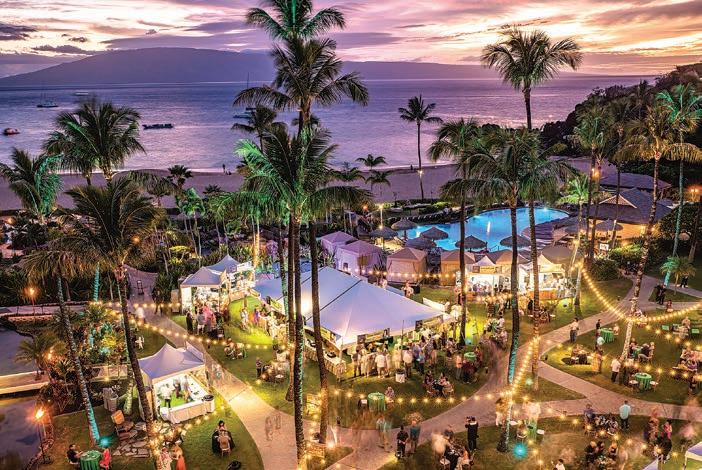
Festive Season
Throughout each year Hawaiian Airlines plays a major role in sponsoring a wide variety of events. In November, we’ll be taking part in three festive occasions that help usher in the holiday season. The Hawai‘i Food and Wine Festival takes place on Maui, O‘ahu and Hawai‘i Island in late October and early November. On November 4, we’re sponsoring “On Cloud Wine” at the Hawaii Convention Center, which pairs twenty-two vintners with twenty chefs for an evening of fine food and wine. The same weekend, on November 4 and 5, The Hawaiian Airlines Made in Maui County Festival will be held at the Maui Arts and Cultural Center in Kahului. One week later, we are serving as the official airline for the Made in Hawai‘i Festival, which runs from November 11 through 13 at the Ala Moana Center. Both the Maui and
O‘ahu festivals feature local businesses and products that comply with the state law that requires that “… at least fiftyone percent of the wholesale value of the consumer commodity is added by manufacture, processing, or production within the State.”
For information on The Hawai‘i Food and Wine Festival, see hawaiifoodandwinefestival.com; for the Hawaiian Airlines Made in Maui County Festival, visit madeinmauicountyfestival. com and for the Made in Hawai‘i Festival, go to madeinhawaiifestival.com.
Travel Light
Hawaiian Airlines is now partnering with Conservation International to keep forests standing by offering travelers the option to measure and offset their flight-related carbon emissions. Guests booking travel
on any of our flights can enter their origin and destination on a carbon calculator— including multiple legs and travelers—to determine the emissions of their itinerary. They can then choose to balance out their impact by contributing to forest carbon projects that reduce deforestation, the second leading cause of climate change. “Following our pledge last year to achieve net-zero carbon emissions by 2050, we wanted to also give our guests—visitors to Hawai‘i as well as island residents— the opportunity to reduce the impact of their individual emissions when traveling with us,” said Alanna James, managing director of sustainability initiatives at Hawaiian Airlines. “Conservation International offers a simple and meaningful way for travelers to support climate action and we are delighted to welcome them onboard as partners in minimizing our environmental impact.”
142
HAPPENINGS AT HAWAIIAN AIRLINES
 STORY BY LARRY LIEBERMAN
PHOTO BY ERIKA RICH
STORY BY LARRY LIEBERMAN
PHOTO BY ERIKA RICH
Where the Streets Have Long Names
Sitting on a front porch in the summer breeze, you might feel grateful to live on Keanahalululu Lane.
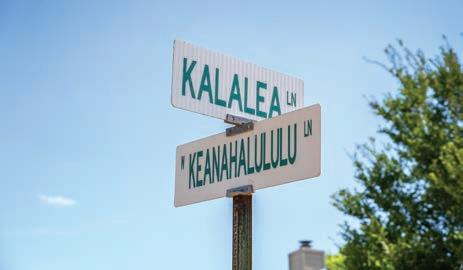
The street is close to the water and just down the road from an eighteen-hole golf course. Sure, it might be hard to pronounce, and you’d quickly give up on trying to share the address without spelling it out—but the neighborhood is quiet and the neighbors are friendly. Perhaps the most surprising thing about Keanahalululu Lane isn’t that it’s borrowed from Keanahalululu Gulch, which is apparently a surveyor’s misspelling of Keanahalulu, a cave on Hawai‘i Island. It’s that it’s not in Hawai‘i at all.
Keanahalululu Lane and its neighboring streets—like Waipahoehoe Drive, Kaukonahua Lane and Waikiakaaua Drive—are in Bastrop, a Texas town on the Colorado River. Adding to the geographical confusion, they’re part of a planned community built in the 1970s called “Tahitian Village.” In the fast-growing town of Bastrop, this legacy subdivision sports more than two hundred streets with Hawaiian names. With some as long as seven syllables, the developers definitely went big, even for Texas.
“It all started when my dad went to Hawai‘i for a golfing vacation,” says Michael Marlowe, son of the late Robert
Marlowe, who was an engineer and land surveyor for a real estate development group whose members included former Motion Picture Association of America president Jack Valenti. One of Marlowe’s tasks was planning and naming the roads on a swath of former ranchland thirty miles southeast of Austin. “Dad came home with Hawaiian maps and guidebooks and dictionaries. He was really into it, and loved the Islands.”
Marlowe wanted to create a golf resort community along the Colorado River with a relaxed atmosphere similar to what he’d experienced in Hawai‘i. “I remember all of us sitting at the dining room table as he walked through the developer’s map, figuring where the streets would go and what he could call them.” A half-century later, residents of Tahitian Village (as it was later named, likely by “someone in marketing,” says Michael Marlowe) number in the thousands.
With the exception of a few quintessential American classics like Riverside Drive and Lover’s Lane, the winding roads of Tahitian Village read like a Hawai‘i street map. Some residents, like those living on Diamond Head Drive or Puna Lane, got off easy.
Others, like those living on Mokuauia or Kaohikaipu, not so much. But they take it in stride and don’t expect folks—including themselves—to spell or pronounce the names correctly. To complicate matters, the street signs in Tahitian Village don’t include the ‘okina, the mark for the glottal stop that gives people unfamiliar with ‘ōlelo Hawai‘i (Hawaiian language) a little help navigating long words.
The difficulty of the Hawaiian names hasn’t put a damper on growth in Tahitian Village, where the relaxed lifestyle is in demand. “Houses have been springing up fast on empty lots that some people from out of town just bought up sight unseen,” says Jessica Zamora, who’s lived on Koele Court for around three years. She knows plenty of new residents who struggle with pronunciation as well as some who’ve lived in the neighborhood for decades and still don’t even try. “Koele’s not too hard compared to some of the longer names,” Zamora admits. “But I still lose mail. I have to remind FedEx so they don’t deliver to Koali across town by mistake instead of Koele. If my regular driver’s on vacation, I don’t get my packages.”
Challenging names and confusion among similar-sounding streets like Upola and Upolu or Kukui and Kuikui have caused headaches for emergency responders and GPS systems for years (just go for a drive and listen to Google Maps’ voice assistant tie itself in knots). A handful of street names have had to be changed to mitigate navigation problems, but most of the people in Tahitian Village appreciate the uniqueness of their community and like the street names just the way they are.
“I love it here,” Zamora says. “It’s beautiful and peaceful. But when I have to give directions or tell someone my address, I just usually say, ‘Go to the Colorado River Refuge sign next to the river and take a right.’” hh
PAU HANA
144
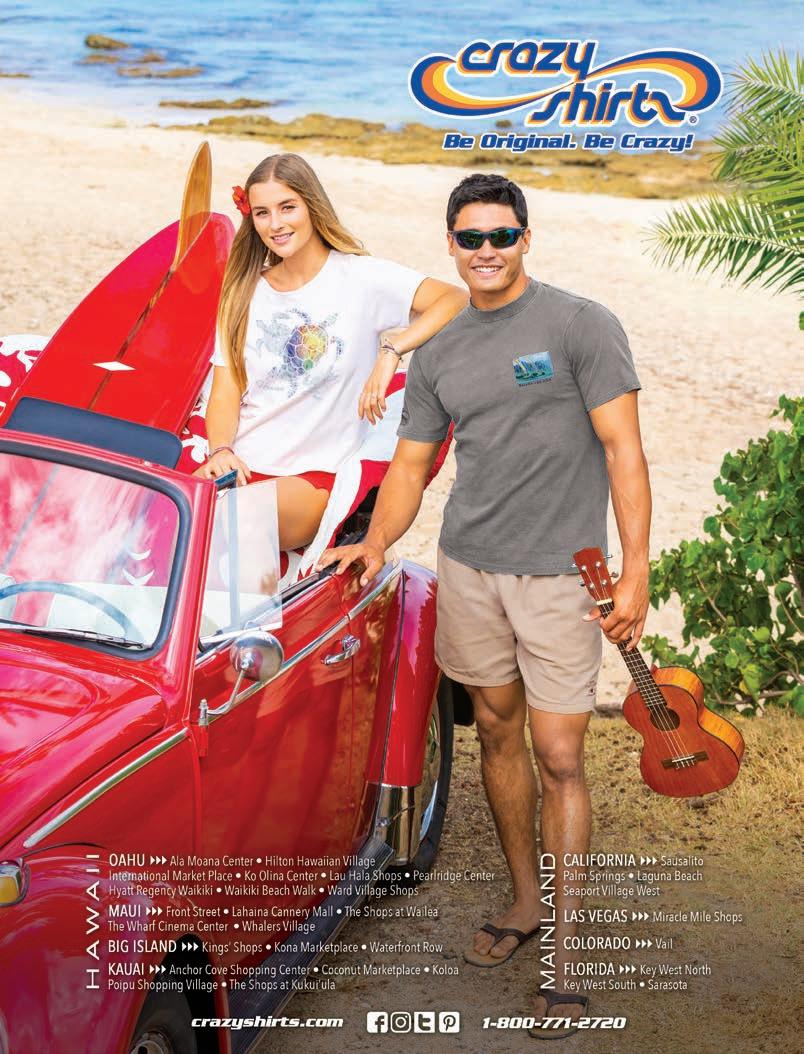
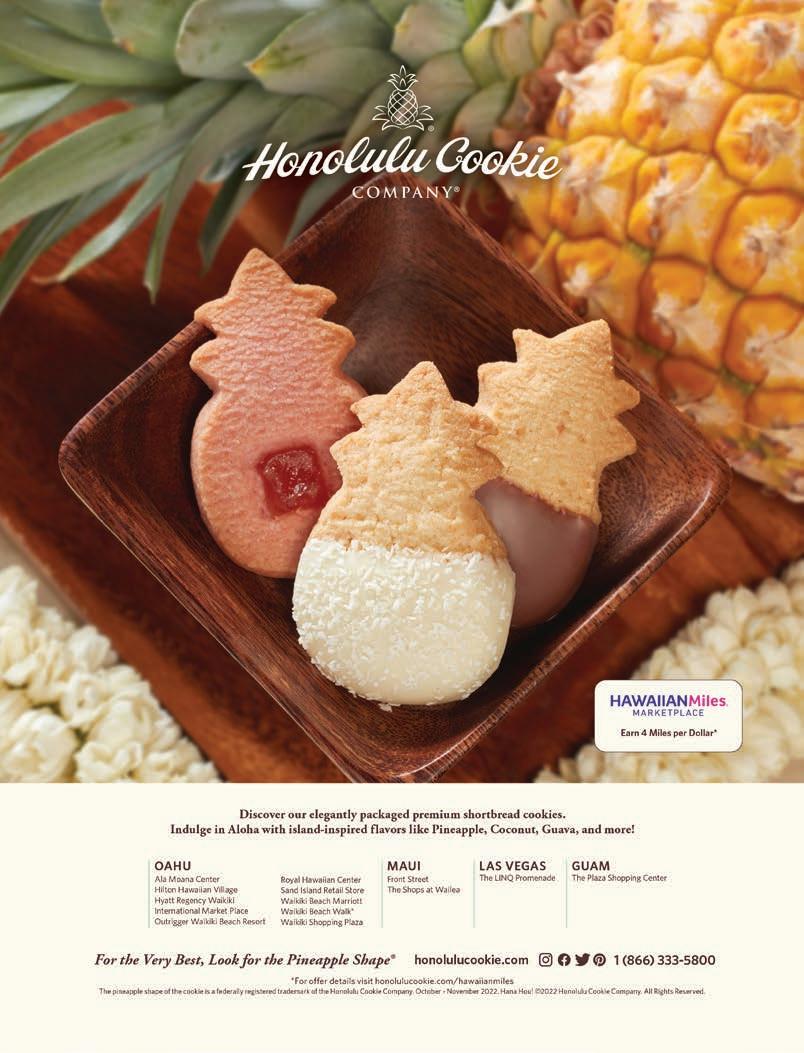









 MEKIA’S MARTIN / Learn how the most popular acoustic guitar style in the world—the Martin Dreadnought—traces its roots to early twentieth-century Hawaiian music.
PHOTO BY MEGAN SPELMAN
PHOTO BY AMANDA BEENEN CANTOR
ALOHA GOES BOTH WAYS / A video series exploring locals who embody the aloha spirit both at home and afar.
MEKIA’S MARTIN / Learn how the most popular acoustic guitar style in the world—the Martin Dreadnought—traces its roots to early twentieth-century Hawaiian music.
PHOTO BY MEGAN SPELMAN
PHOTO BY AMANDA BEENEN CANTOR
ALOHA GOES BOTH WAYS / A video series exploring locals who embody the aloha spirit both at home and afar.

















 STORY BY DEREK FERRAR
BY DANA EDMUNDS
STORY BY DEREK FERRAR
BY DANA EDMUNDS











































































 Skater-surfer Billy Fortier slides between light and shadow cast by the last rays of sun at a private pool on the North Shore.
Skater-surfer Billy Fortier slides between light and shadow cast by the last rays of sun at a private pool on the North Shore.






















 BY MIKE RODRIGUEZ
BY MIKE RODRIGUEZ













































































 STORY BY LARRY LIEBERMAN
PHOTO BY ERIKA RICH
STORY BY LARRY LIEBERMAN
PHOTO BY ERIKA RICH


